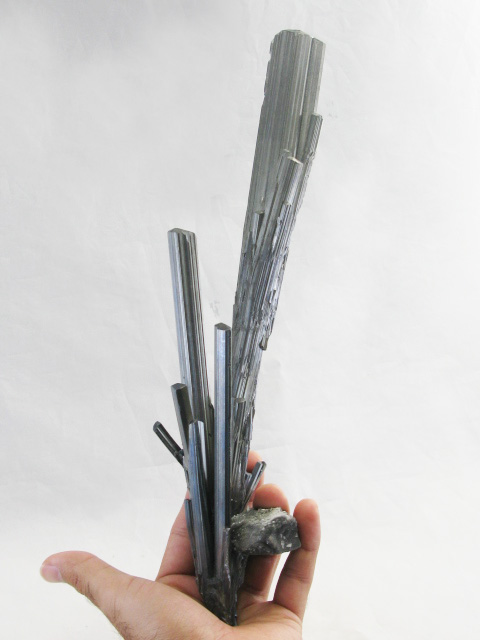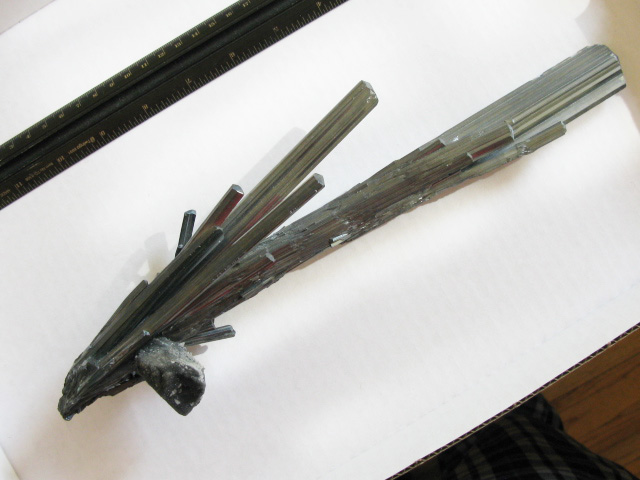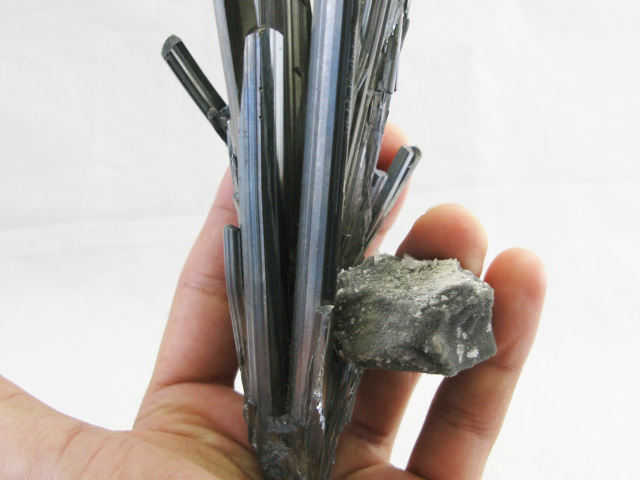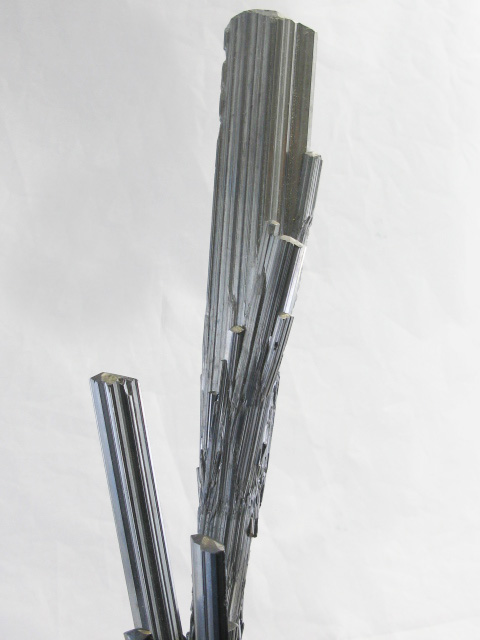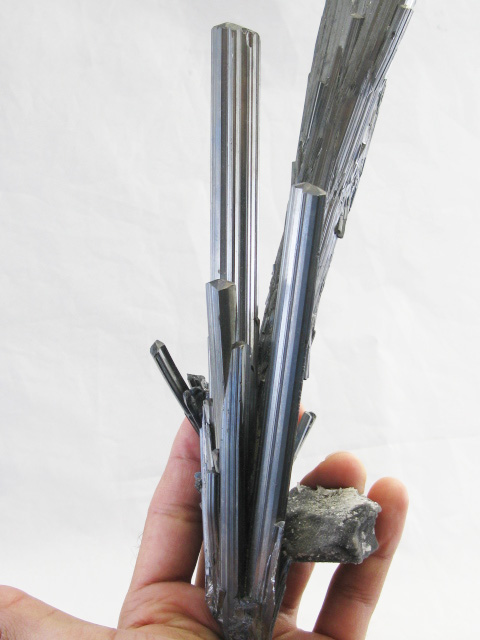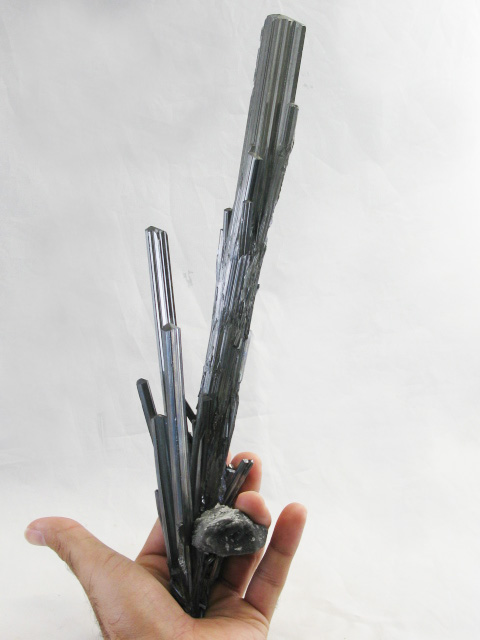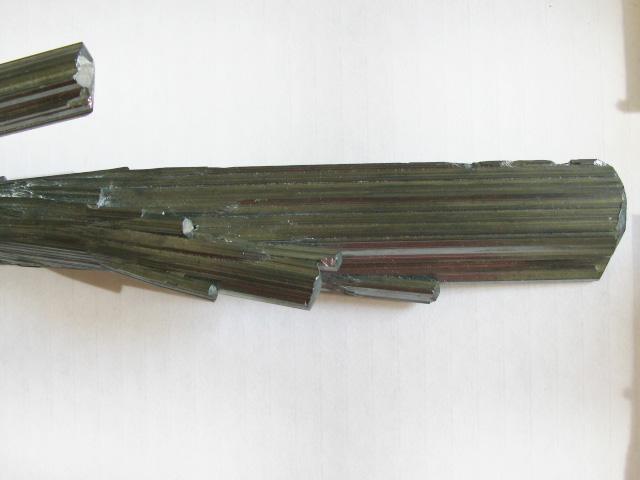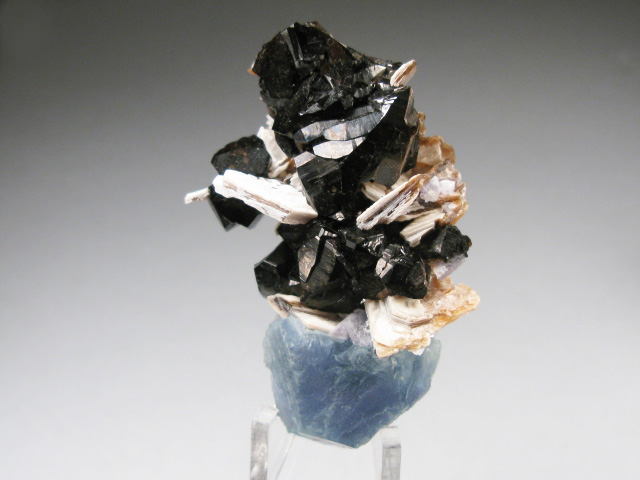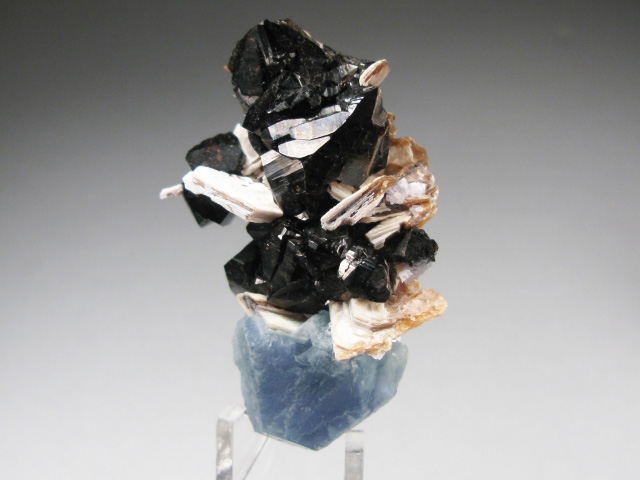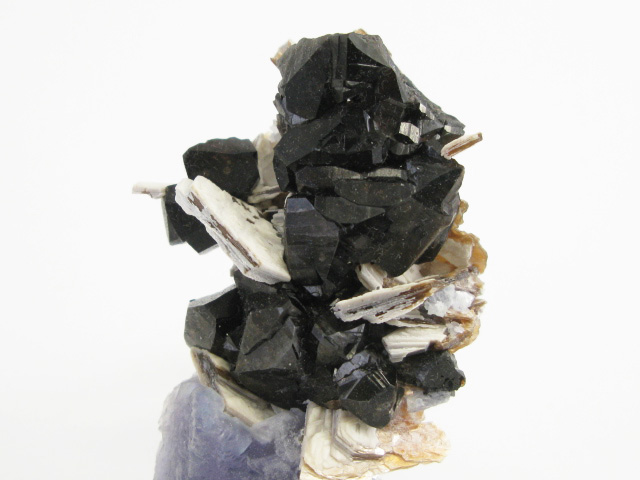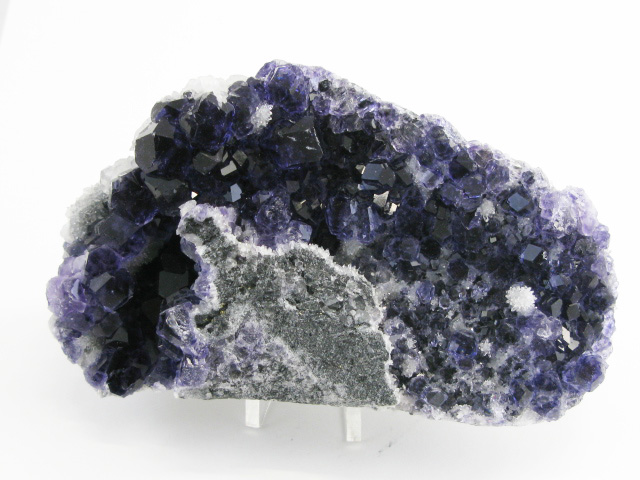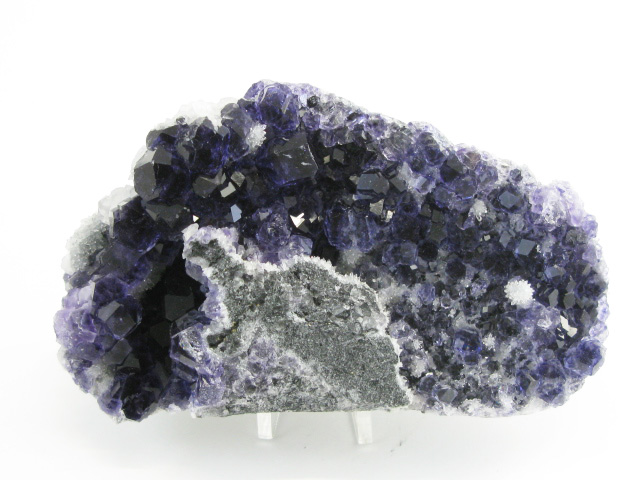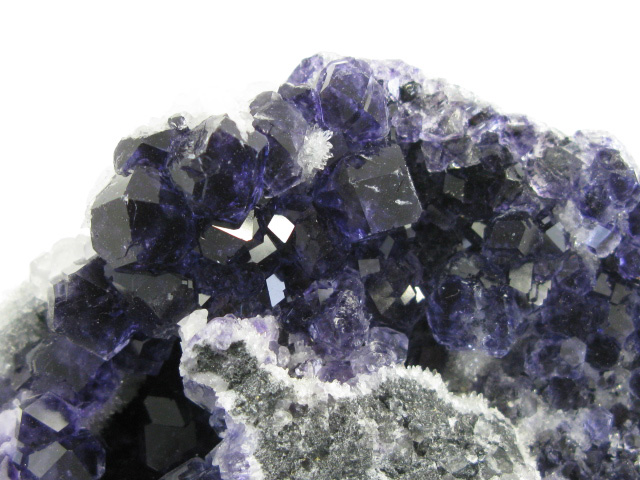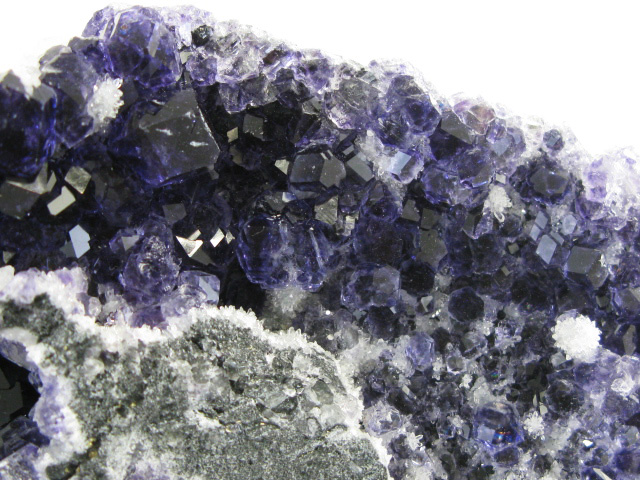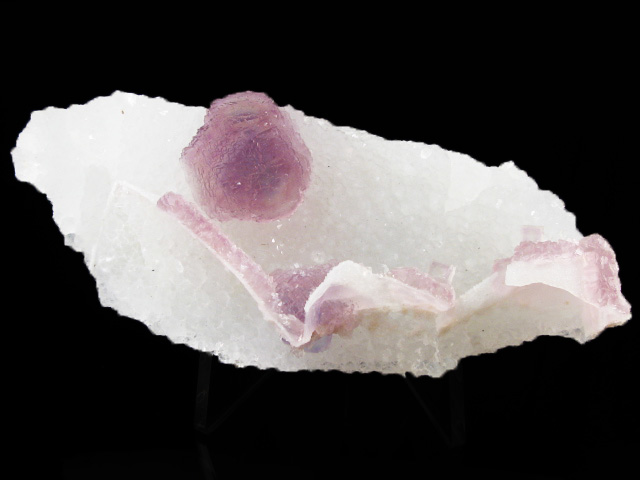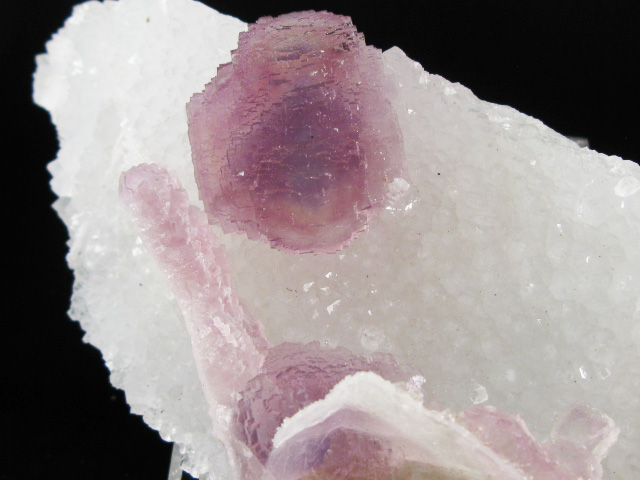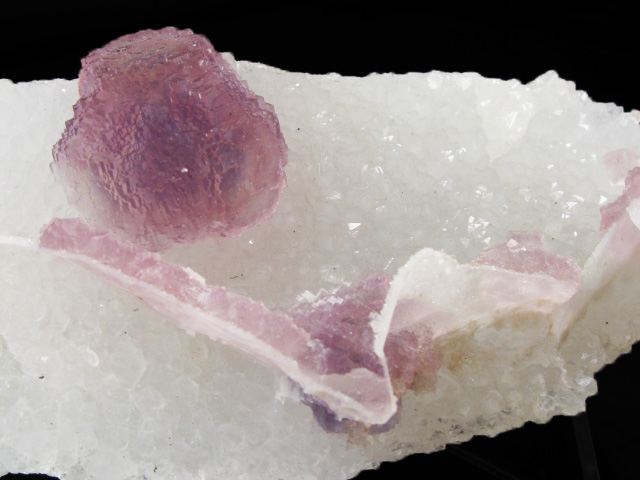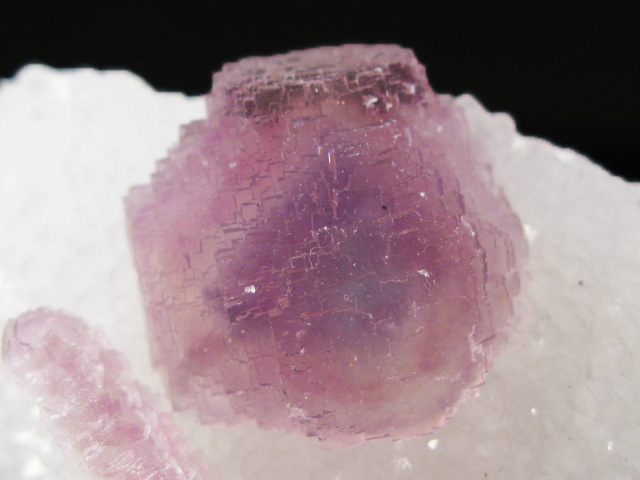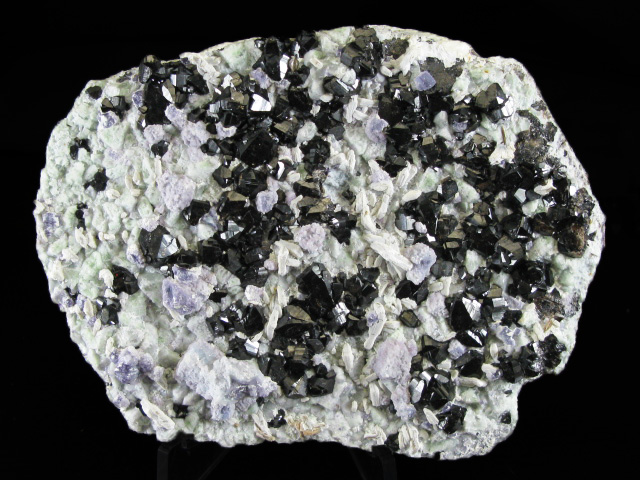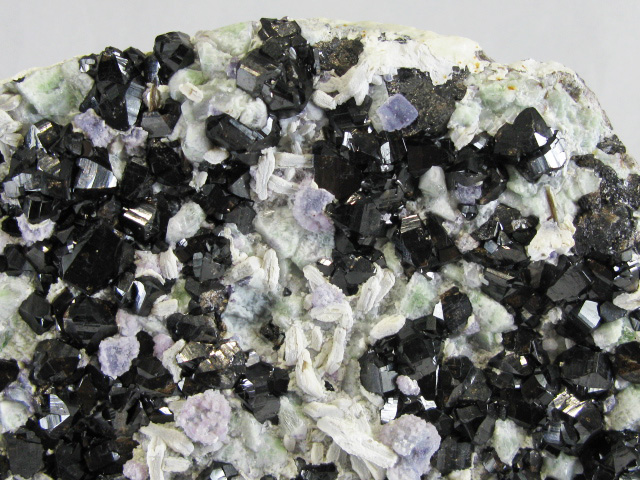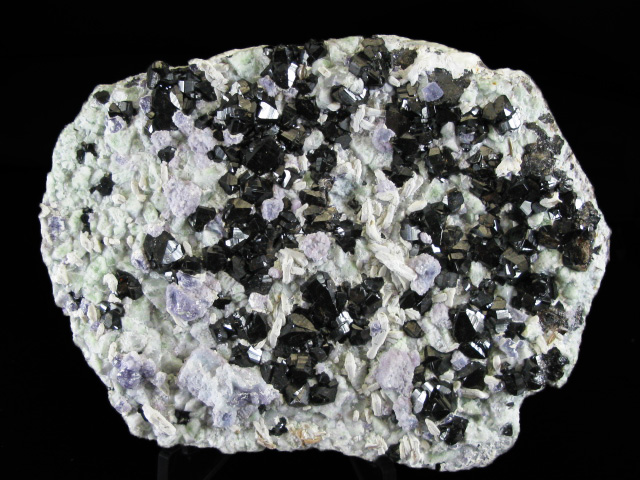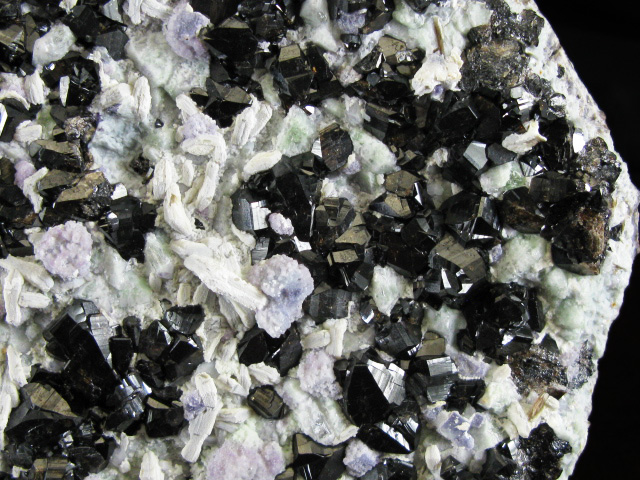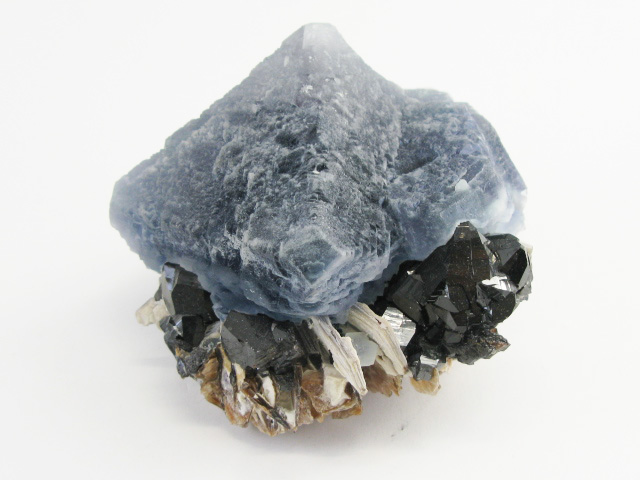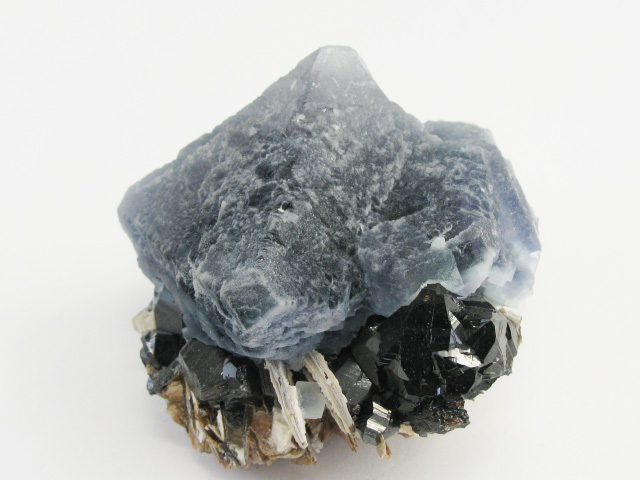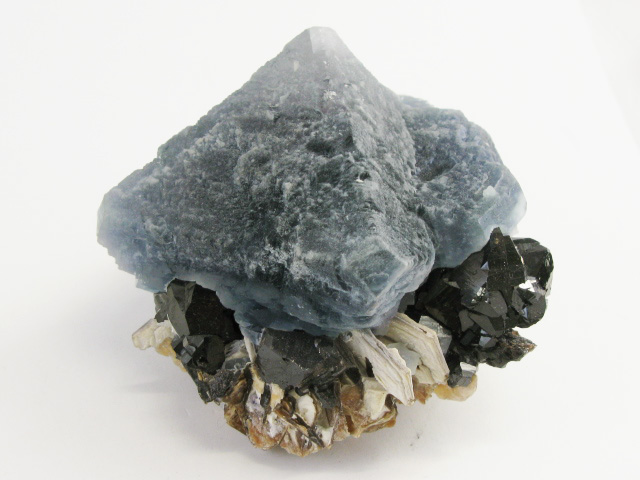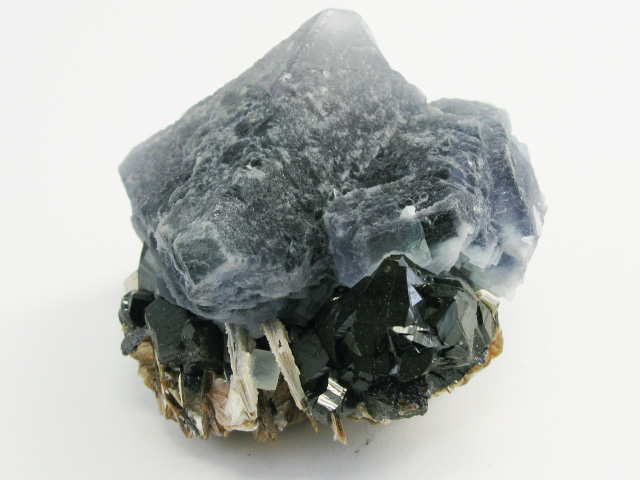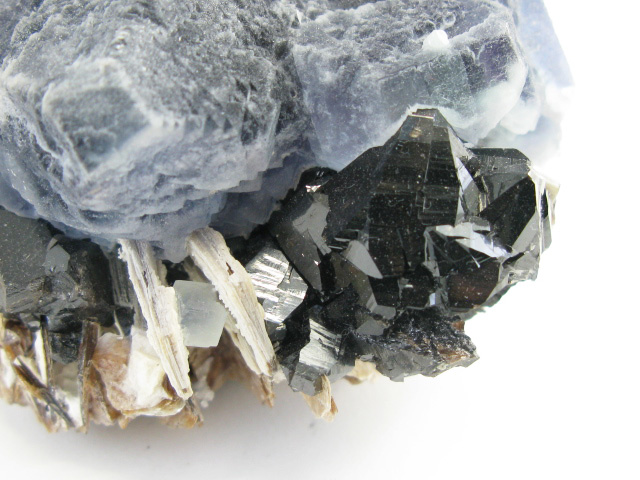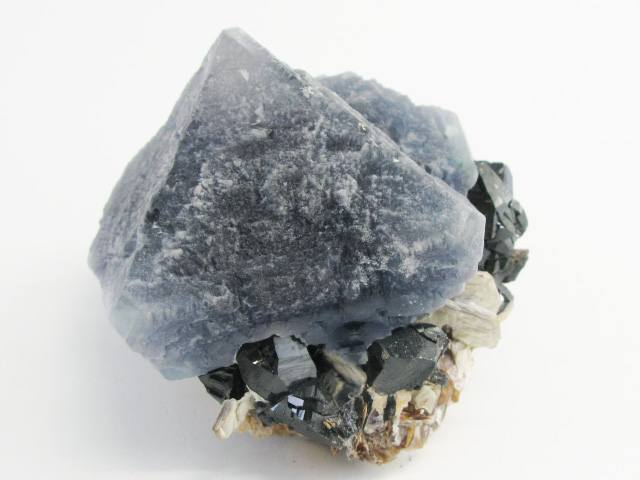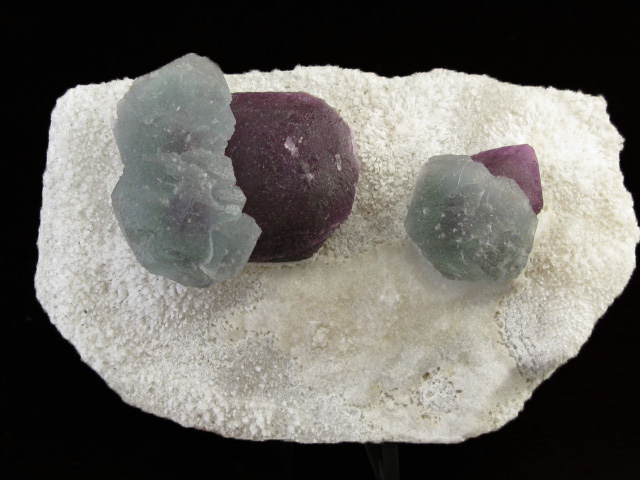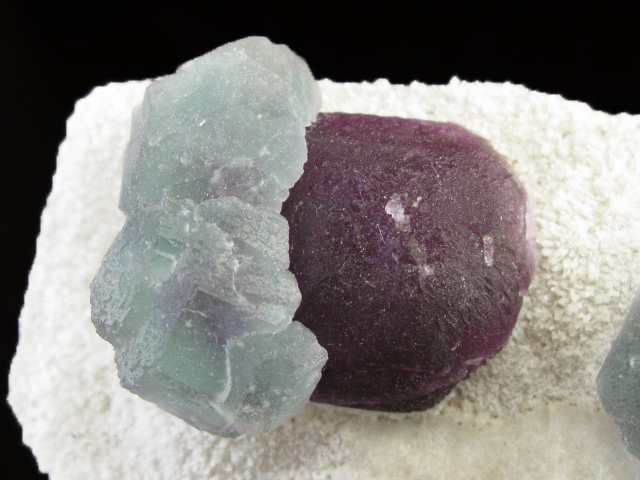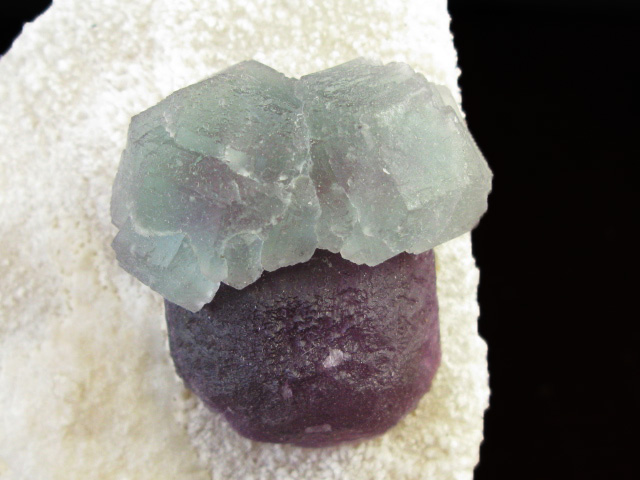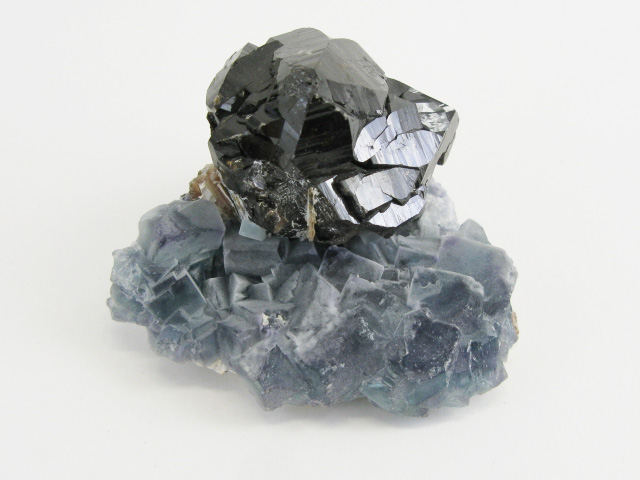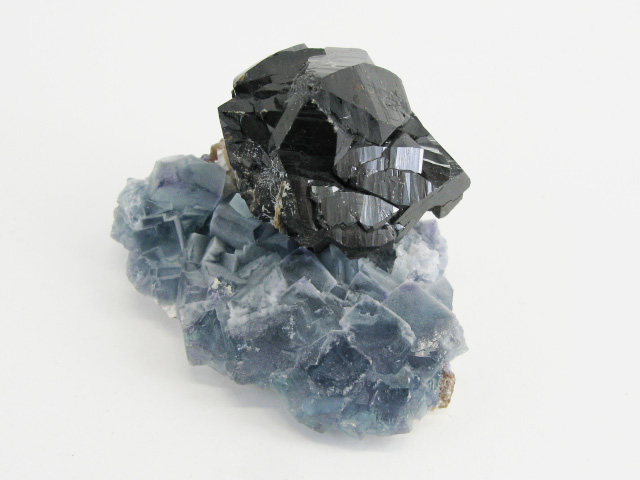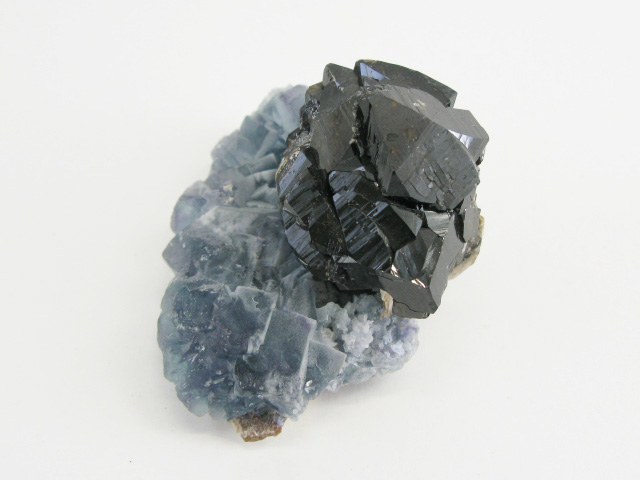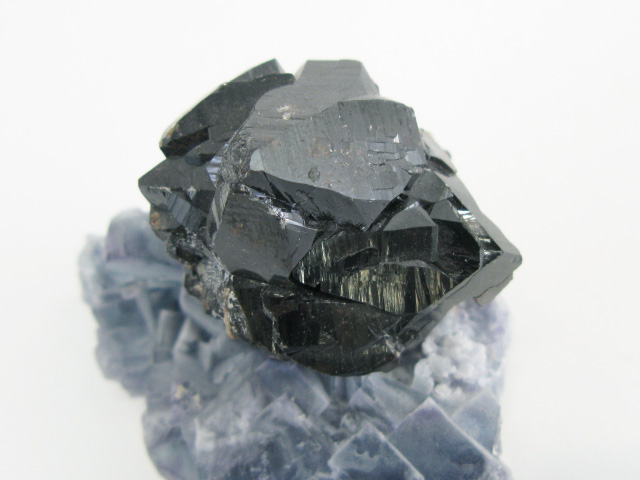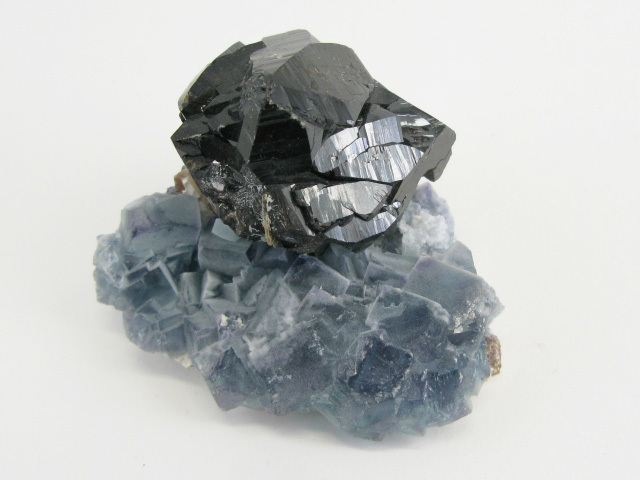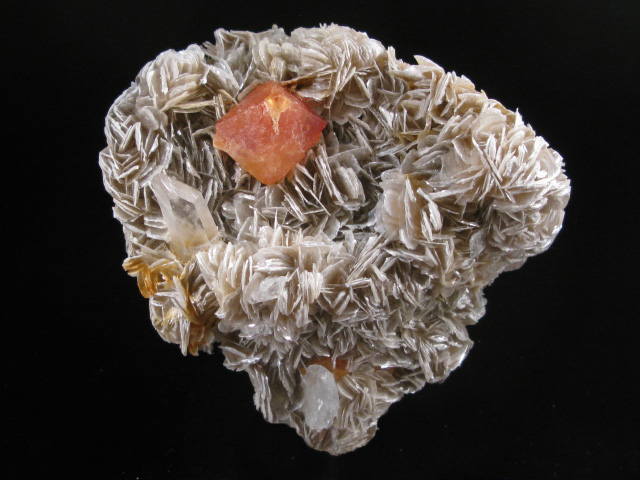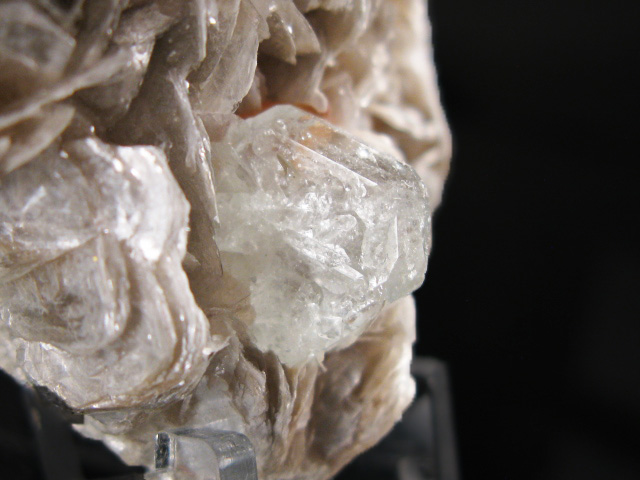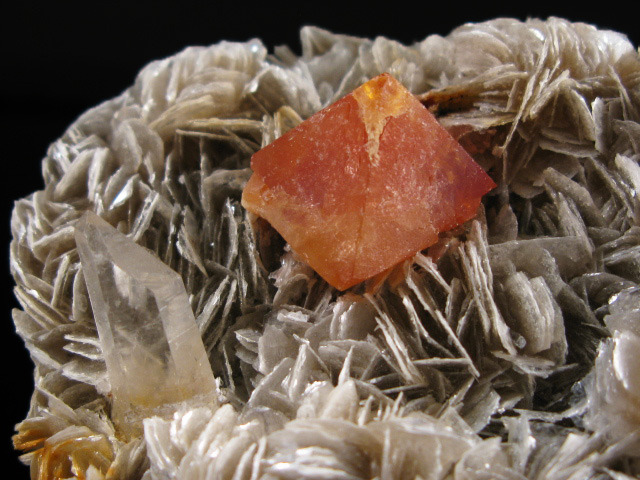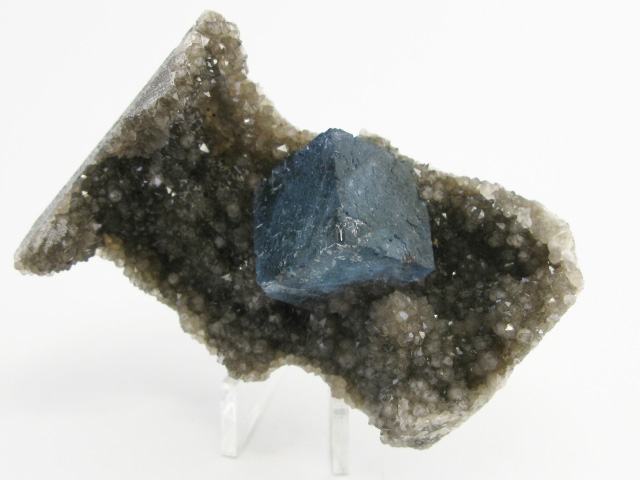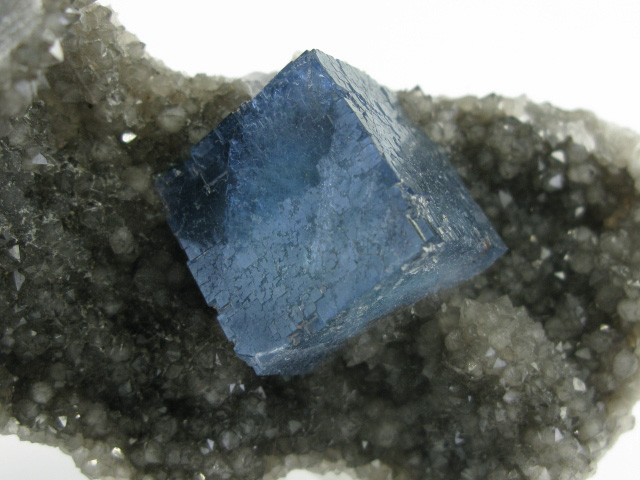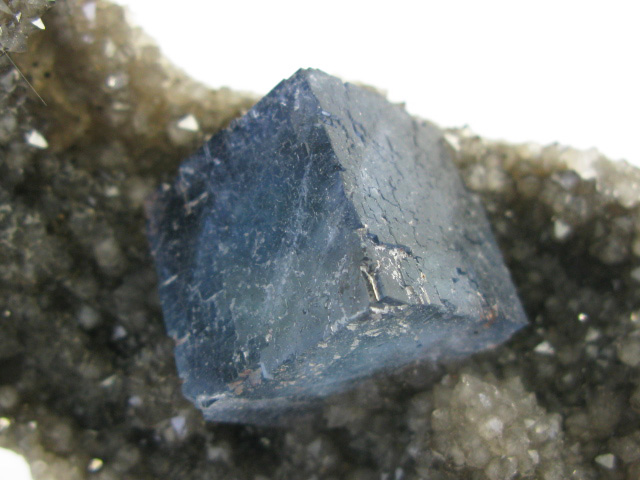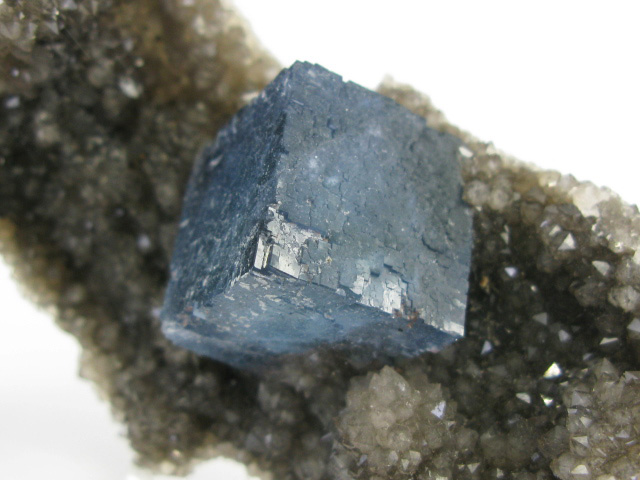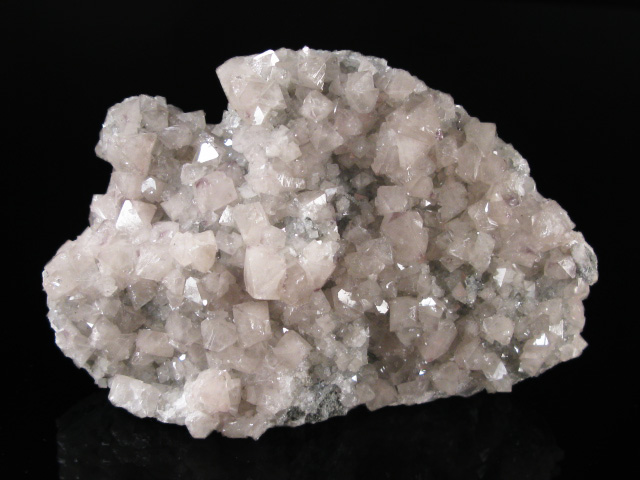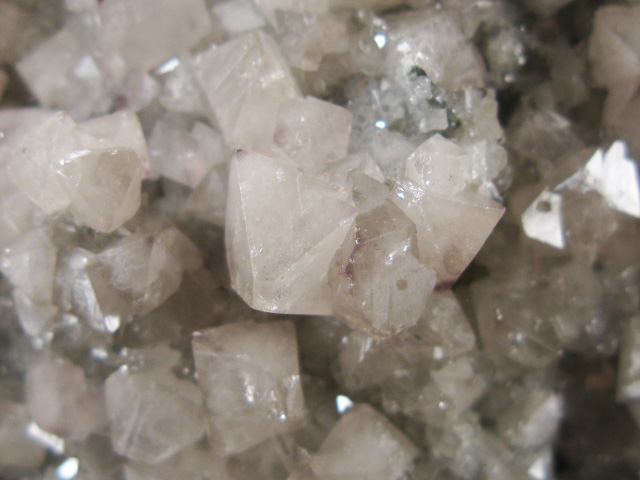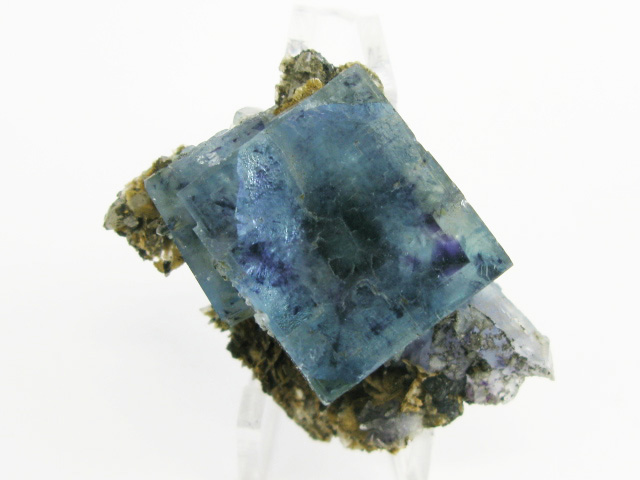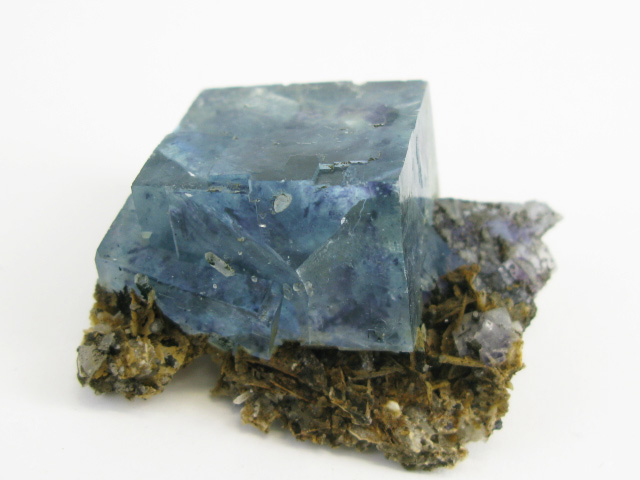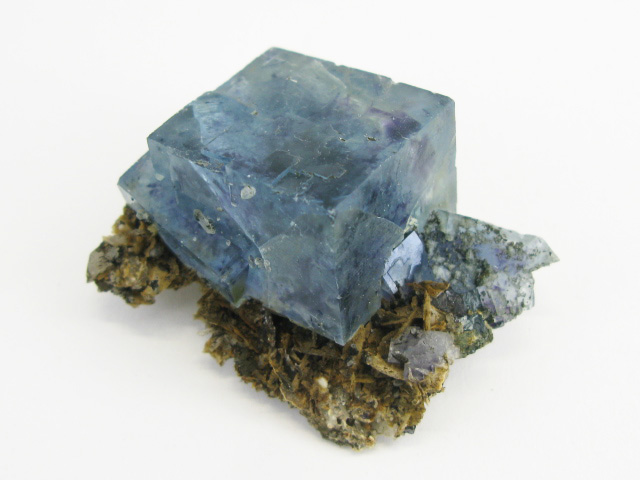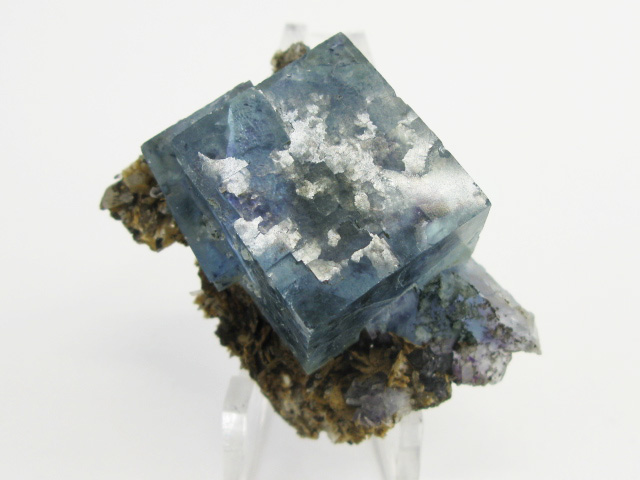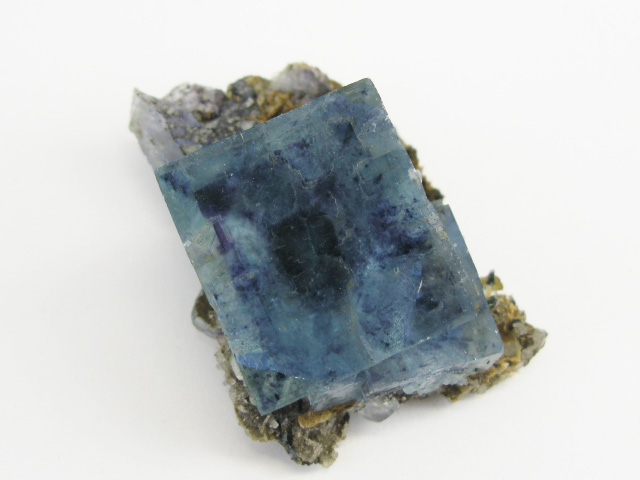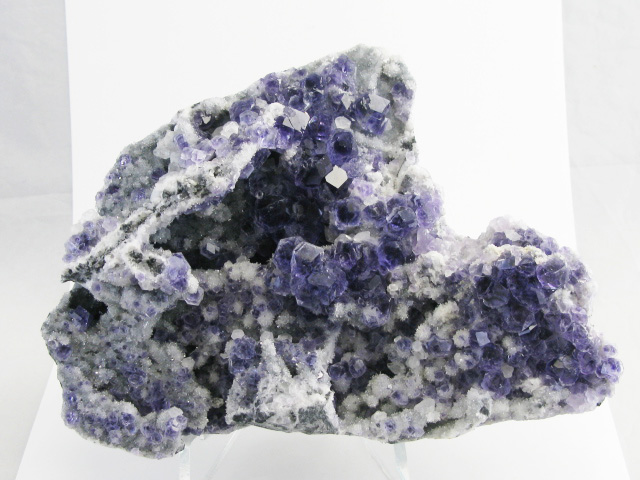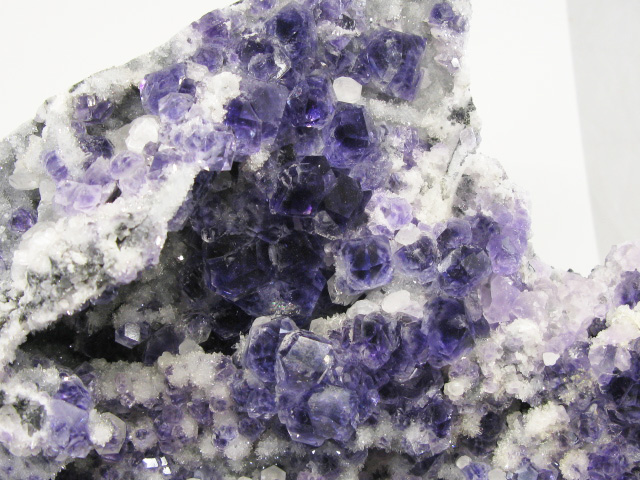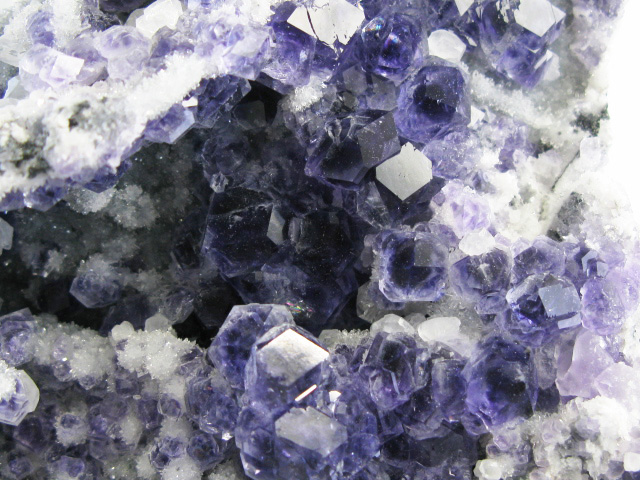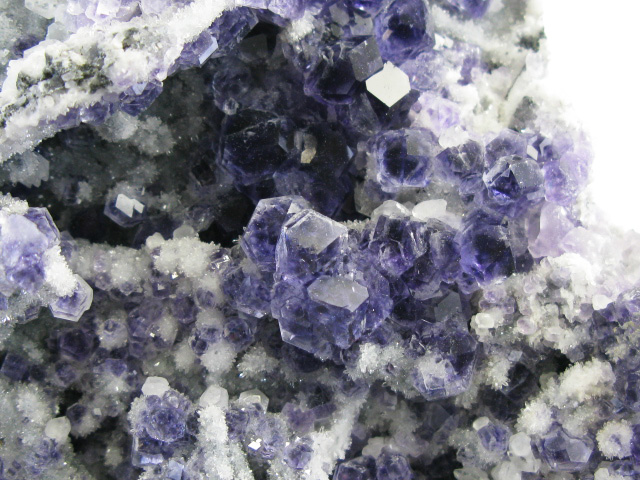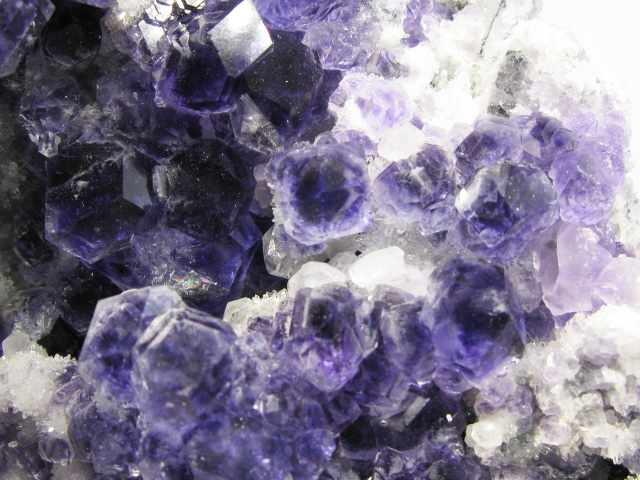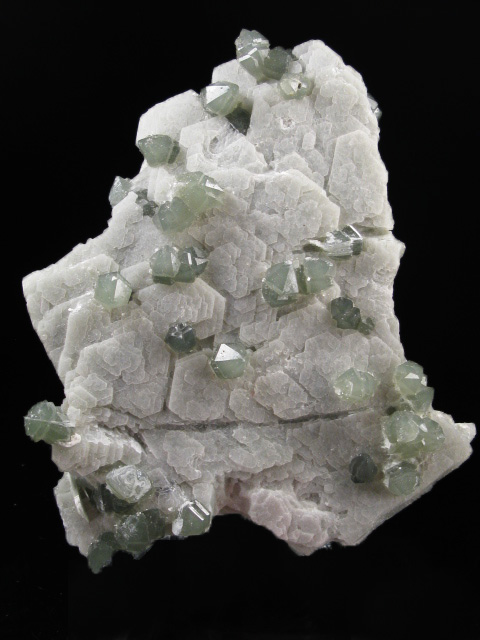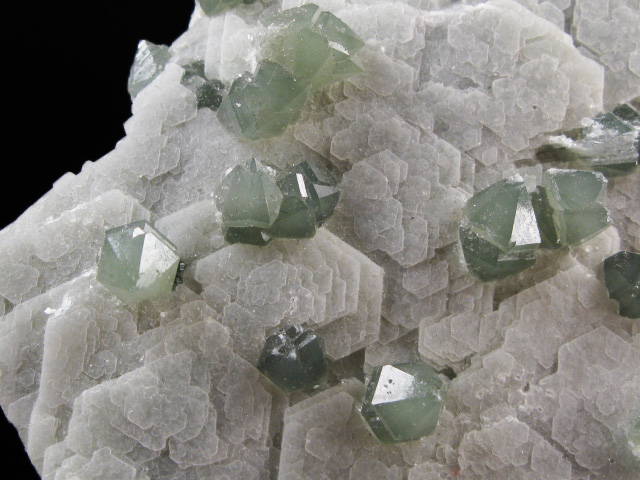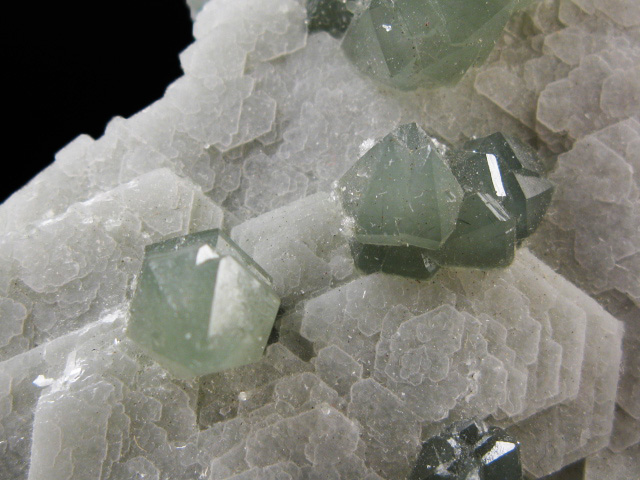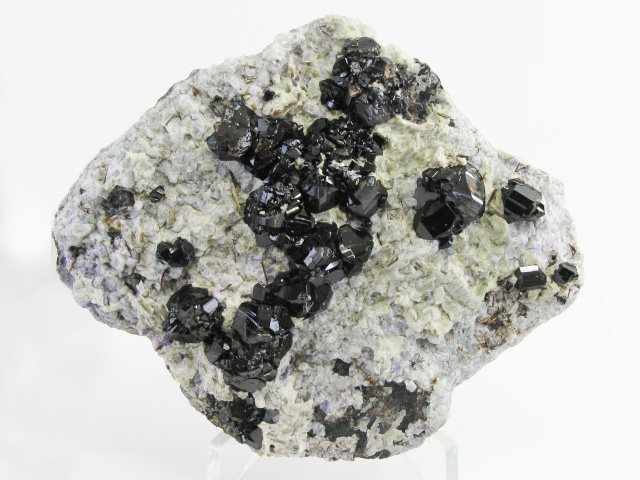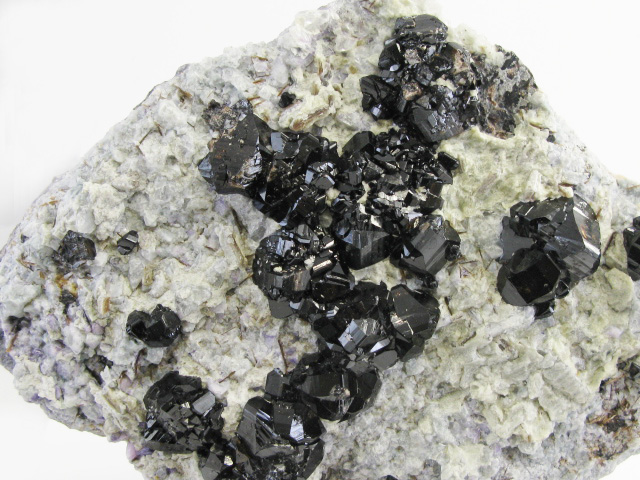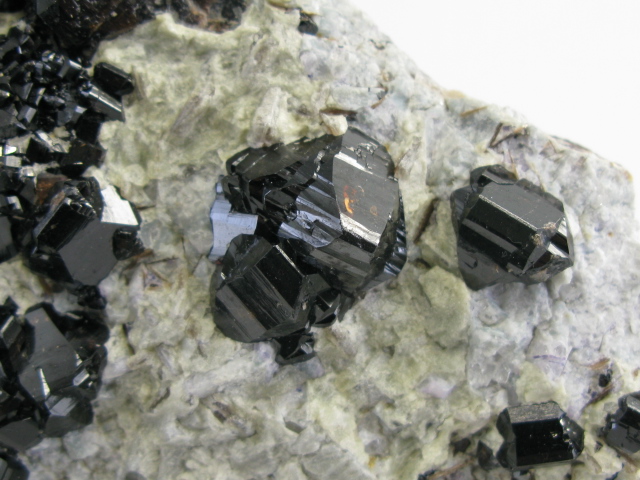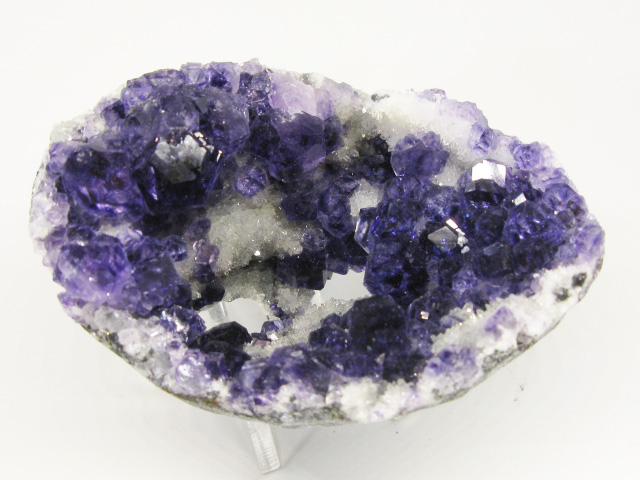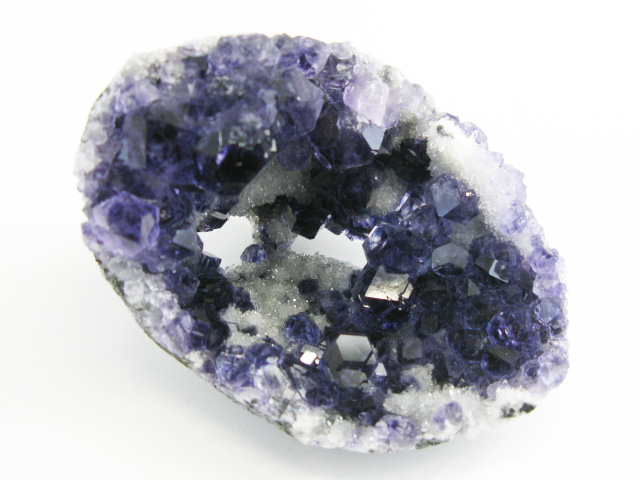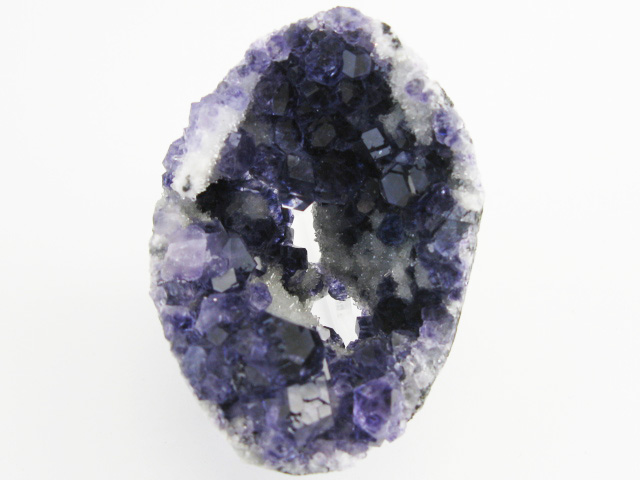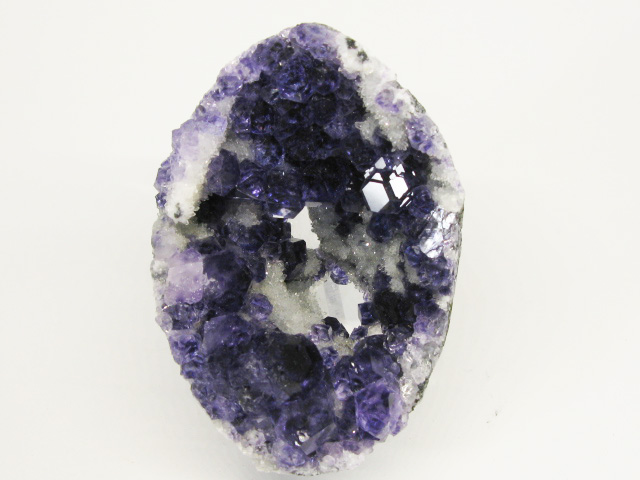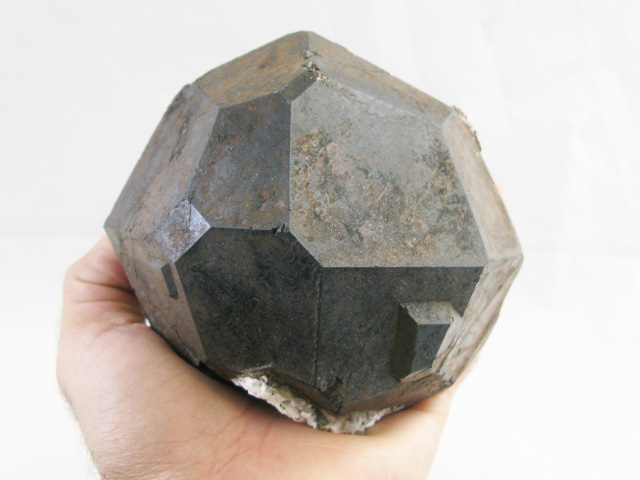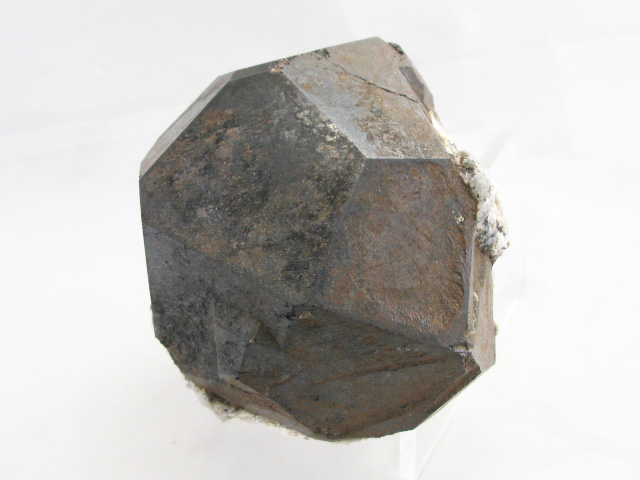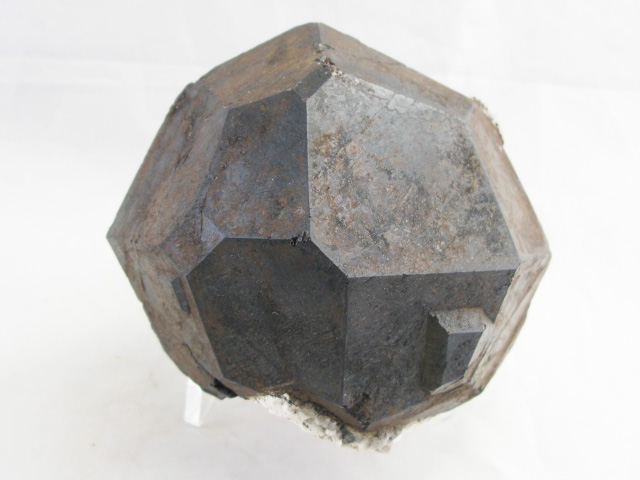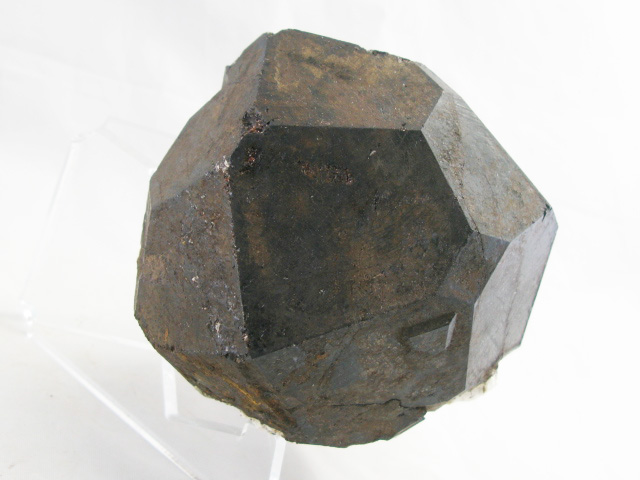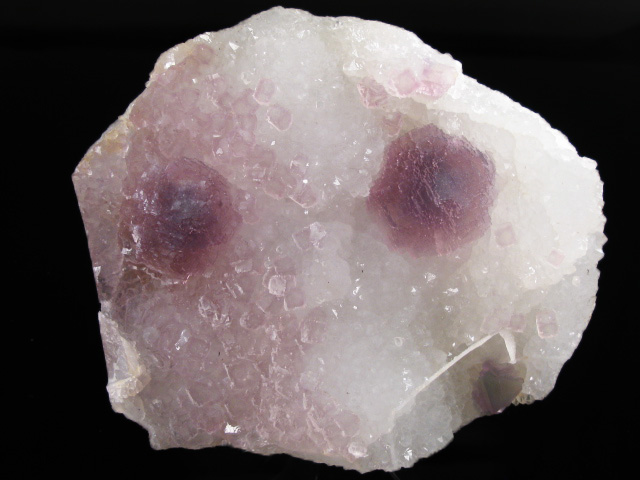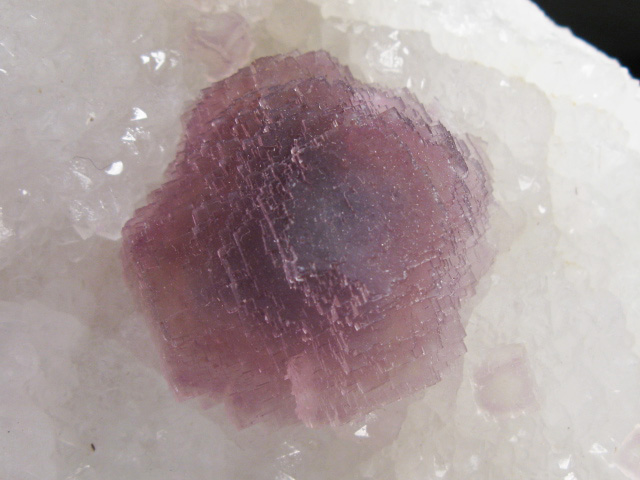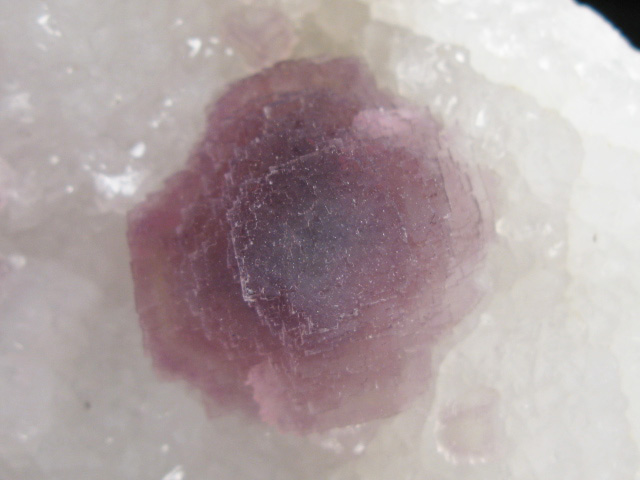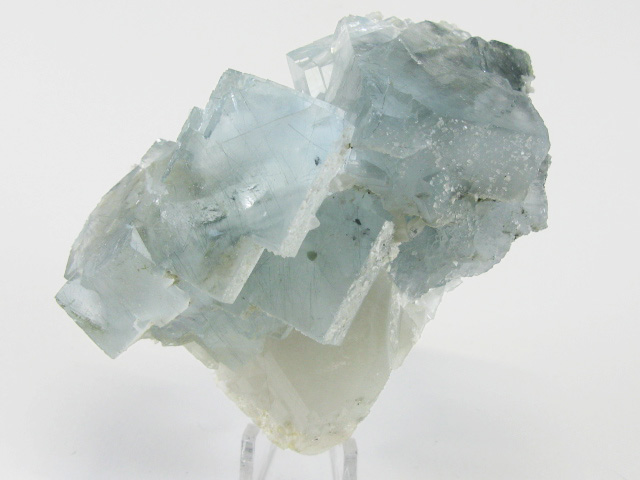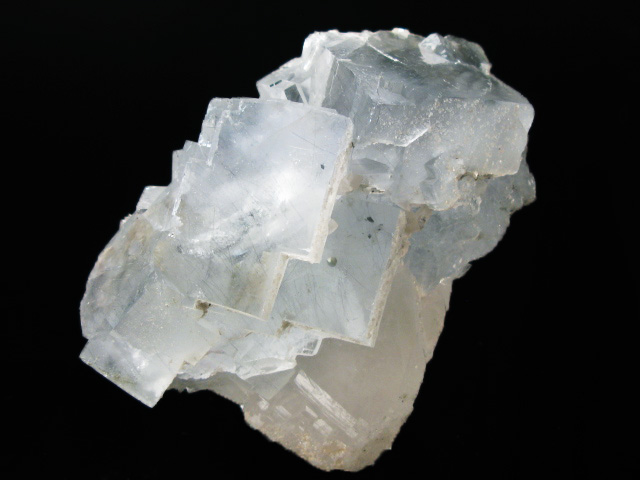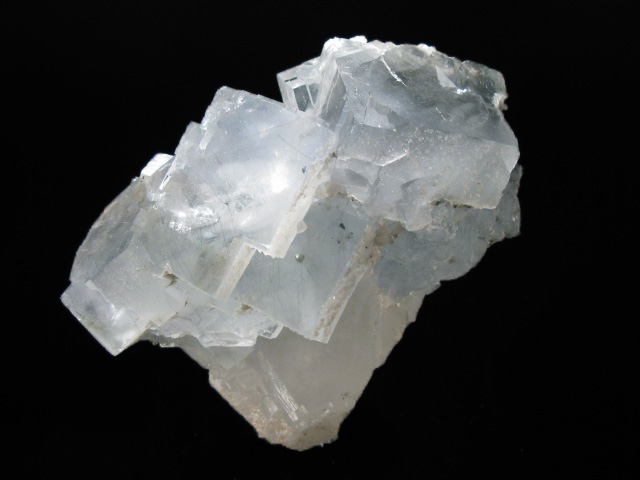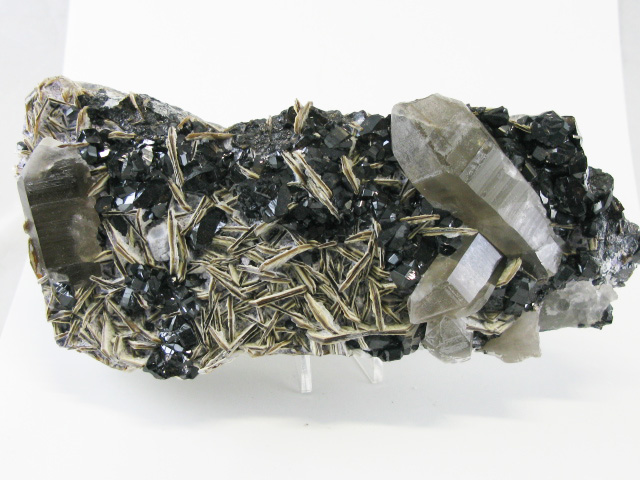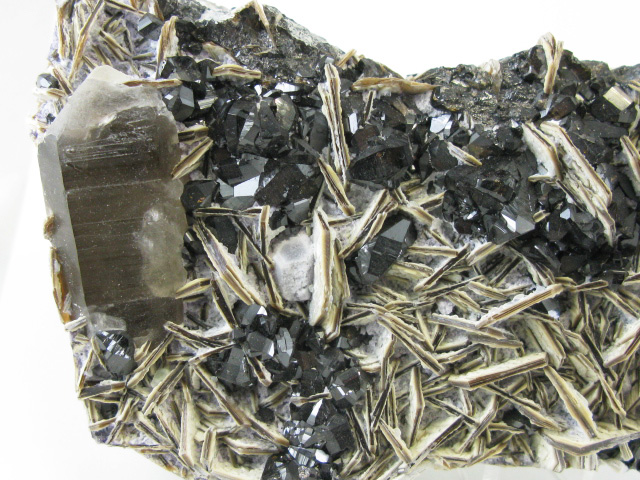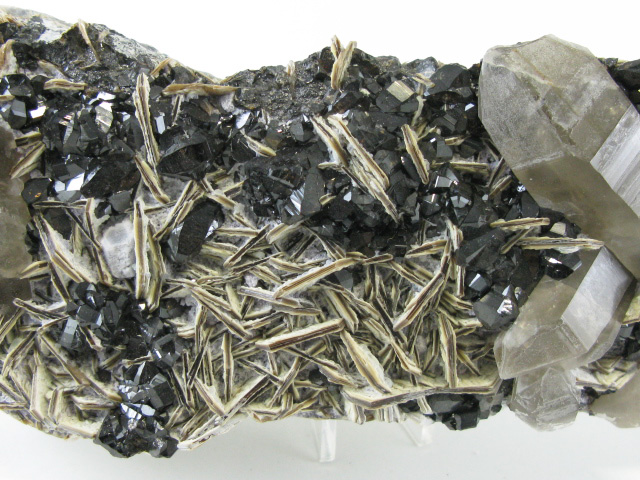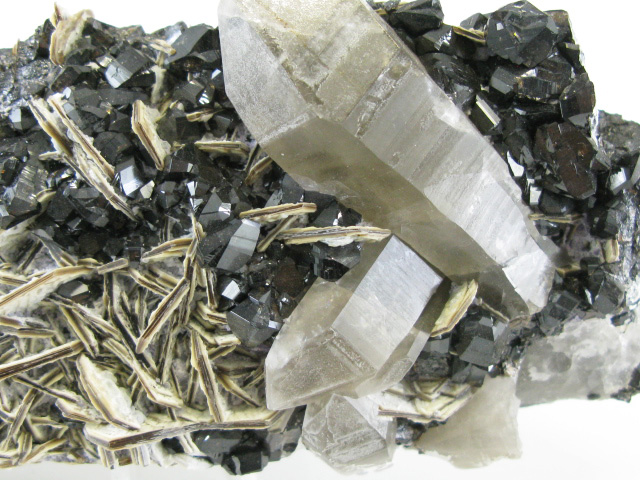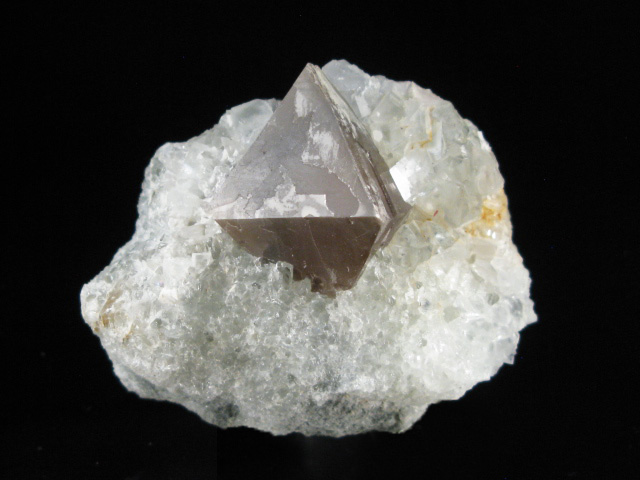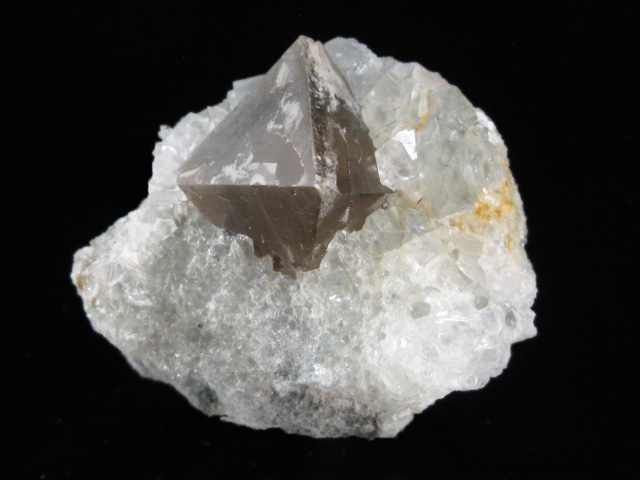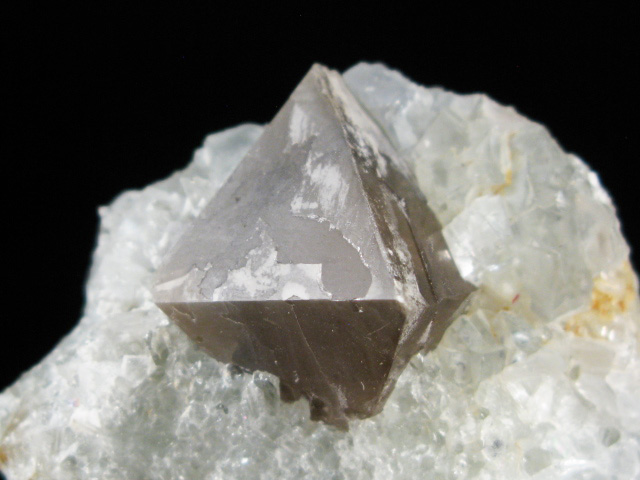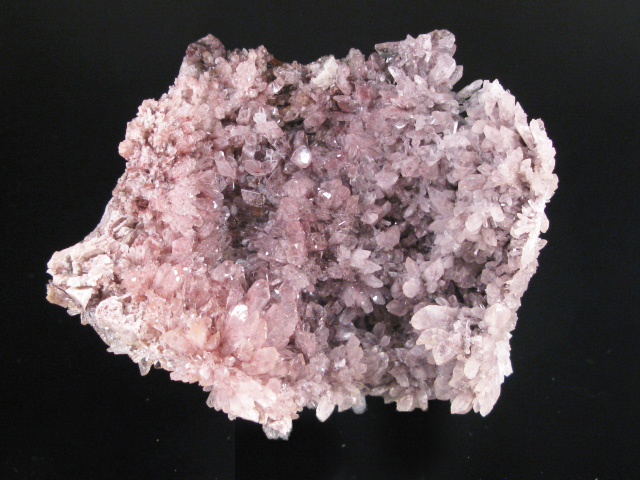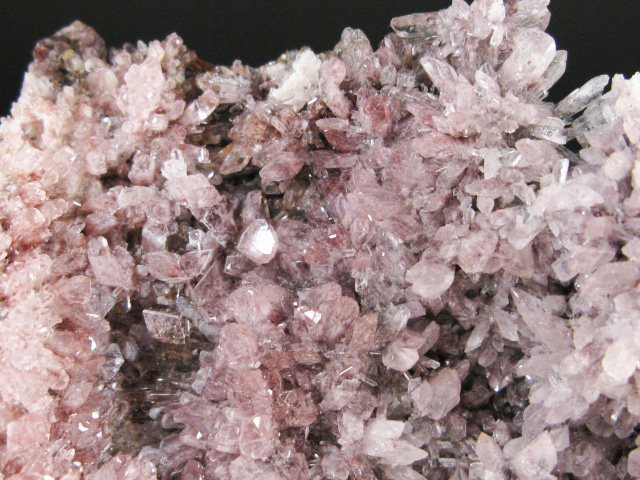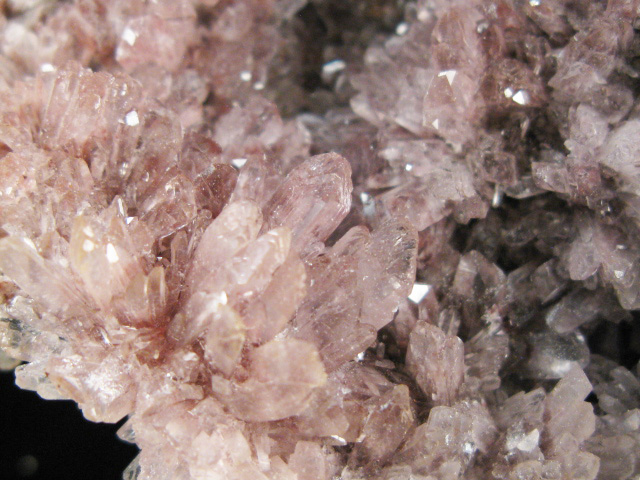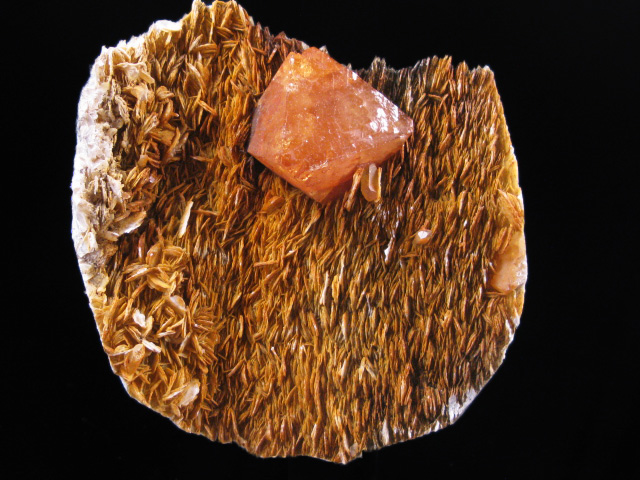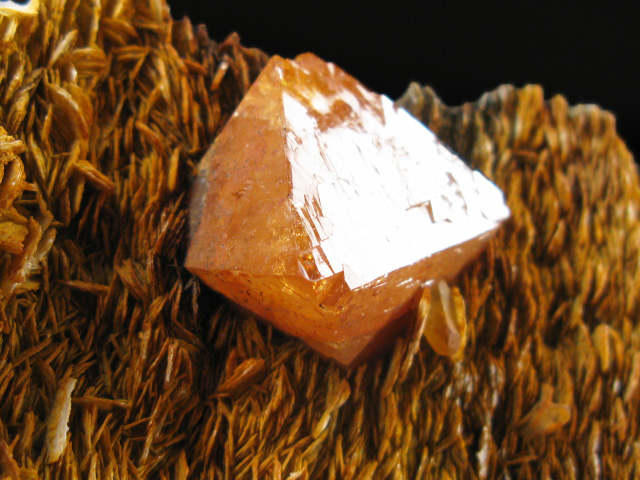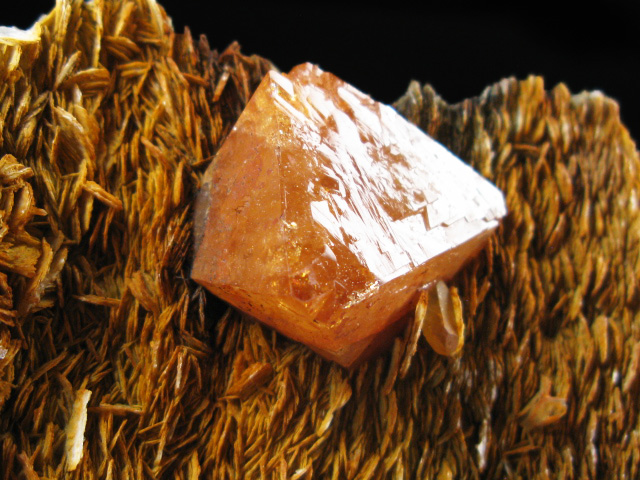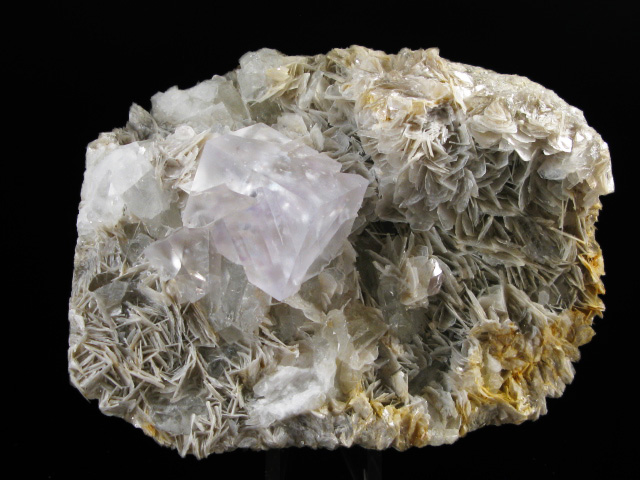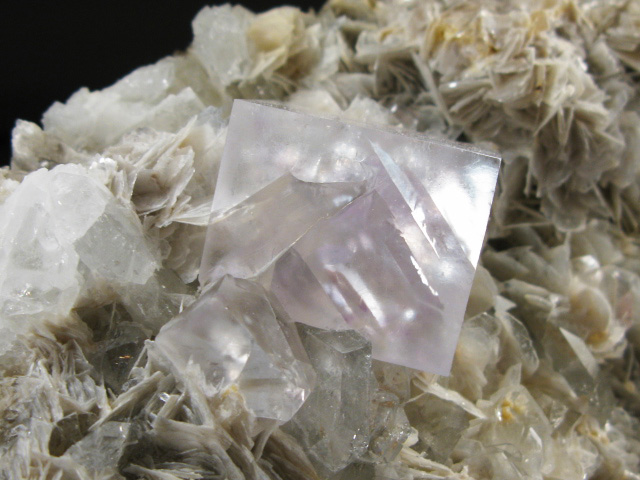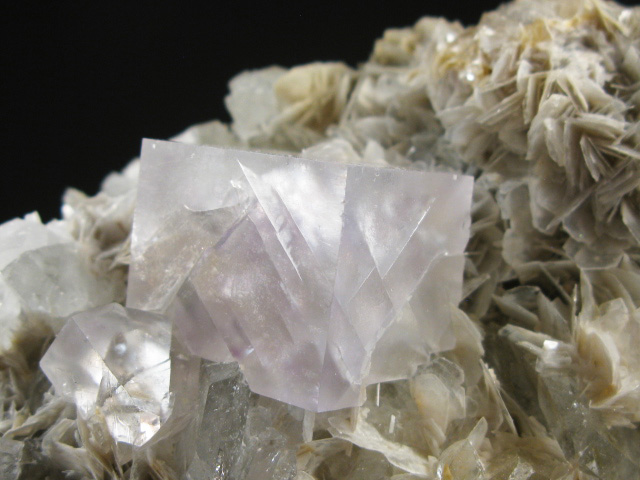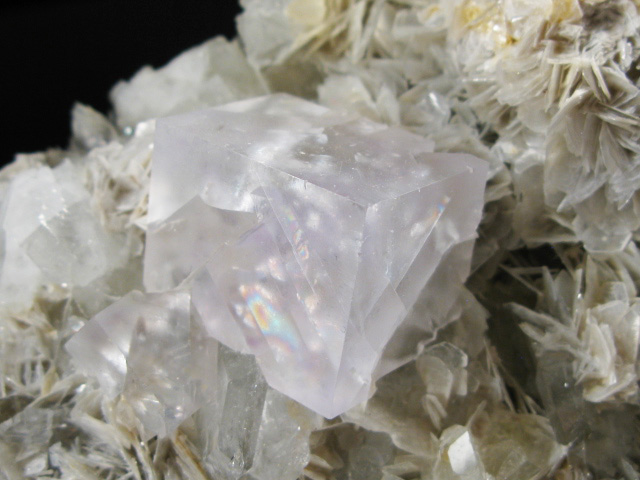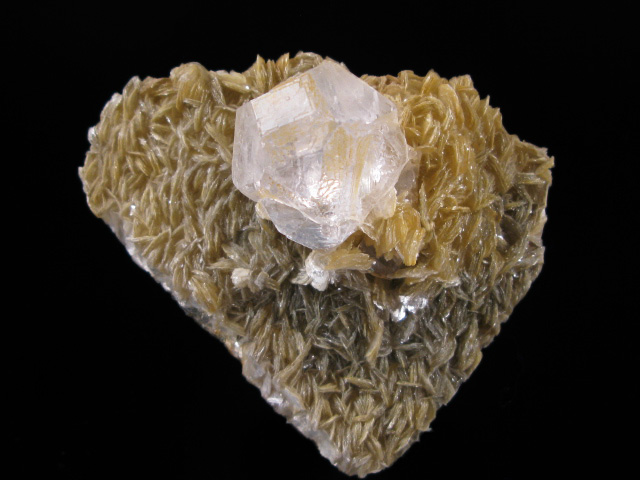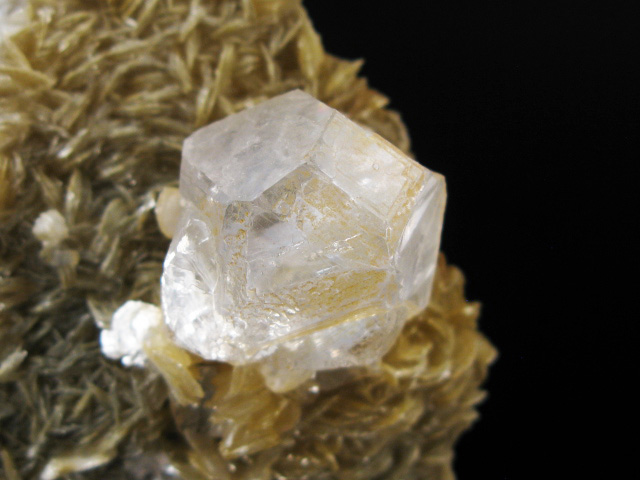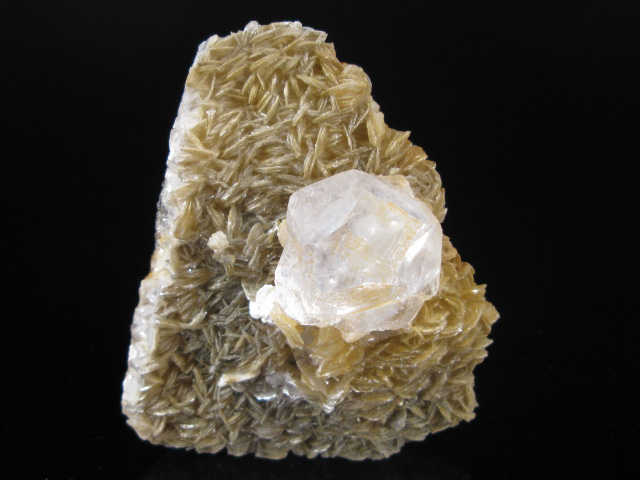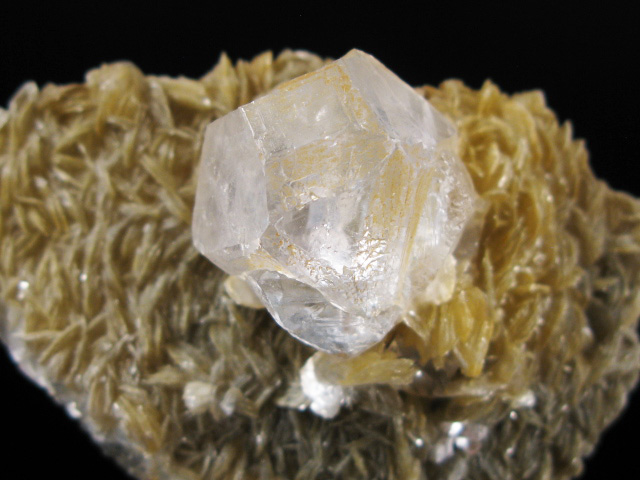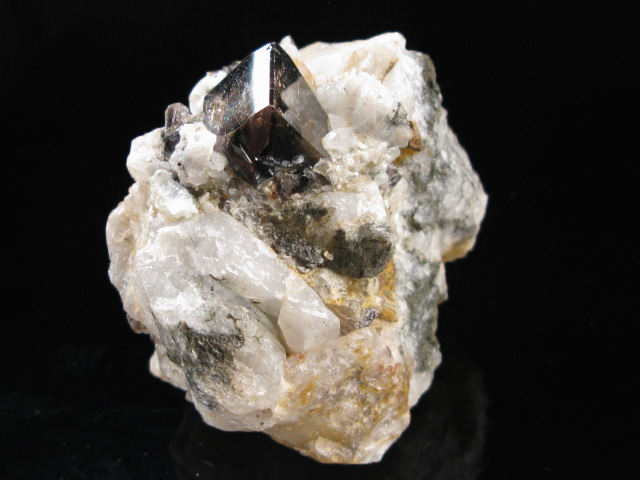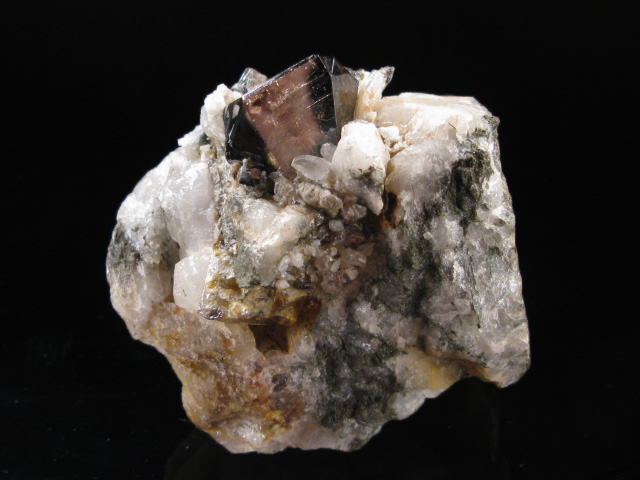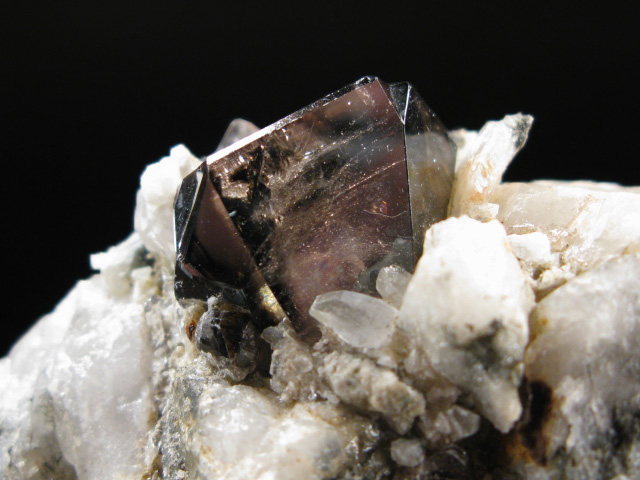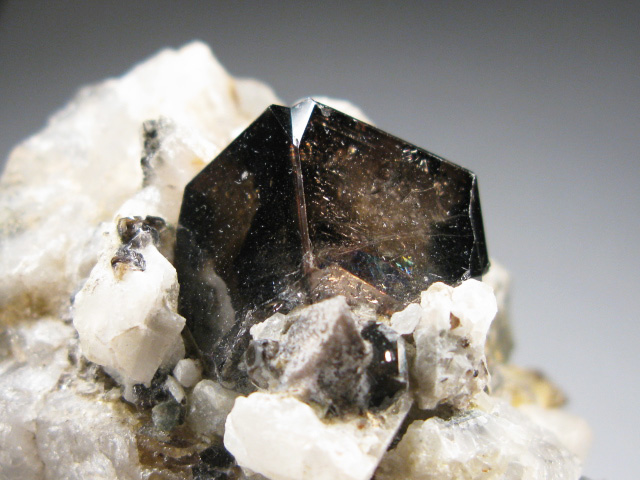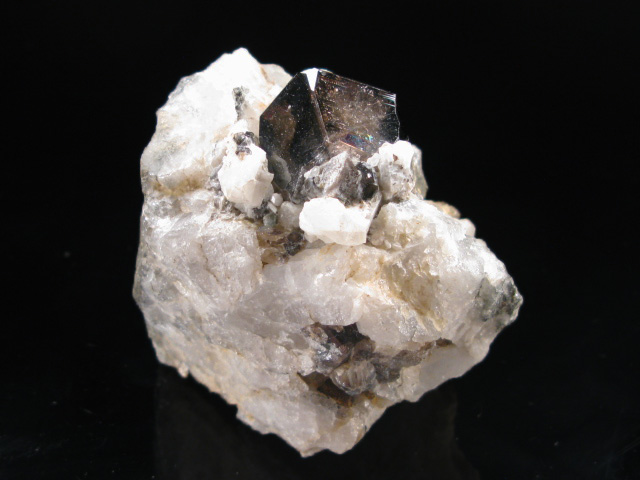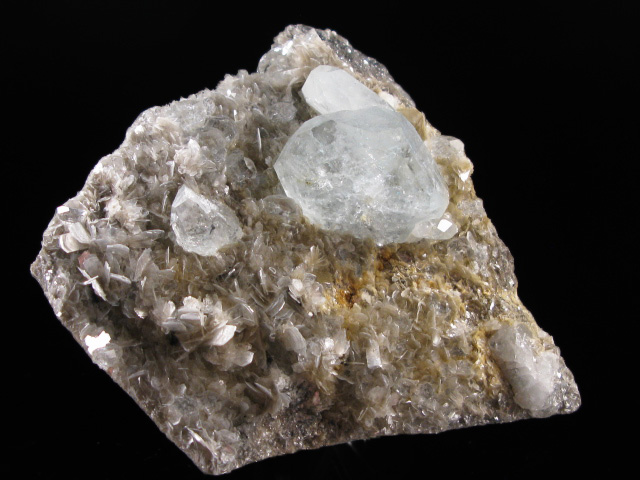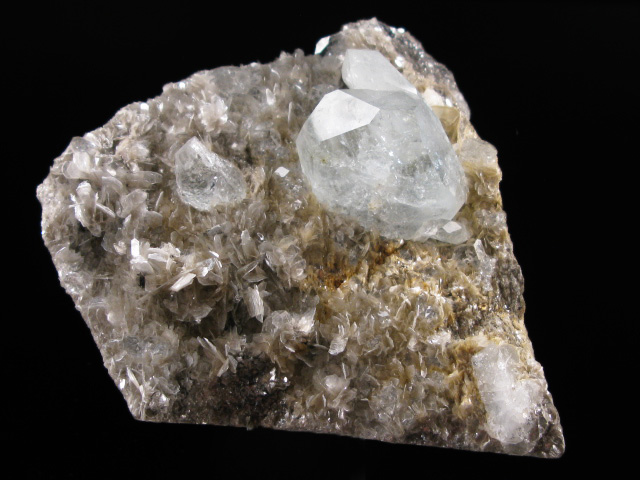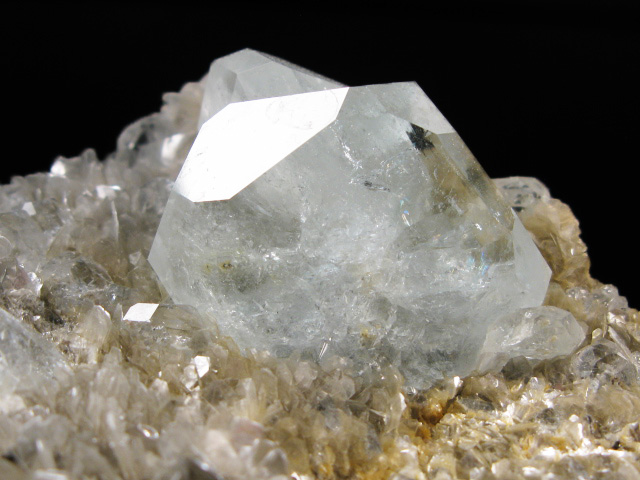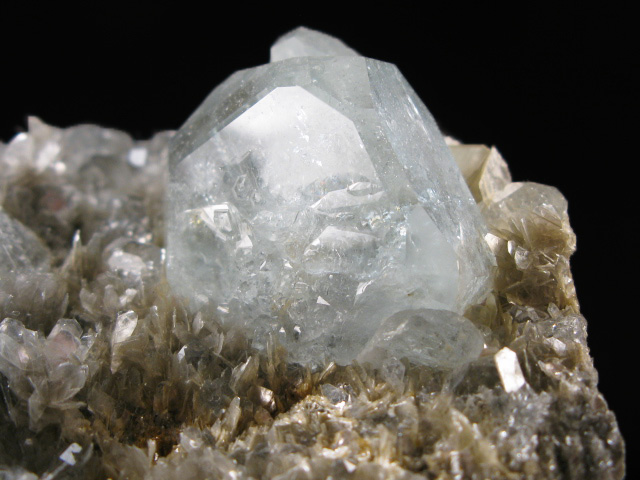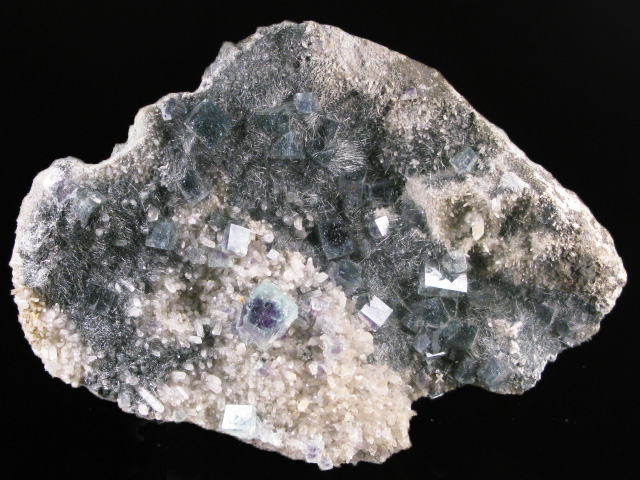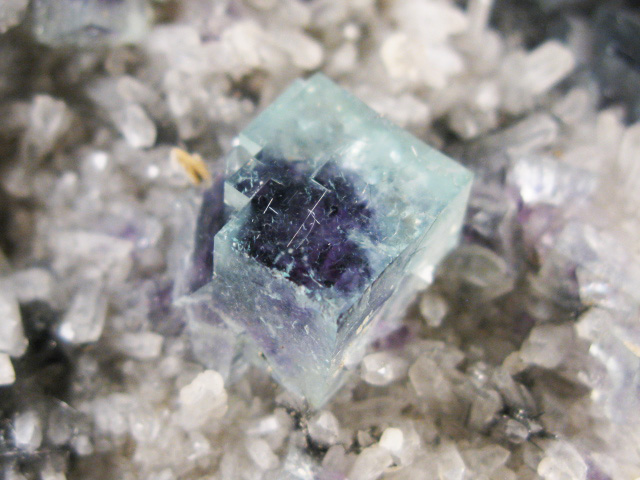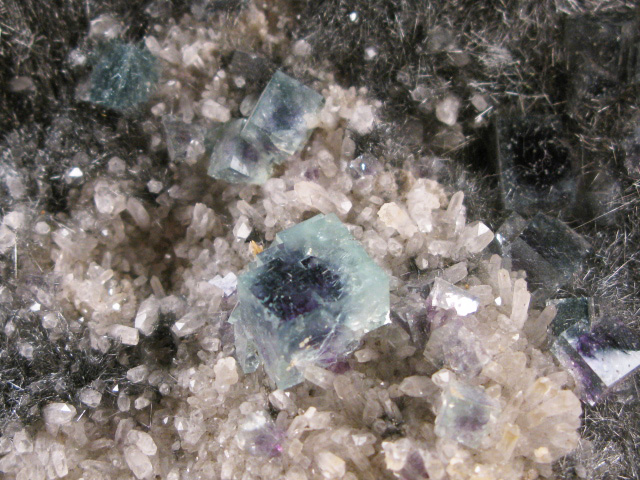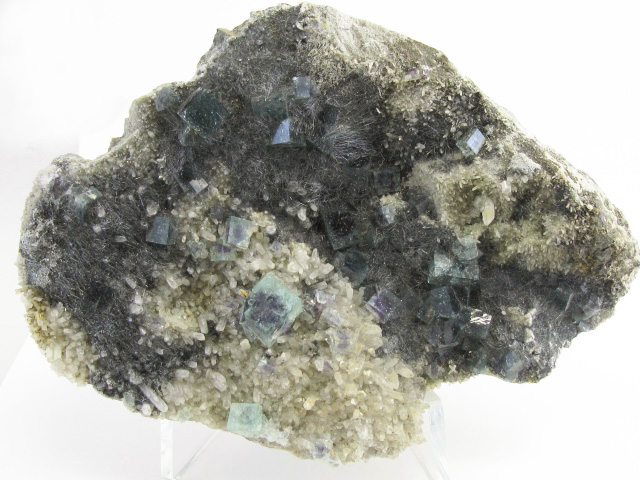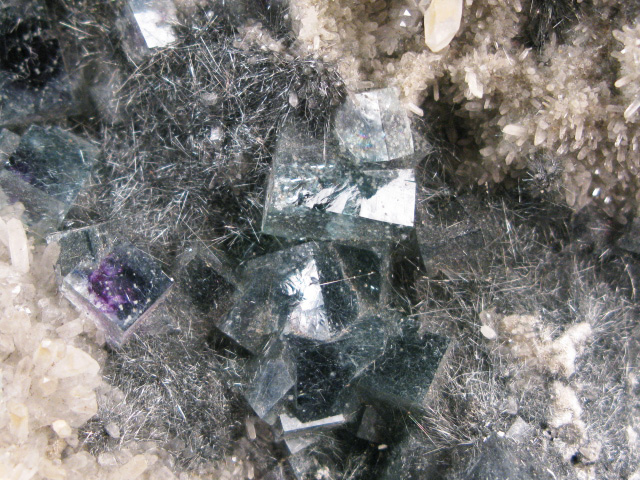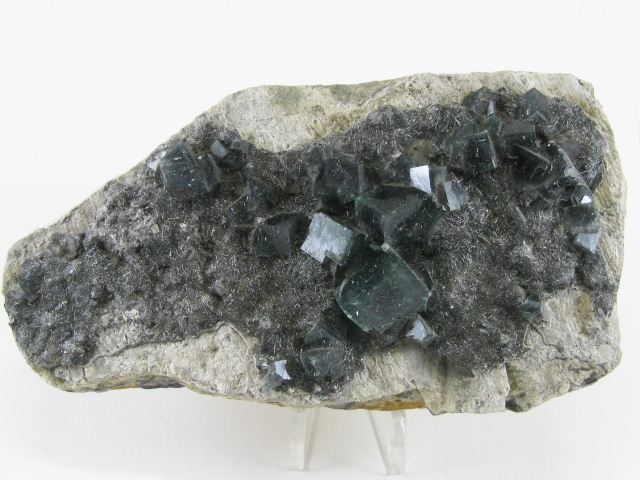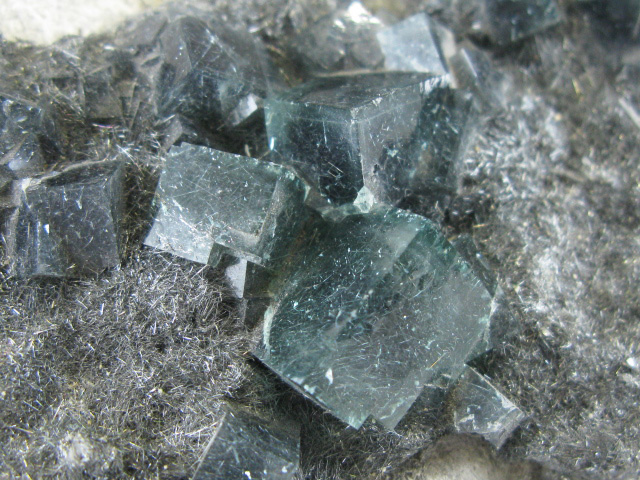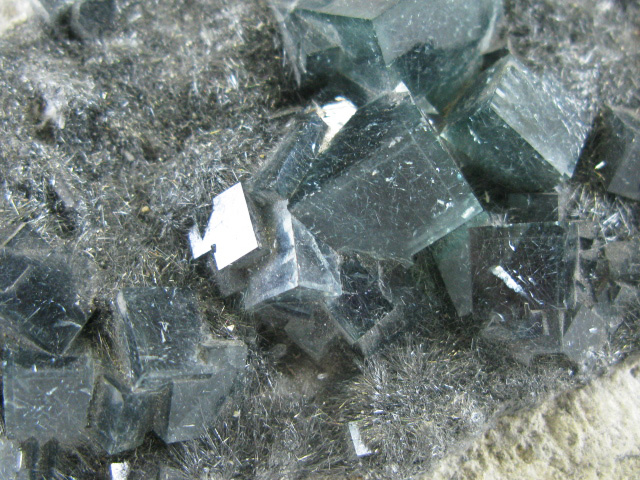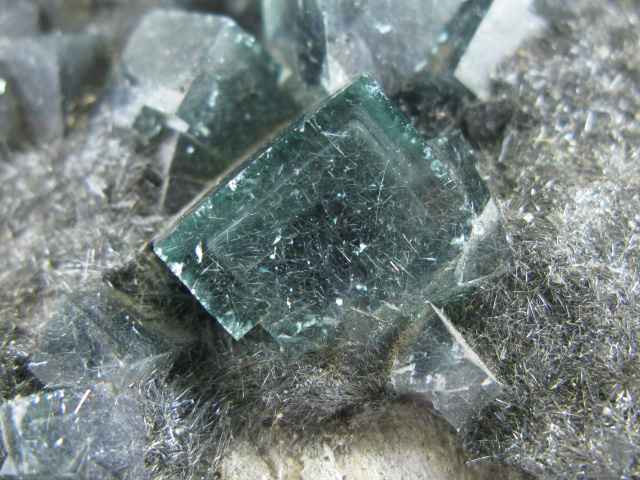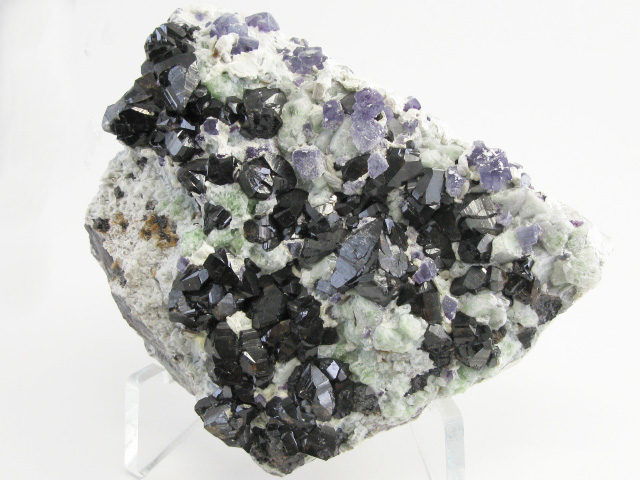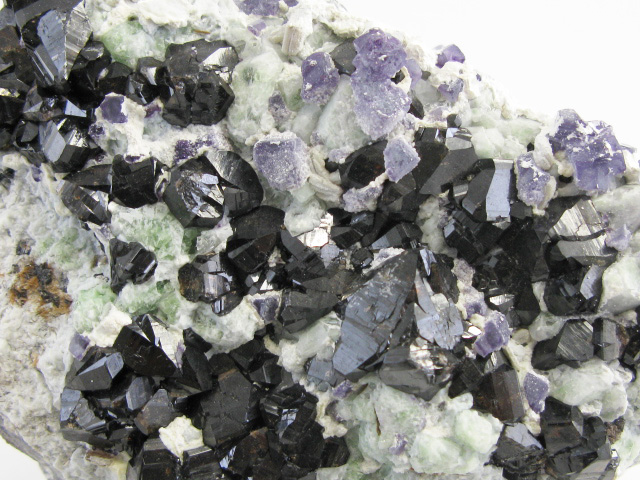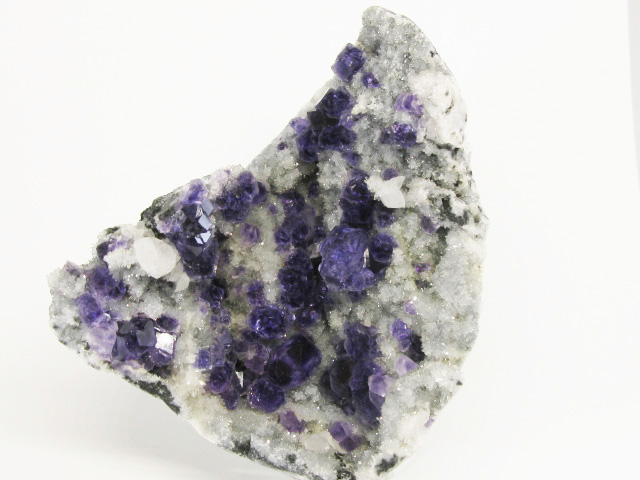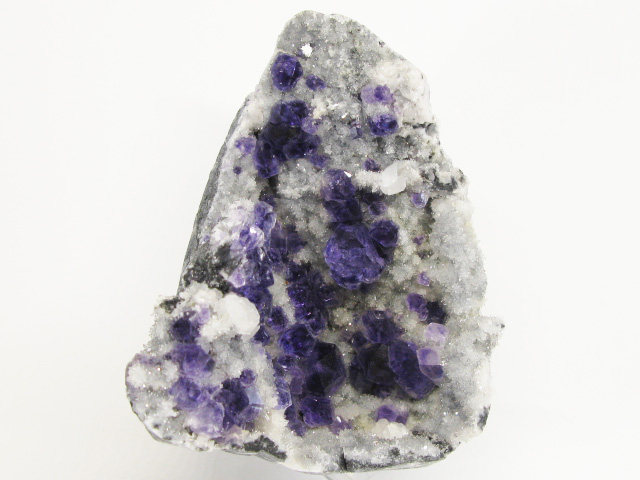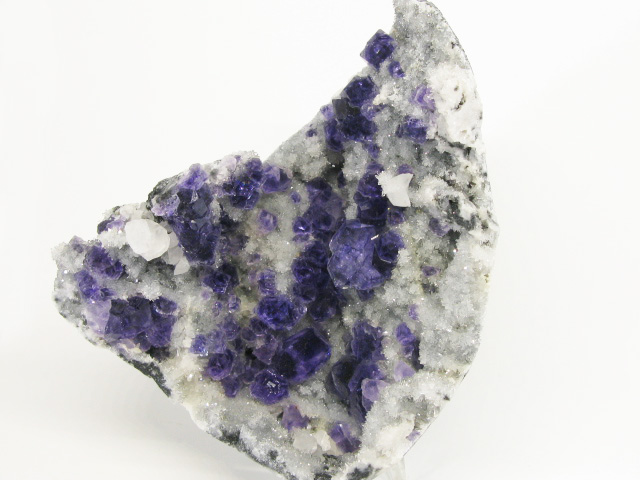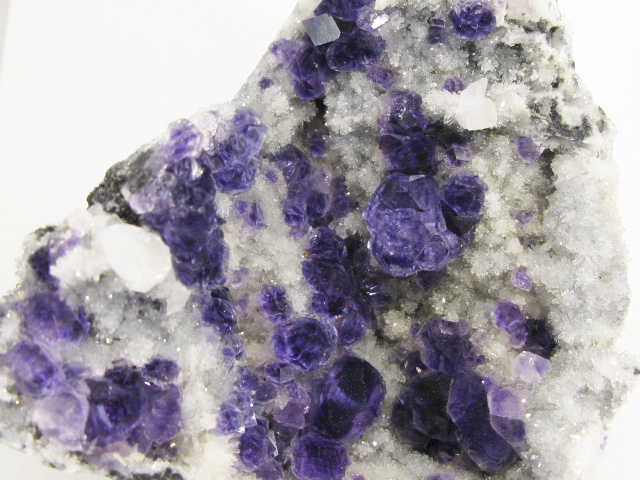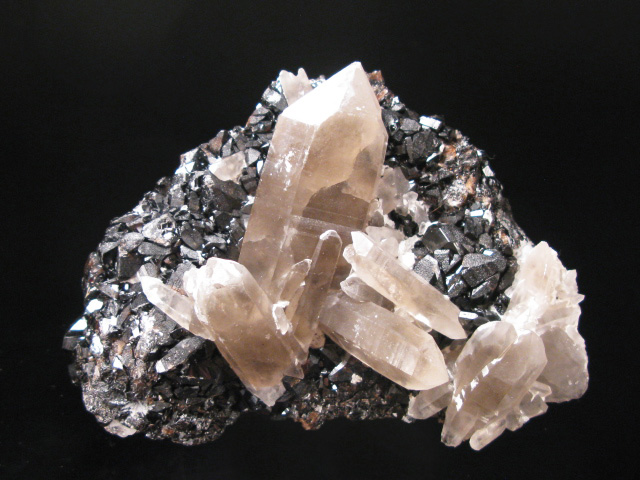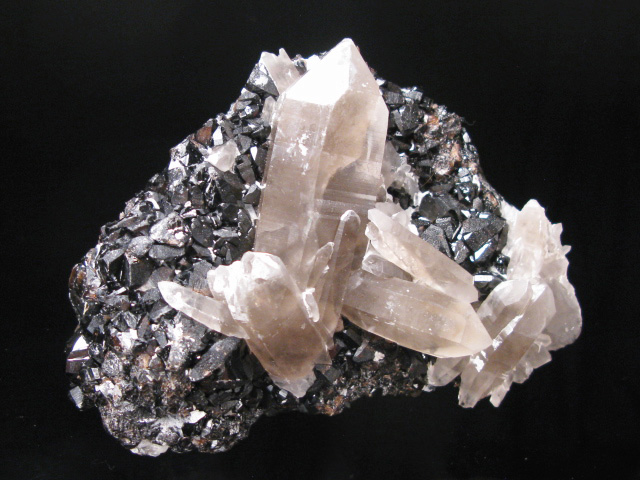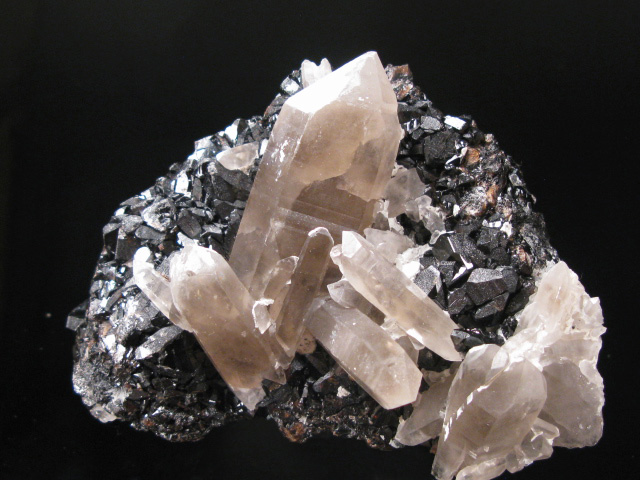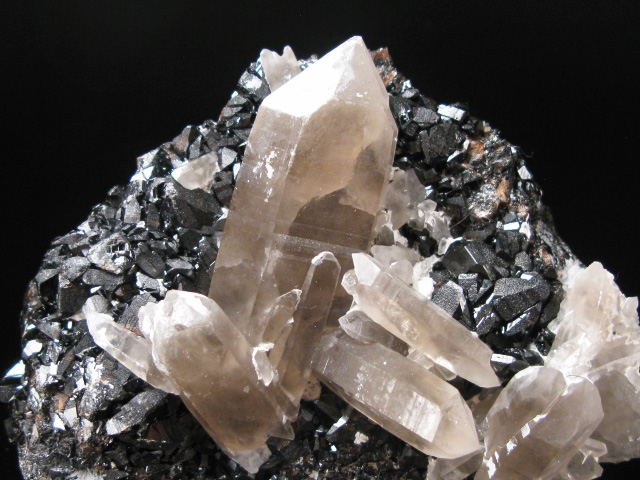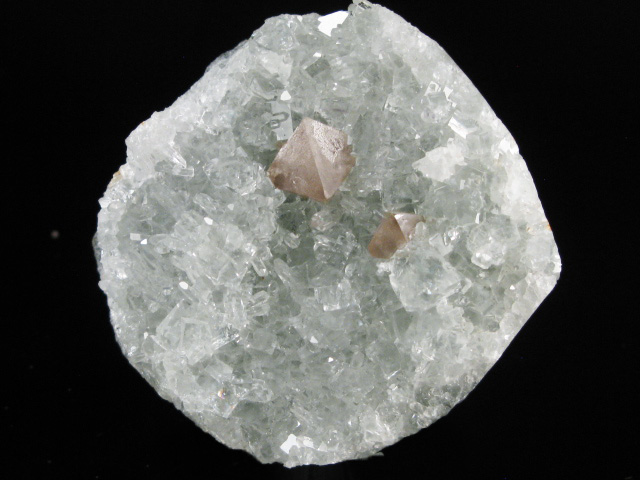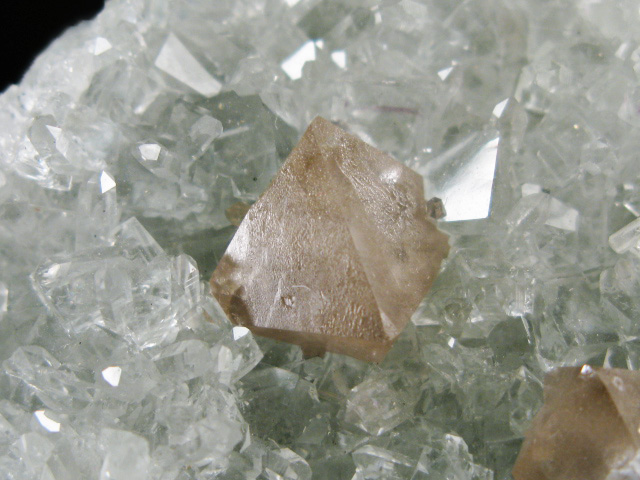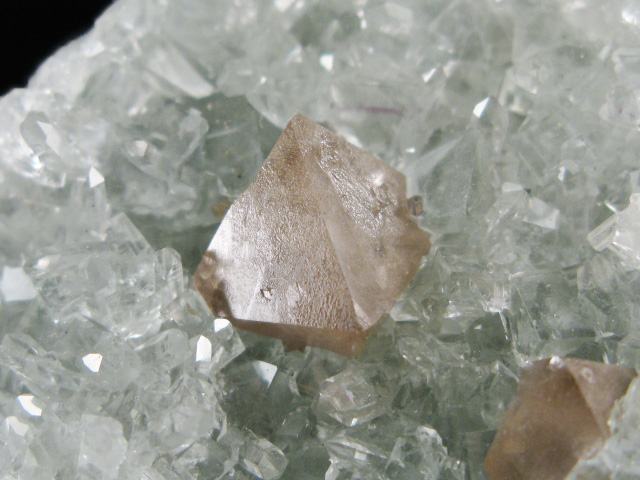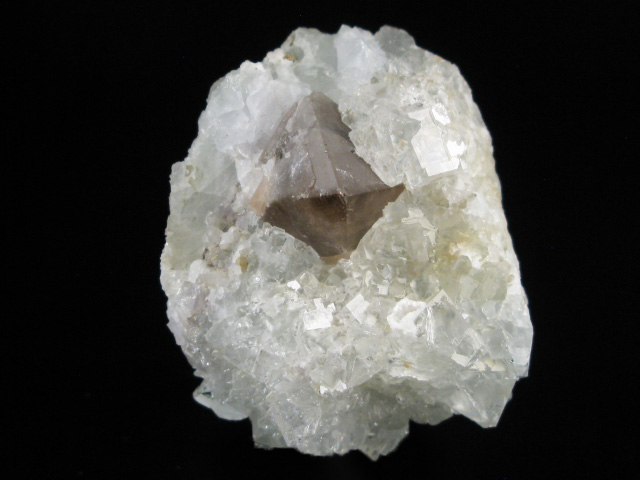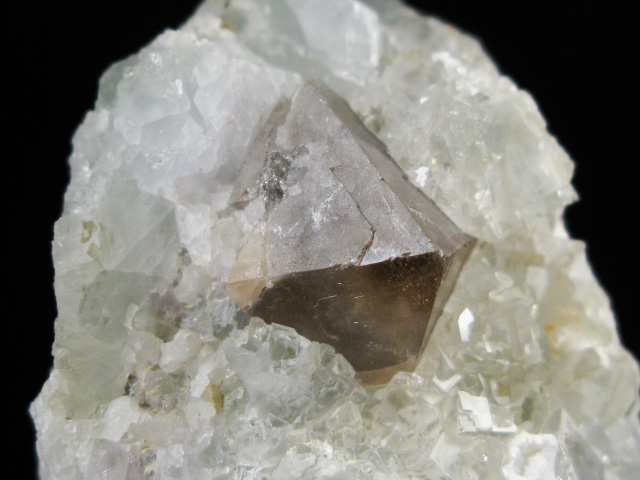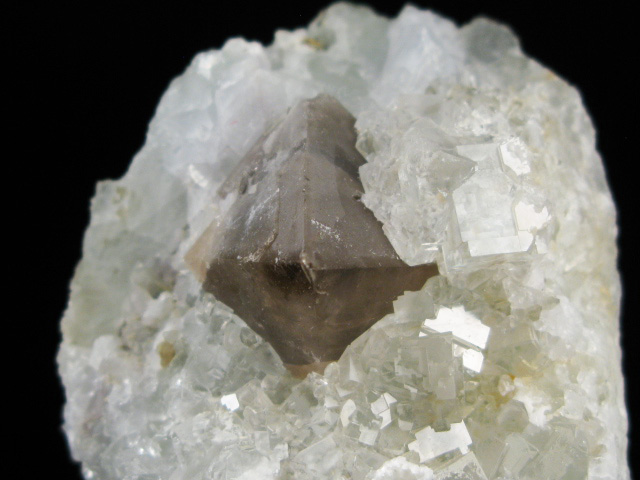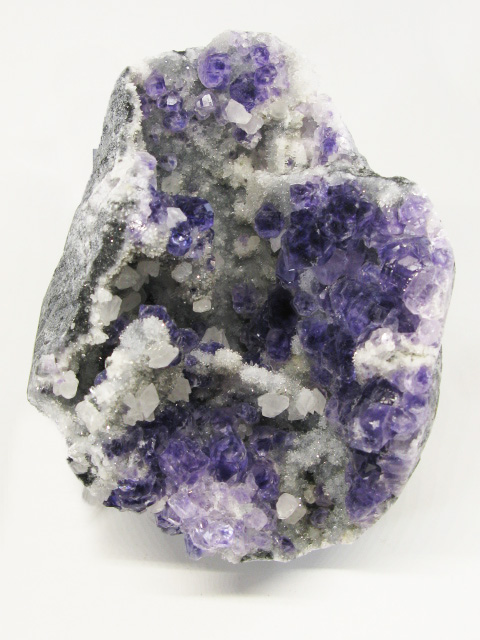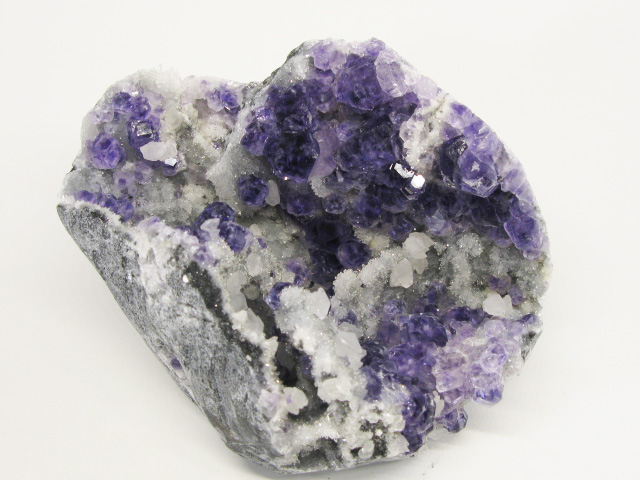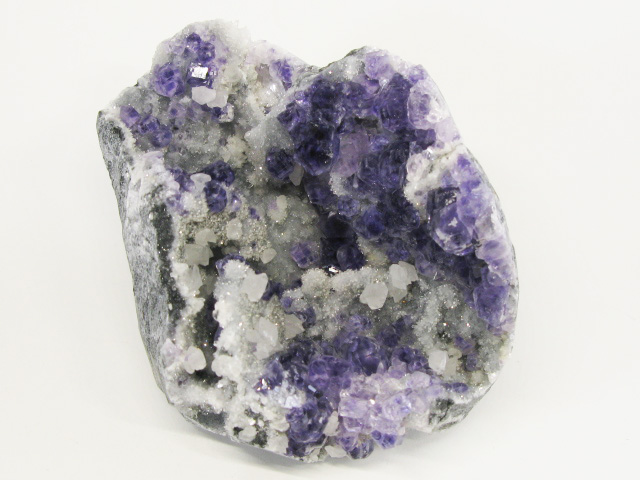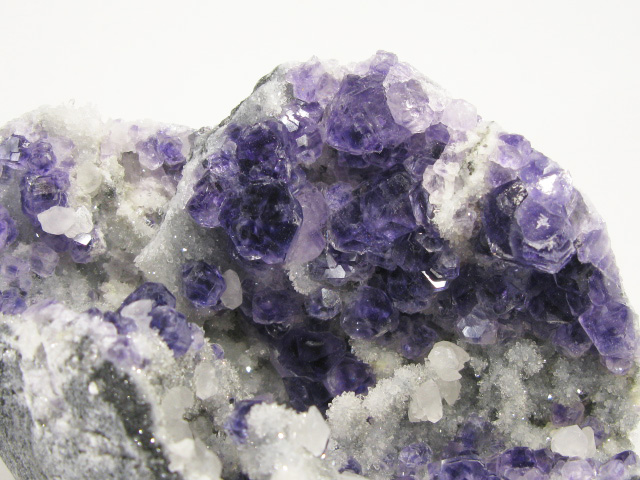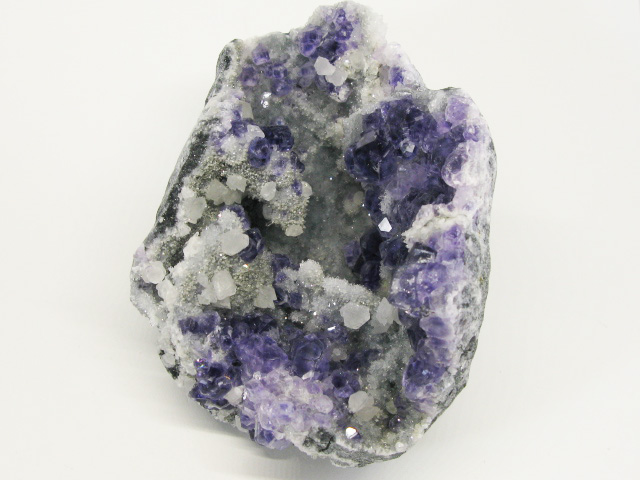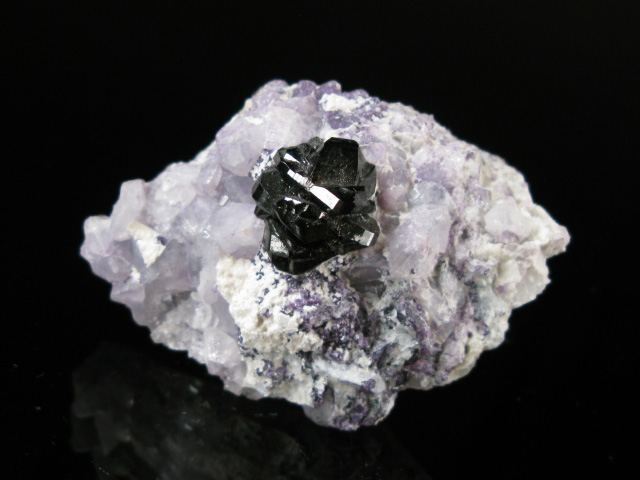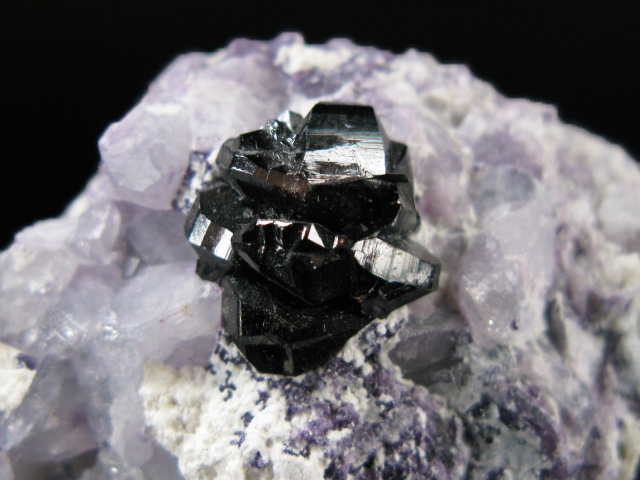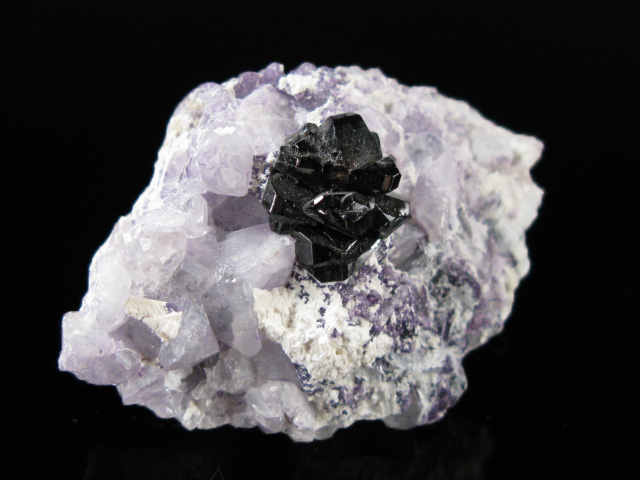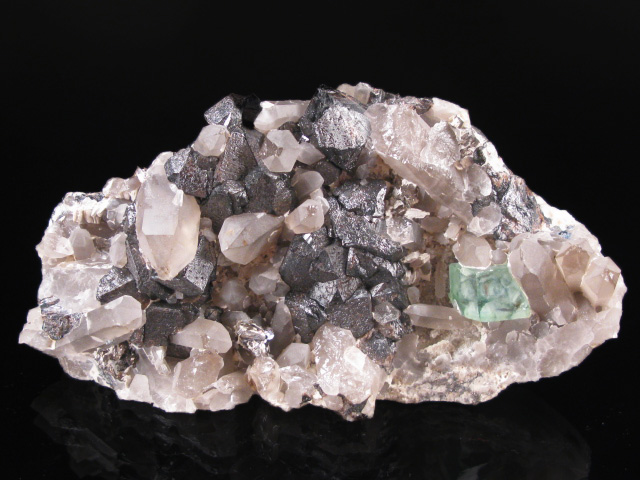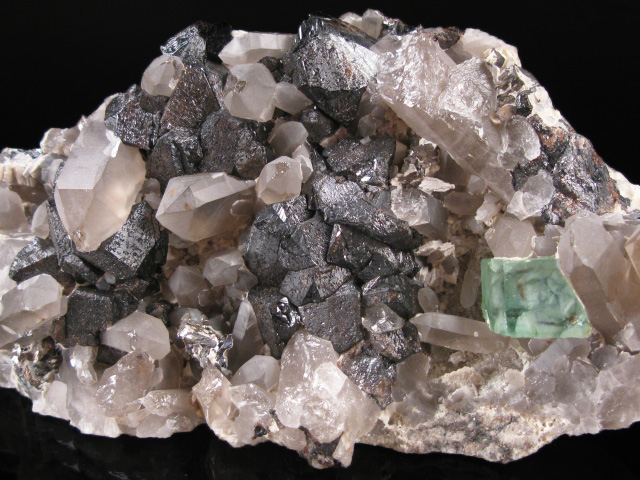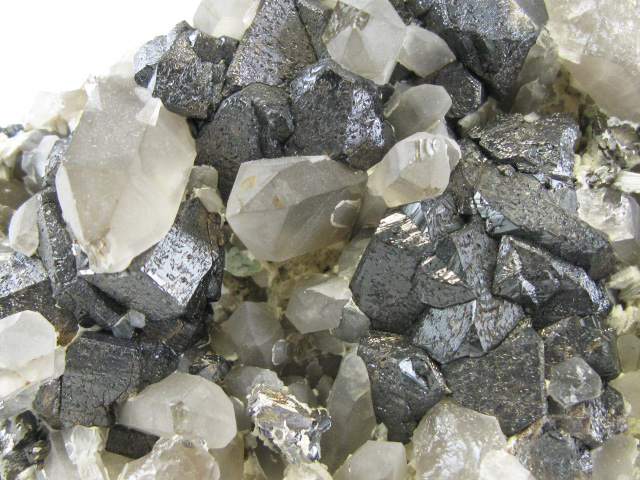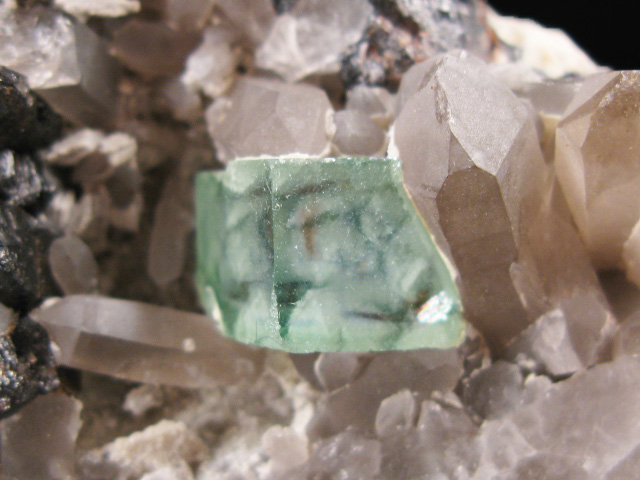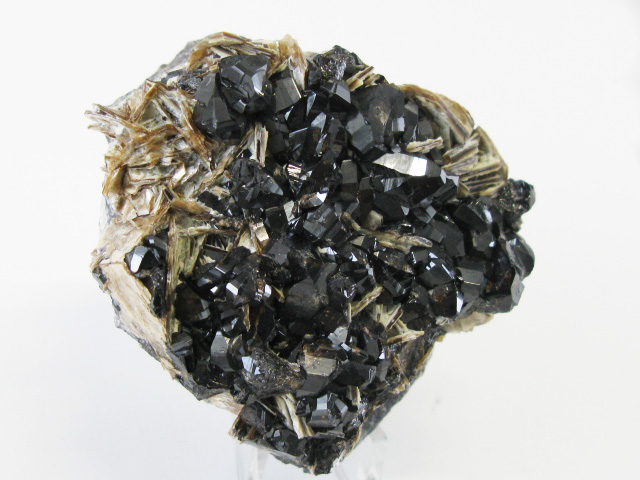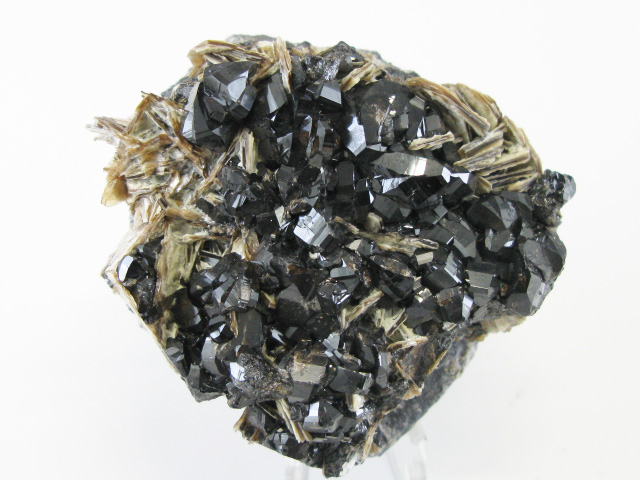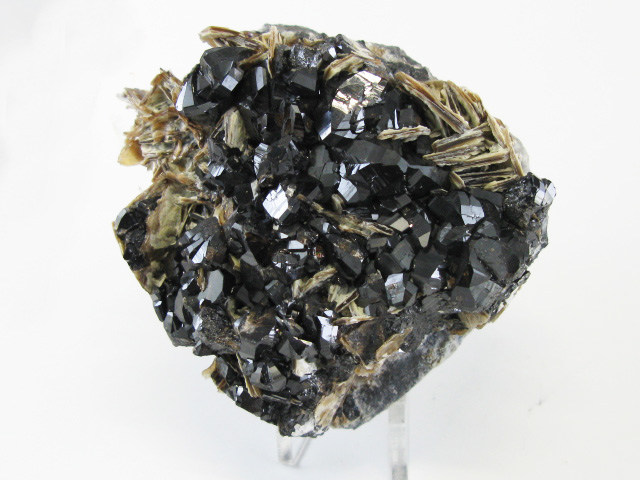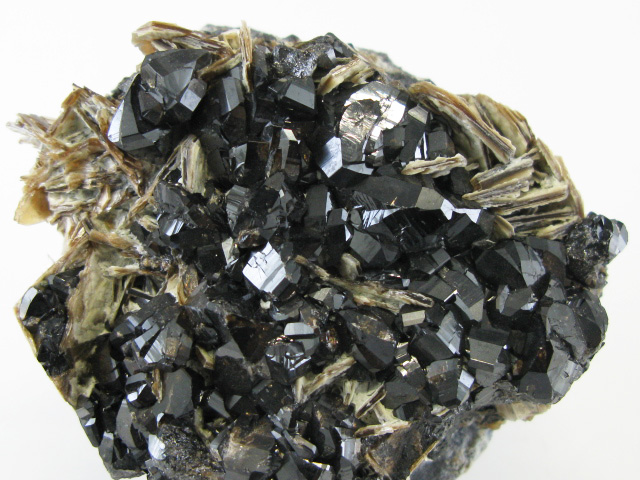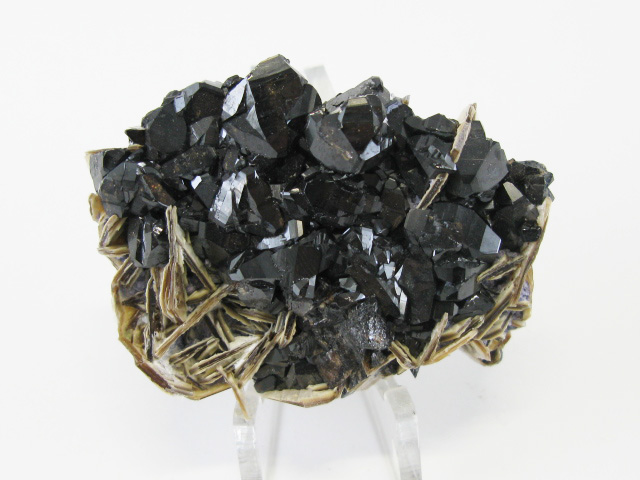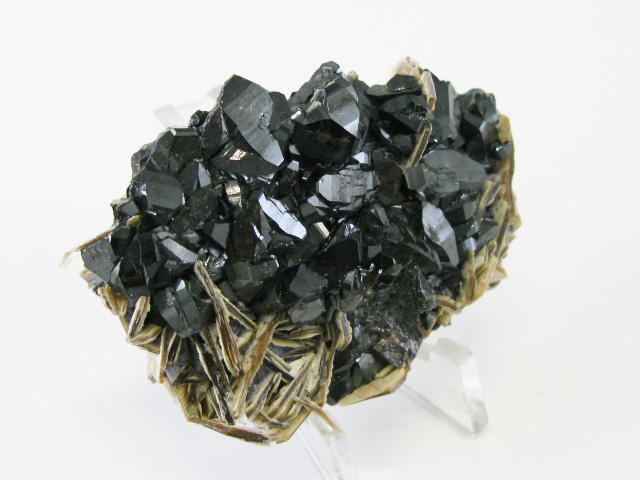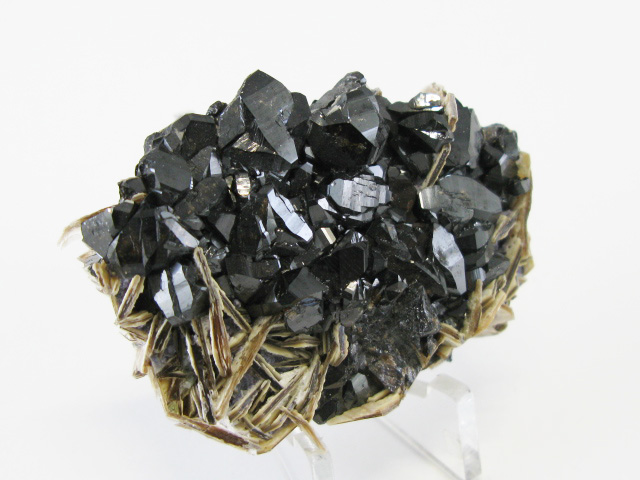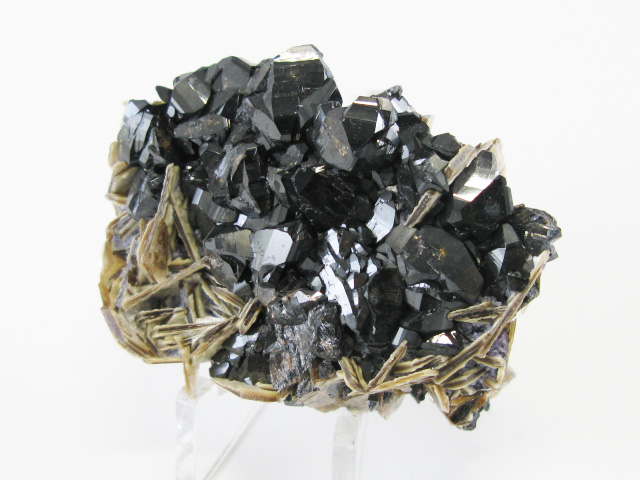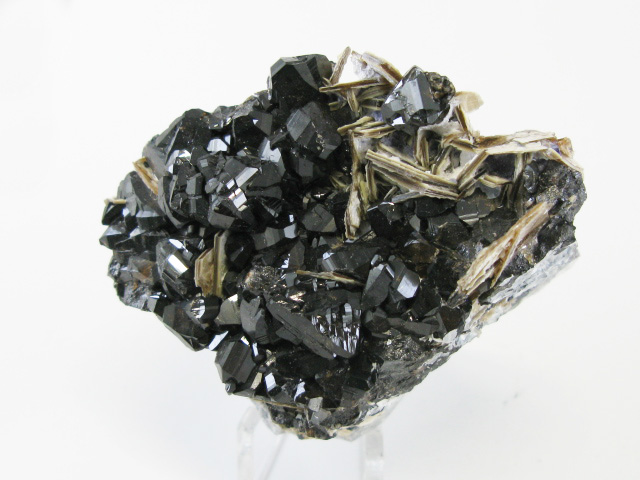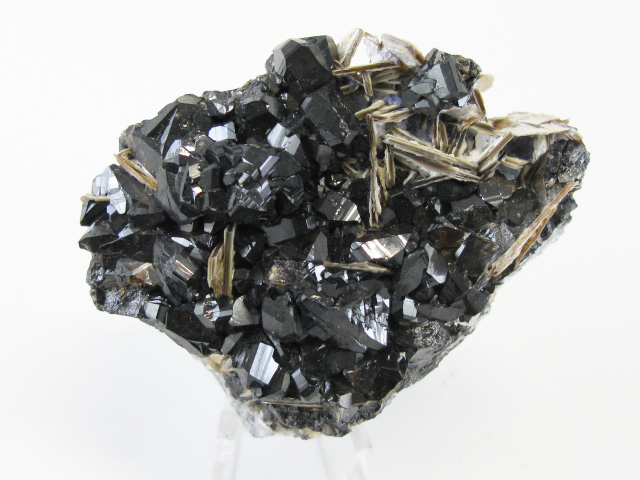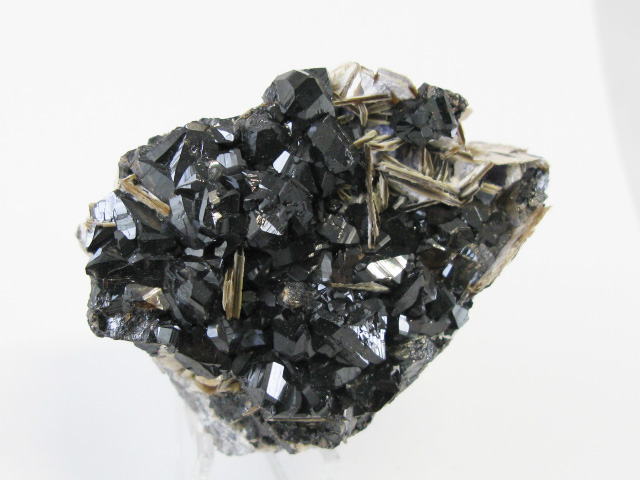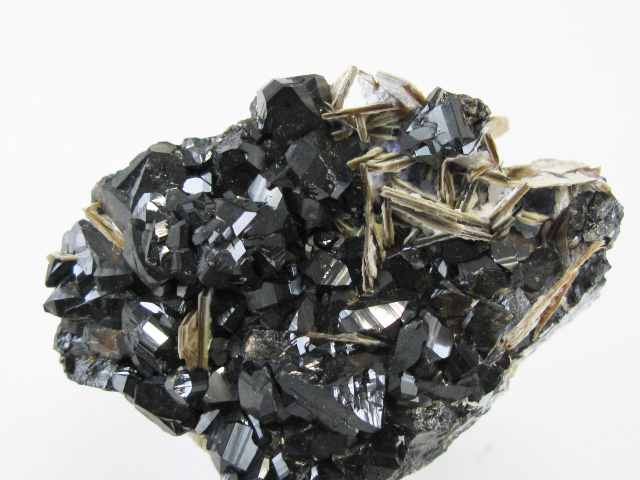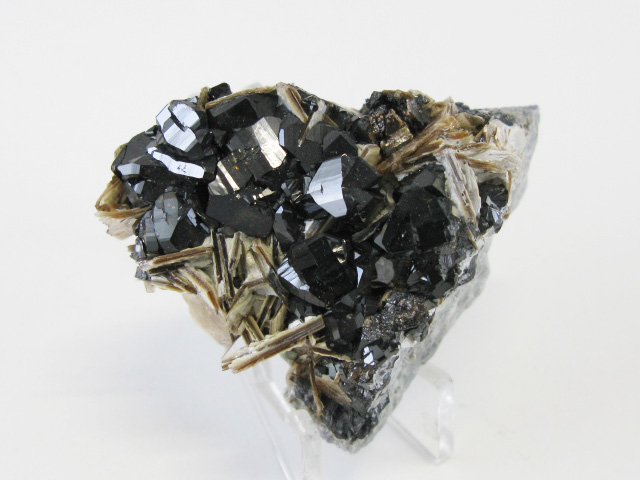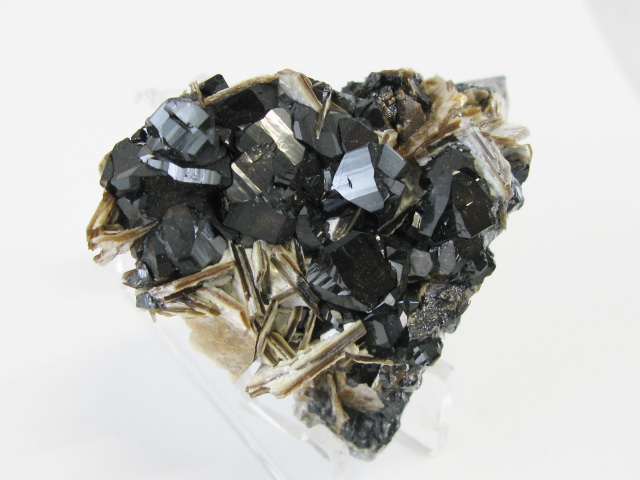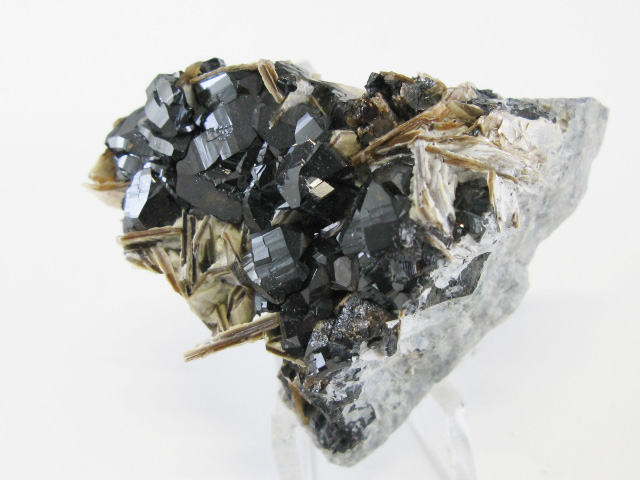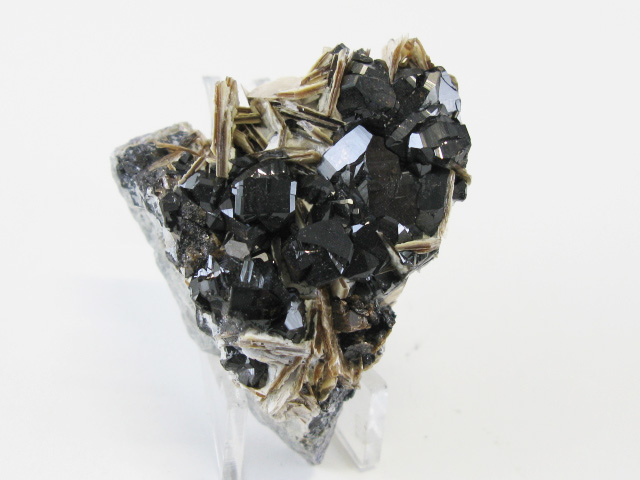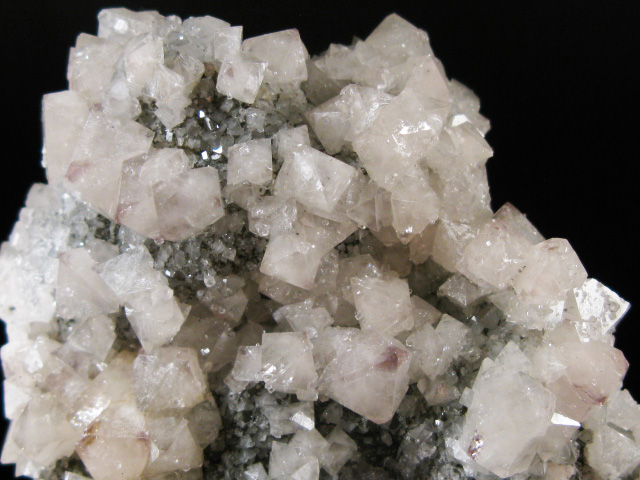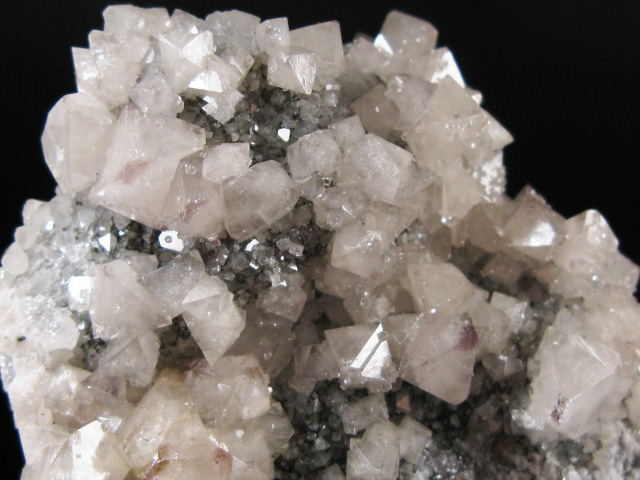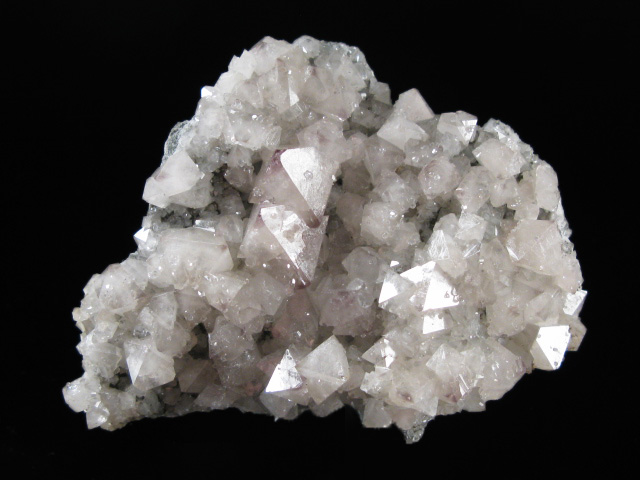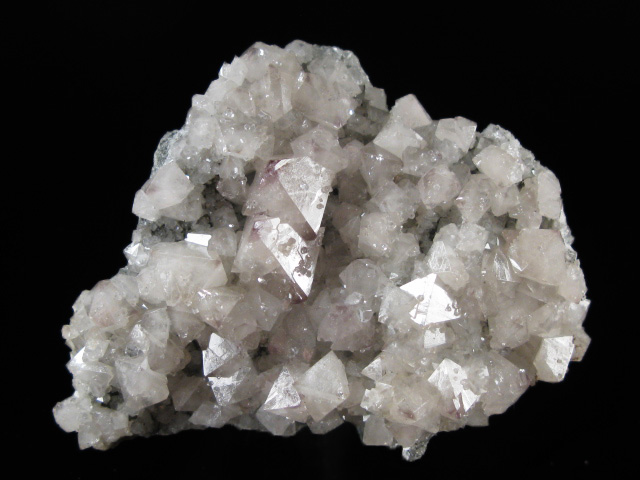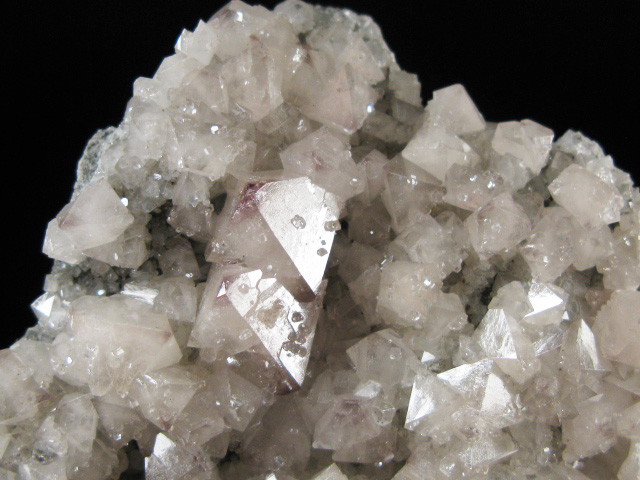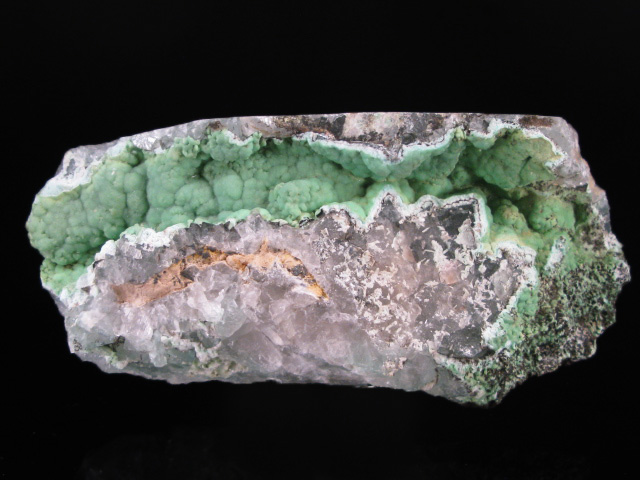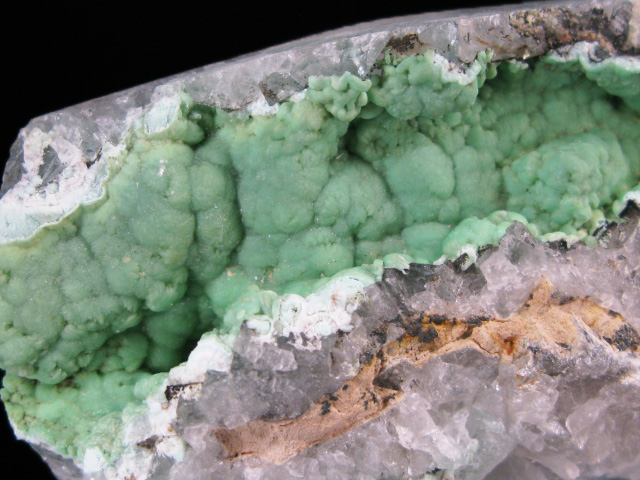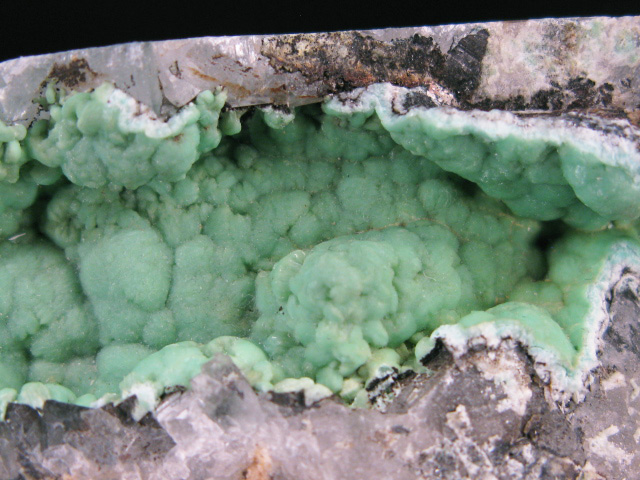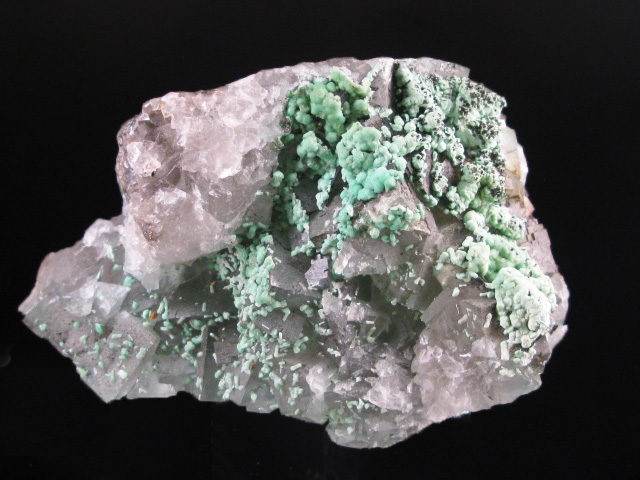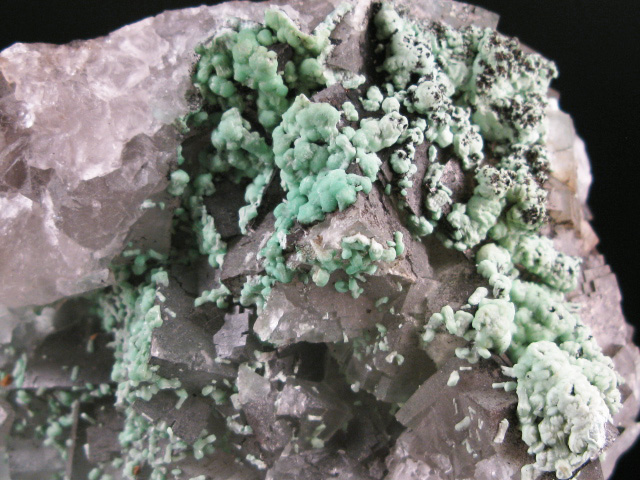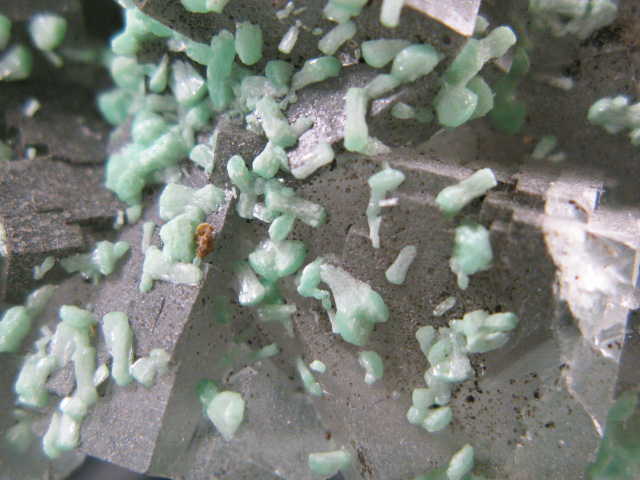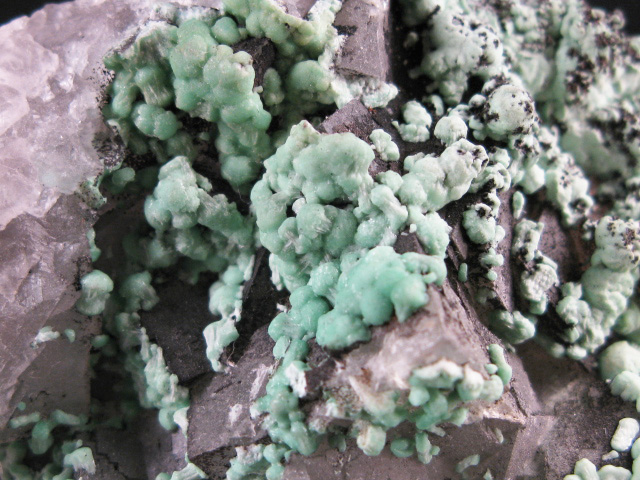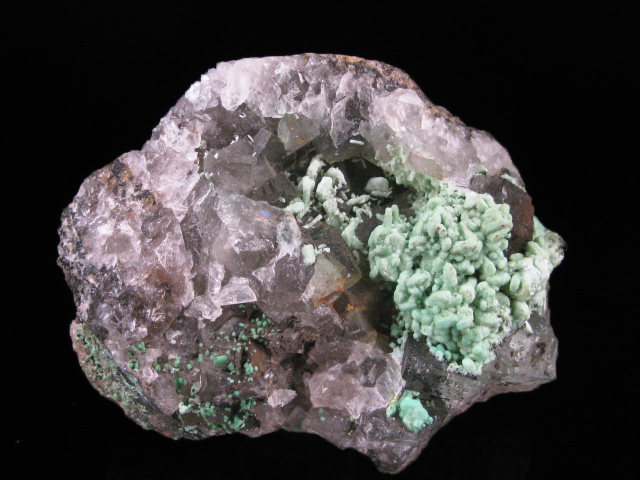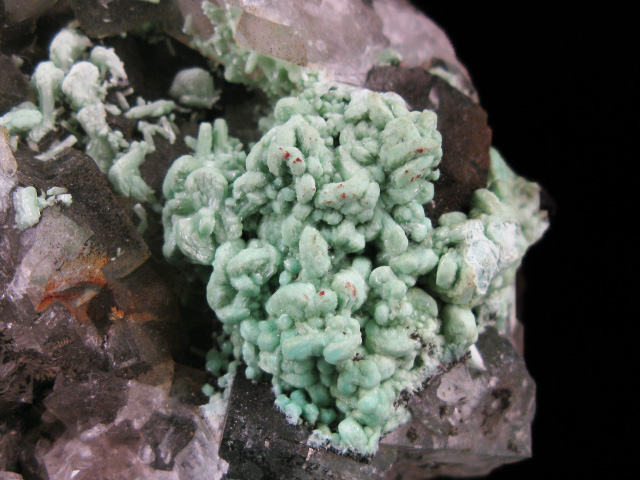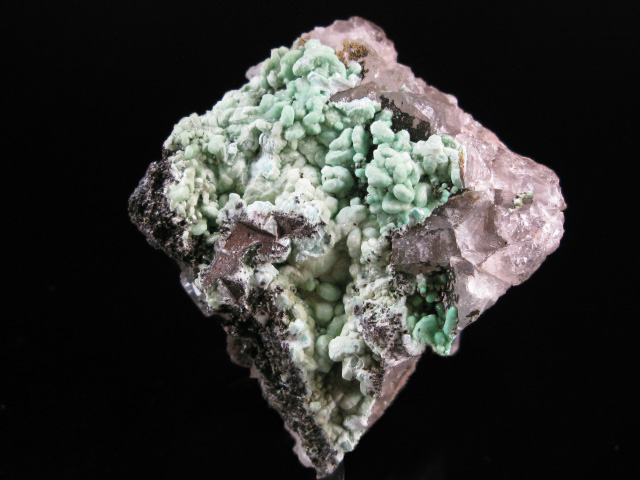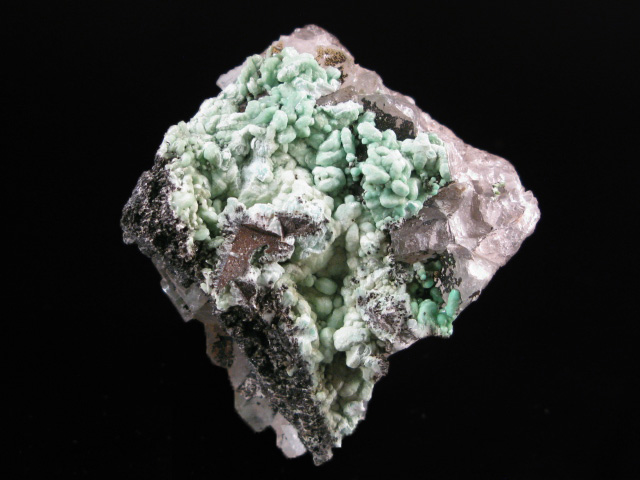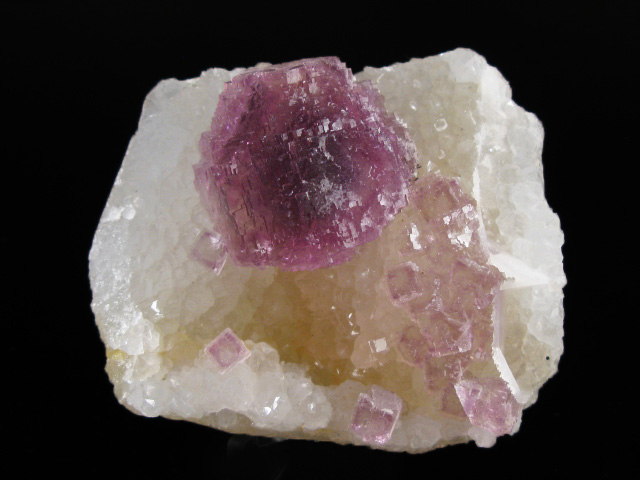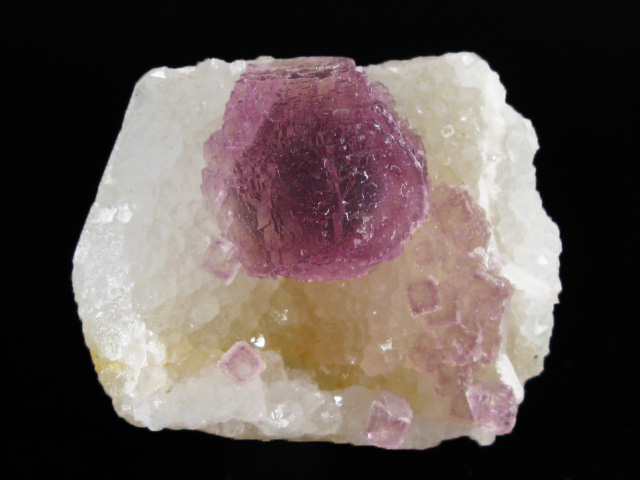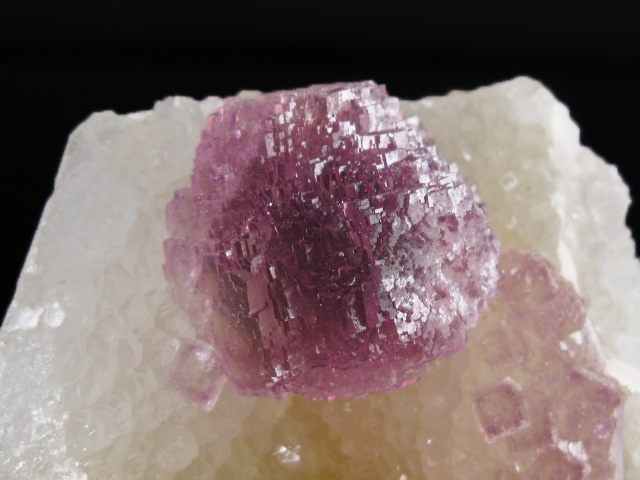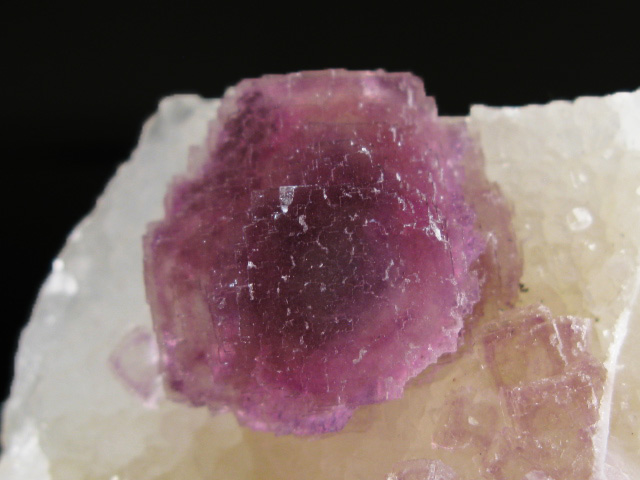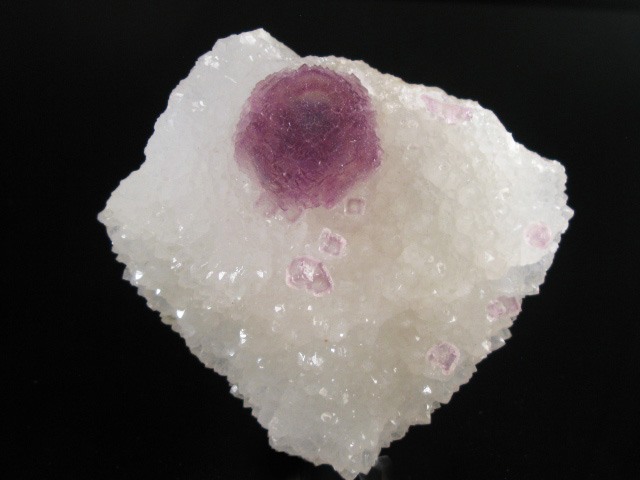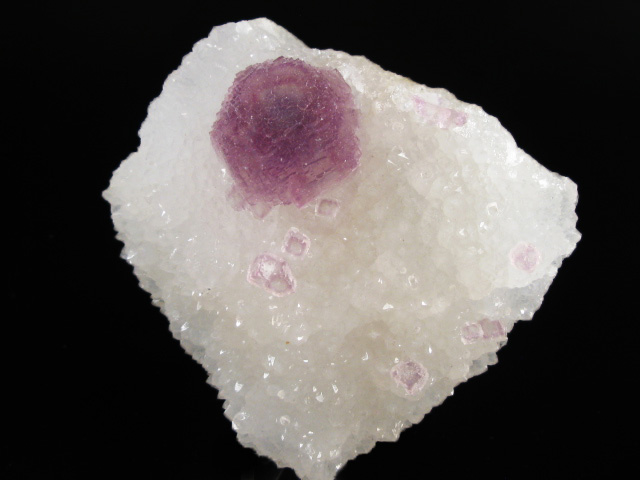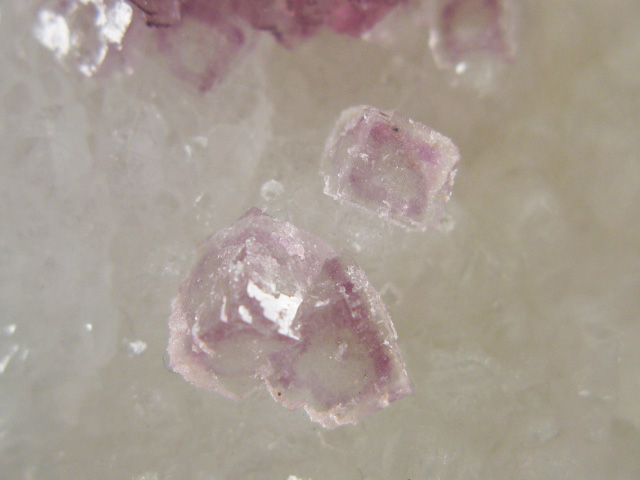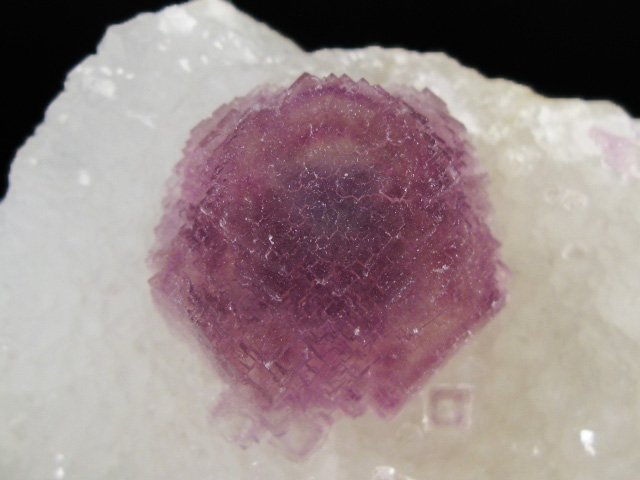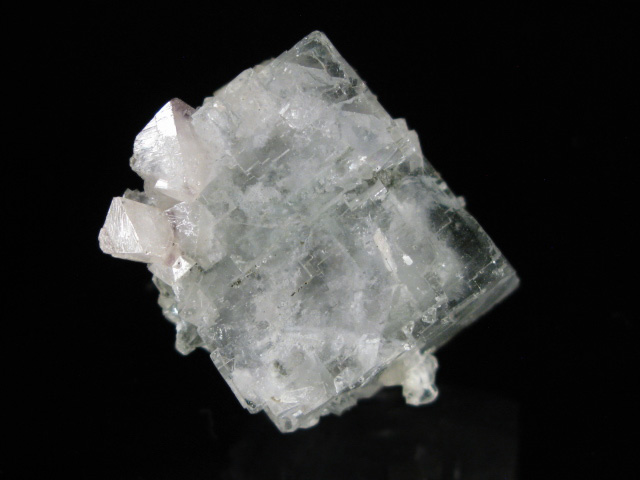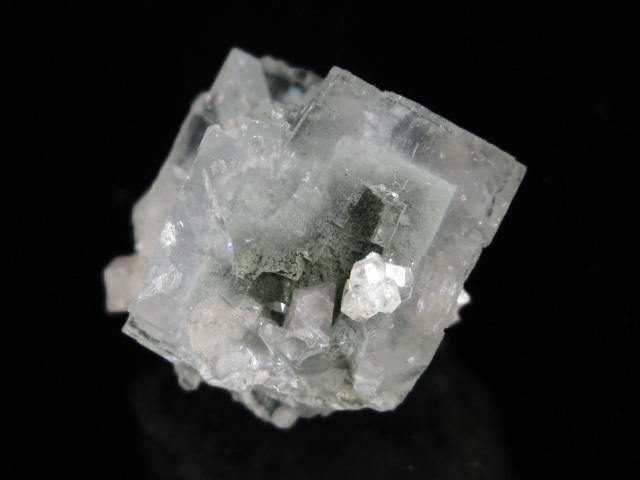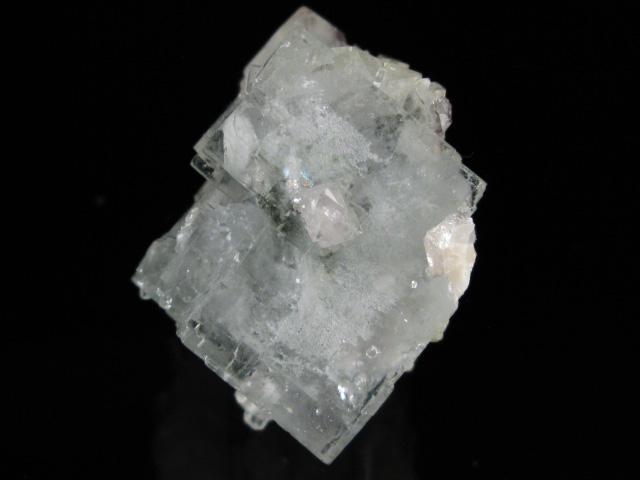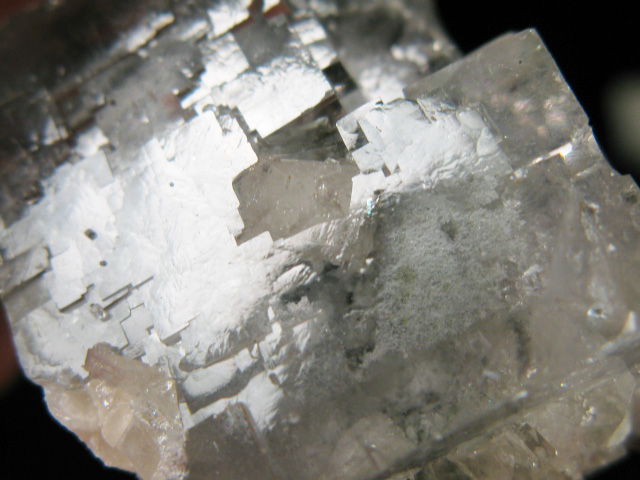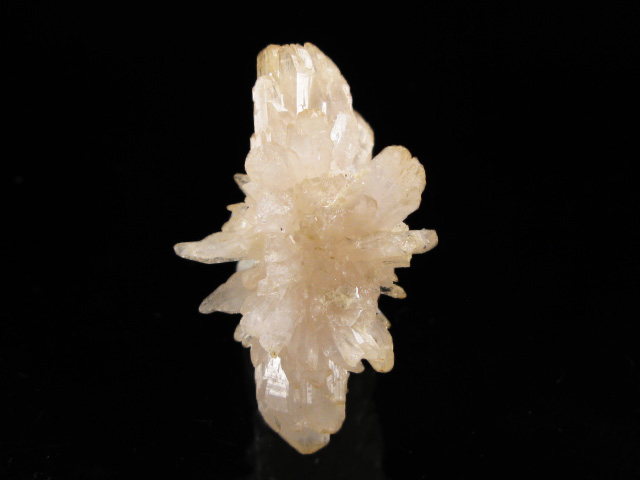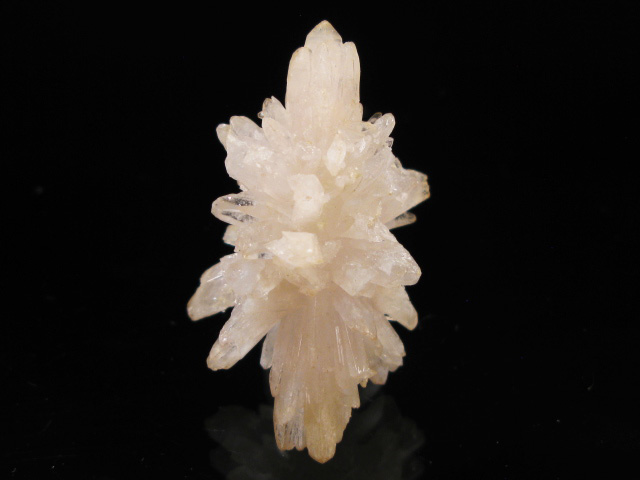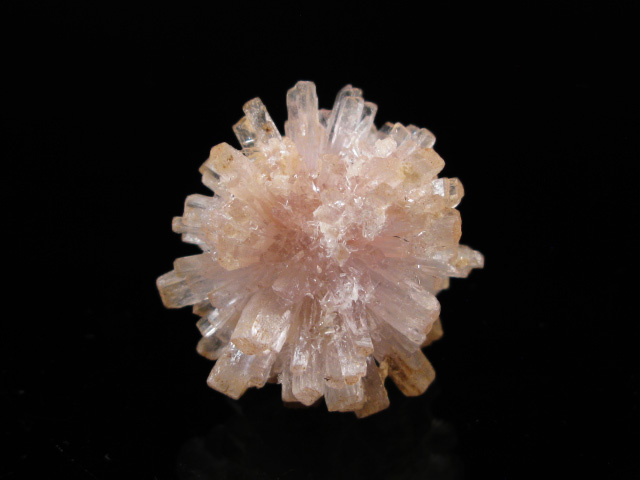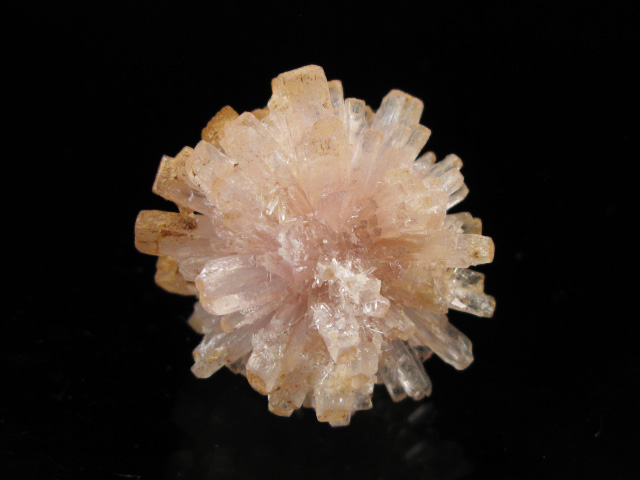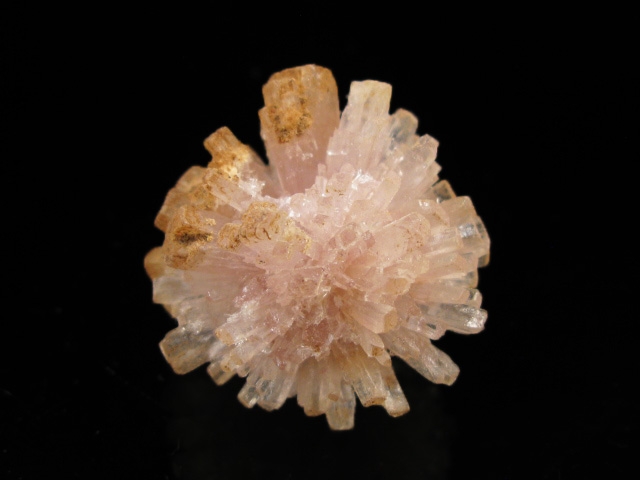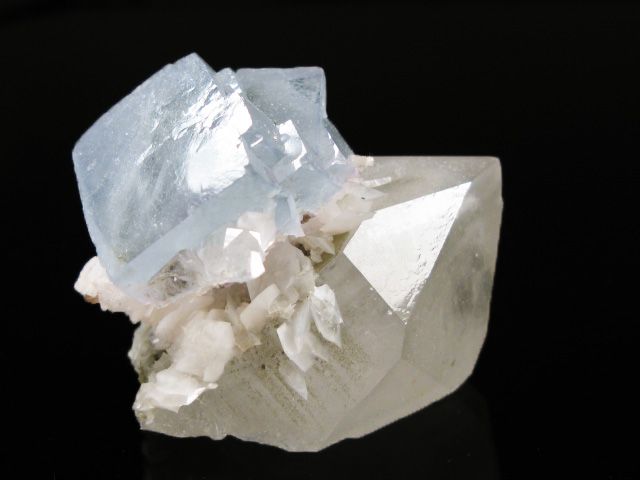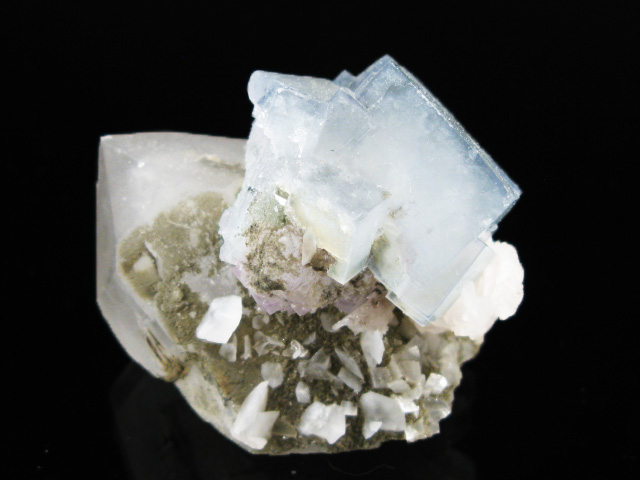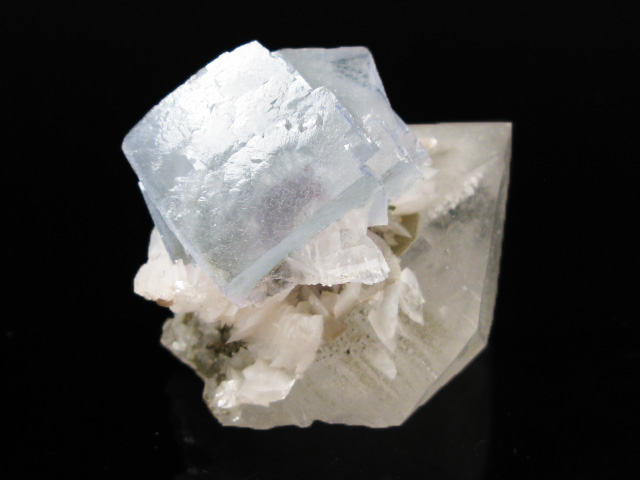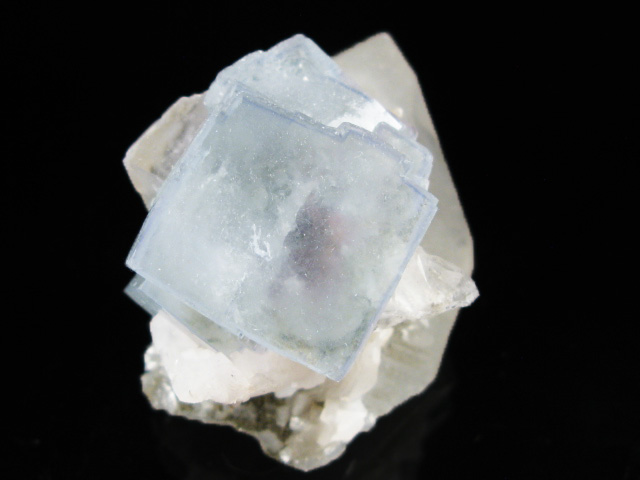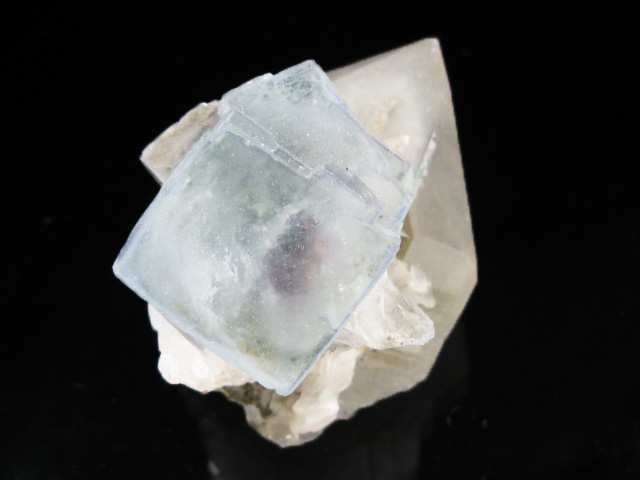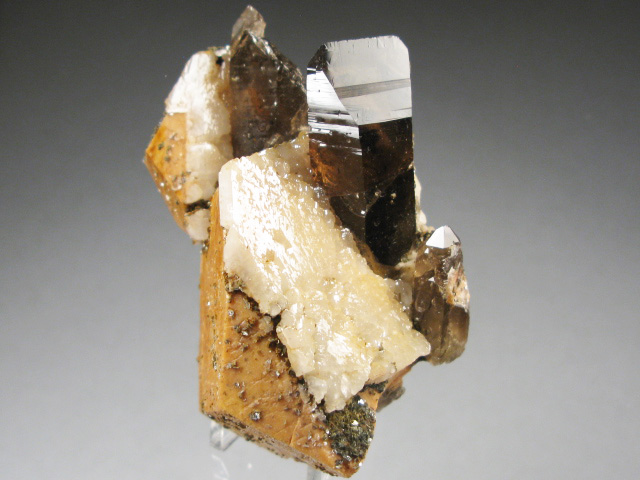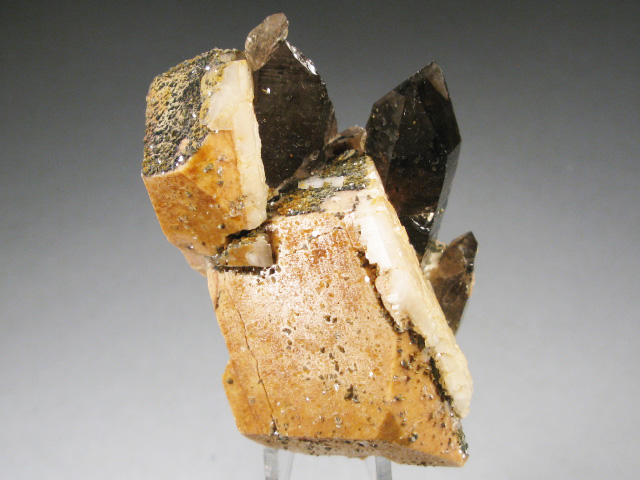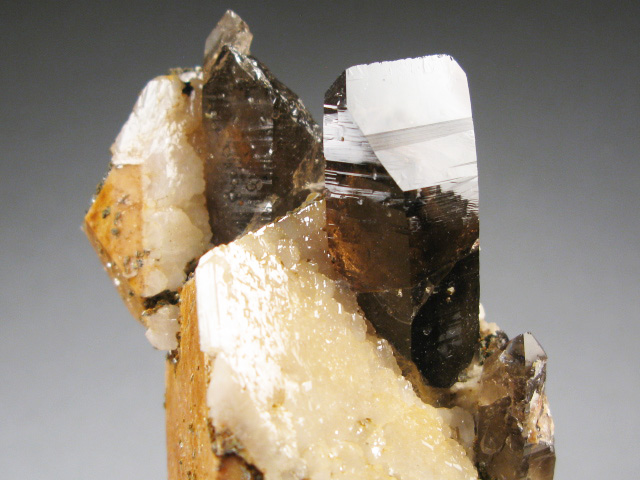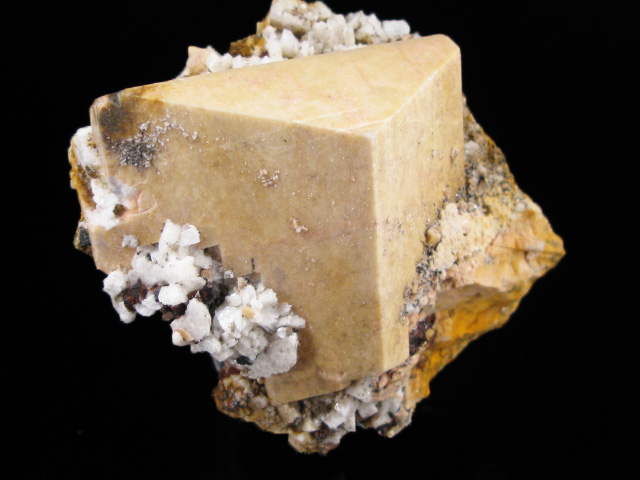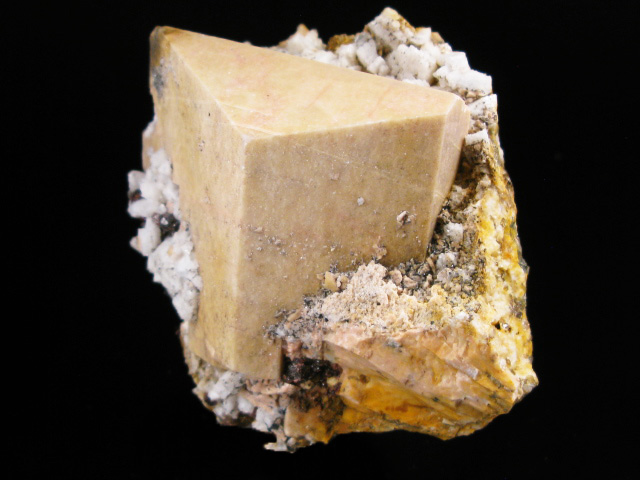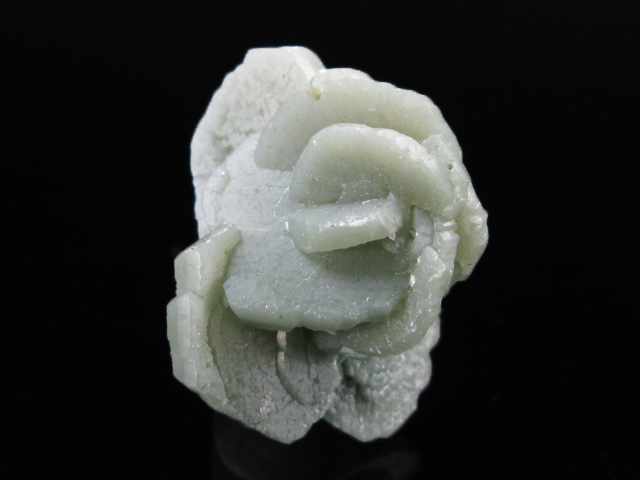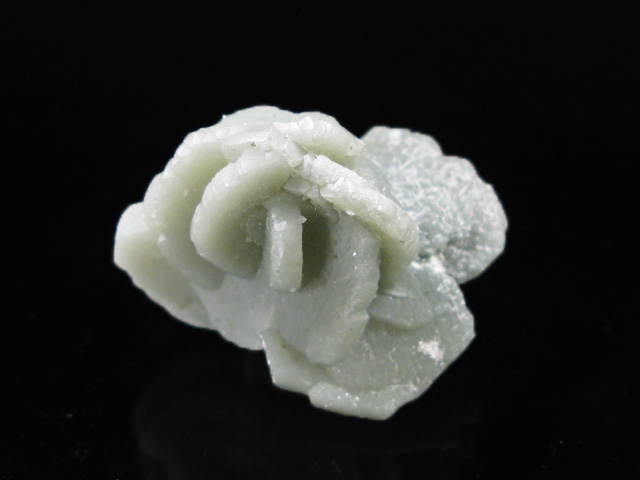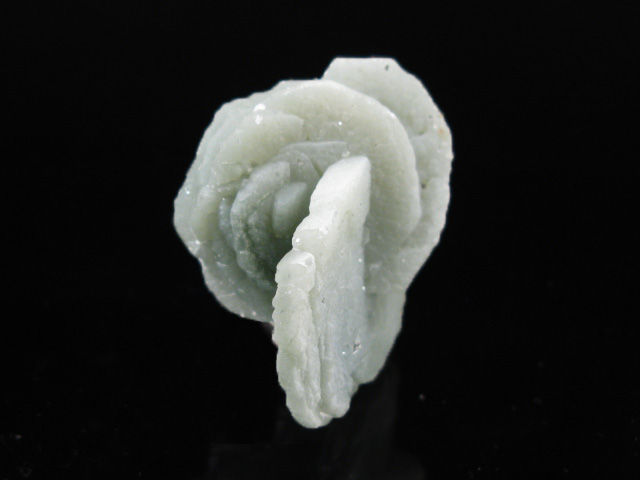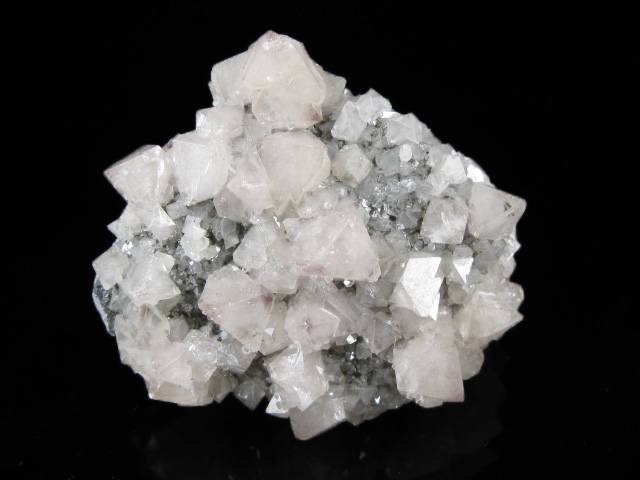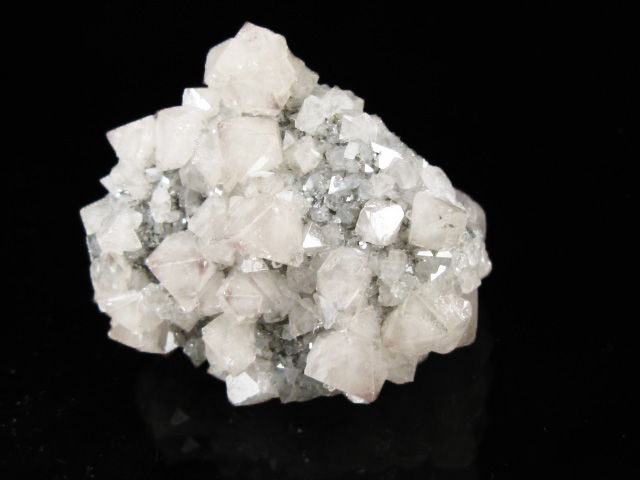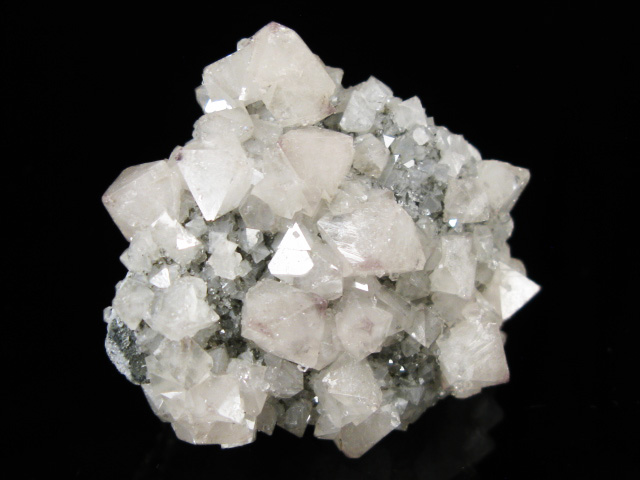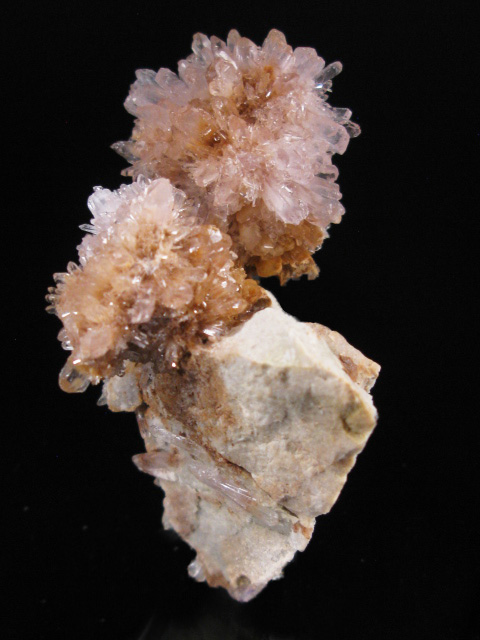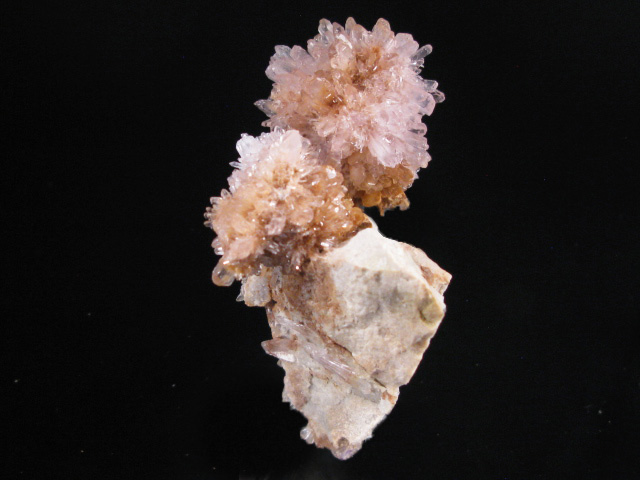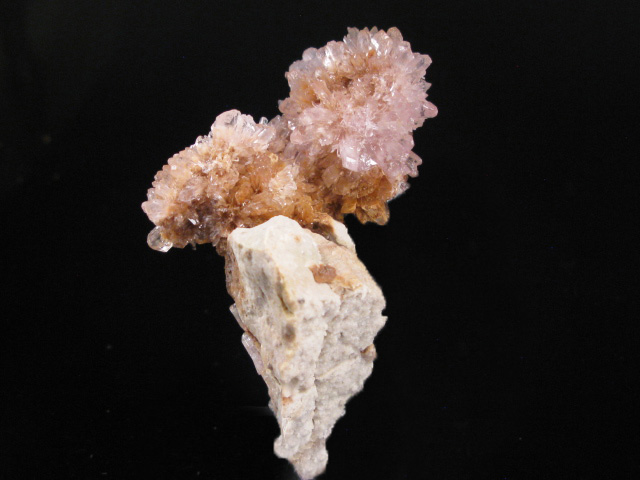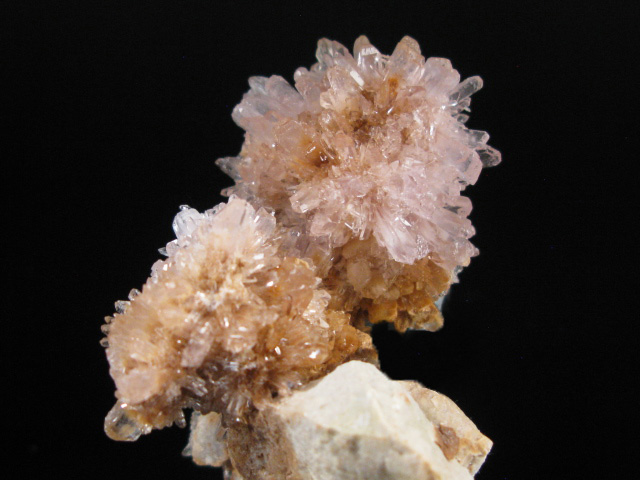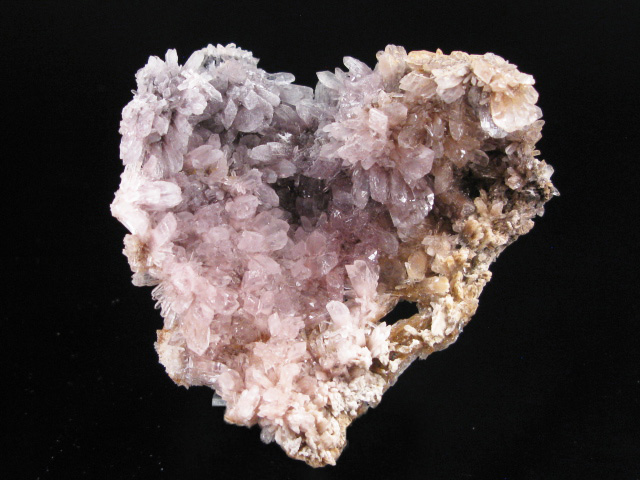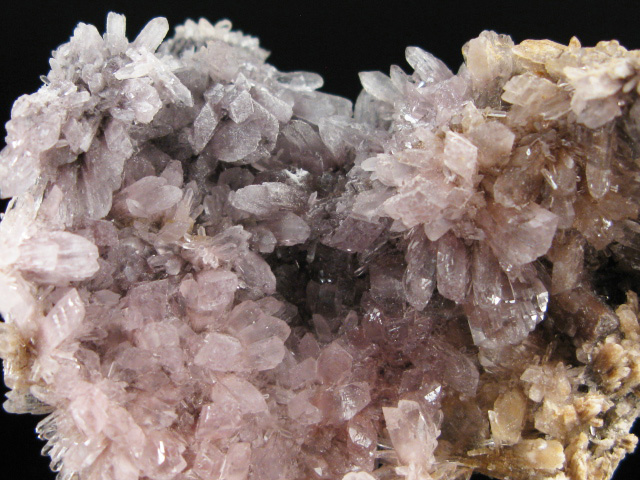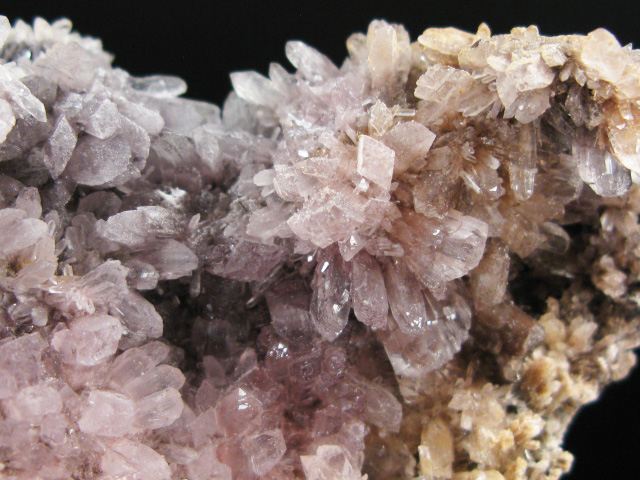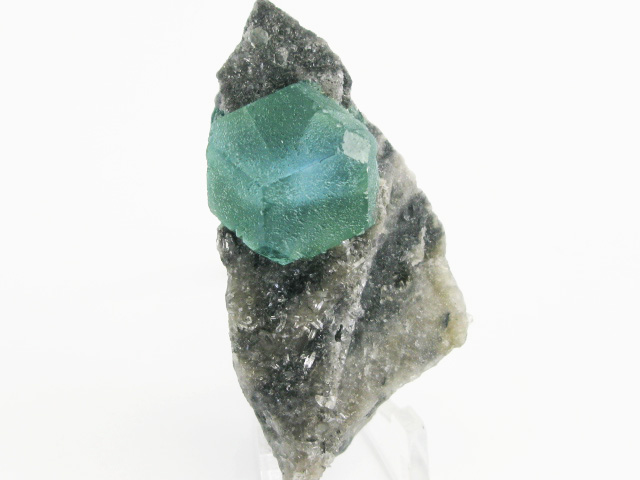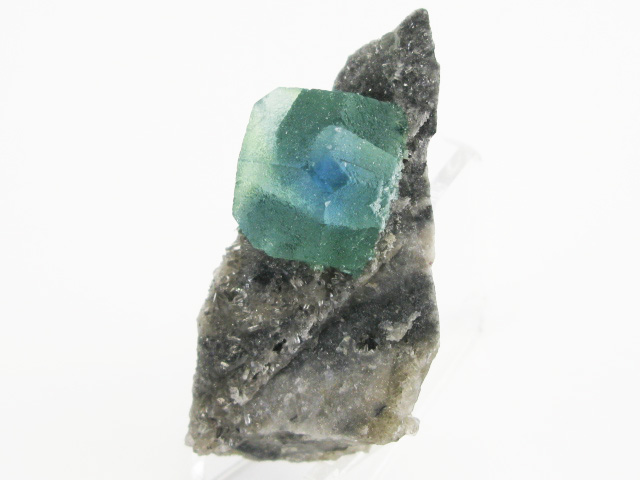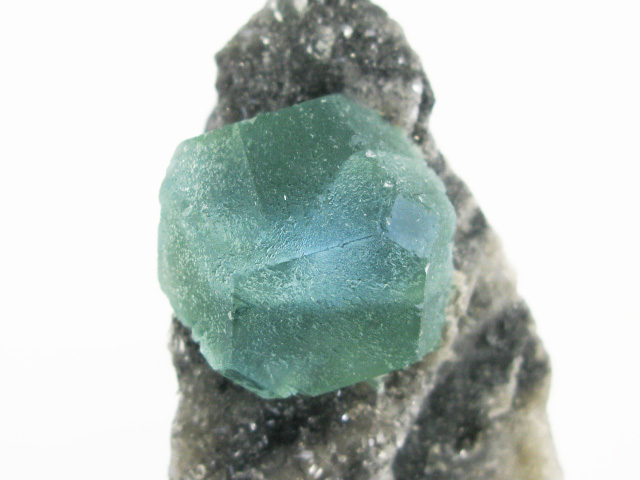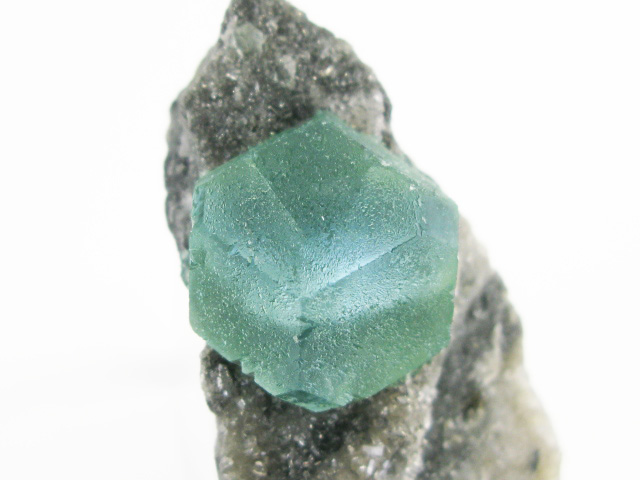China!
My favorite piece from the trip, and probably one of the most beautiful examples that I have seen of the species. Rarely is an example with such large crystals this well balanced, or so clean of damage. Most pieces one encounters are single crystals (especially in this size range), or if there is a cluster then the crystals will be arranged in a less appealing way—either too densely packed or just having loads of peripheral damage. Now, there are three very small chips on one edge so it is not 100% perfect, but compared to the obvious and unslightly breaks and chips one usually encounters, I would consider this acceptable.
The cluster even has a piece of matrix clinging to the side, almost perfectly balancing it visually. The presence of any rock matrix is almost unheard of for pieces from this locality—they are usually just sitting on a mass of dense, ugly stibnite crystals, if on anything at all. In this case the bit of rock serves less as a matrix than a visual accessory, and interestingly enough it doesn’t show any point of attachment either.
In my opinion, even the large 6 figure pieces with their huge nests of crystals, impressive as they are, lack the balance and beauty of this one.
It really is a spectacular piece-- I saw the thing once and
passed because of the price, but I knew I would regret it if I did not bring it
back with me. I will also point out: it
is not cheap, but my asking price is about 40% of what a “big dealer” would
have marked on an inferior piece of similar size
One of the main new finds I encountered on this trip were
cassiterite specimens from the Weila Situo Silver deposit. They varied in quality: some were densely
packed, others interspersed on plates of muscovite, or light purple topaz. The best, in my opinion, had well formed
crystals with good spacing and aesthetic associations. I purchased a large lot of this material, but
this was one of my 2 favorites, for its association with muscovite, and a
bluish-green fluorite crystal (the back half is cleaved). Contact on the top, but displays perfectly from the front.
Finding examples that didn't have a banged up display face was extremely hard—This was one of the best I saw, period.
A beautiful example of fluorite on a quartz plate. Unlike most of the Chinese fluorite on quartz
examples you see, these have not been etched out from under a layer of quartz,
so the fluorites retain their original luster, and do not require oiling. Furthermore, the matrix is actually composed
of quartz crystals, not the powdery white stuff that you typically see on
etched pieces, like virtually anything from De’An. Why does it matter? I think it gives more sparkle and makes the
pieces more visually appealing.
As with virtually all fluorites, the color varies with lighting-- this one is best under incandescent.
This is probably my second favorite specimen from the
trip. The surface of the purplish blue fluorite
is a bit altered, such that it has a whitish coating, though the overall form
makes for a beautiful combination. The
large octahedron sits on a plate of muscovite and very lustrous
cassiterite. There were hardly any
fluorite examples available from this location, most were beaten beyond
recognition (except for the color) or present as minute crystals somewhere on a
matrix. This was the best fluorite example I came across, and it is certainly
an interesting combination.
Minerals from this relatively deposit were one of the interesting surprises on this trip. This area is located in Inner Mongolia, near the more prolific Huanggang Mine.
A fantastic example of green fluorite, growing directly over purple crystals, all on a plate of white, etched quartz. I only saw two examples of the material, and a friend later confirmed that there had only been one small lot collected—the owner refused to break it up, and they were mostly large plates, but somehow two escaped. This was the smaller piece—the other that I saw was a large plate, but the arrangement of the purple and green crystals, and the etching were just unslightly.
I had to pay a bit of a premium for this, the owner was a bit hesitant to sell it without the larger junky one... but I really wanted to
offer it on the website—I mean, we've all seen thousands of fluorite specimens, but this is really quite unique.
A beautiful example from this new find—it features a cluster
of cassiterite crystals sitting on a plate of bluish fluorite crytsals. There is a chip on the cassiterite at the
tip, though it was still one of the most striking combination pieces that I saw
from the find.
A nice, saturated orange scheelite crystal siting on a
muscovite matrix, accompanied by a quartz crystal and a small aquamarine near
the base.
These very uniquely blue fluorites came out about 1-2 years
ago, but usually consisted of plates of somewhat smaller, densely packed
crystals. The find was long depleted and
specimens mostly dispersed into collections, but I did find this one-- I think the distinctness and size of the
crystal prevented it from getting sold in a lot of mediocre pieces. With that said, I ended up paying a bit of a
premium for it, but as with a number of pieces in this update, it was different
and beautiful enough that I wanted to be able to offer it on the website. China
is well known for its green fluorite, and to a lesser extent its purples, but
blue has never been a particularly common color from its various mines.
A beautiful example of scheelite from a new find. This area
is mainly known for its pale green fluorite, but I would consider this to be a
significant find of the species in China, joining the discoveries Ping Wu,
Yaogangxian, and Inner Mongolia. What makes
these unique is the richness of the scheelite—the plates are entirely covered
with scheelite octahedrons. I have seen
larger crystals from elsewhere, but this desnsity and coverage of crystals is
quite unusual for the species, from anywhere in the world.
A beautiful example of blue fluorite with scattered
purpleish blue phantoming, from a recent find at the Yindu Mine, in Inner
Mongolia. The majority of specimens from
this area have come from Huanggang, I have seen some pieces (most notably of
pyrrhotite) from this mine over the last several years, but nowhere near the
quantity of specimens that has come from Huanggang. On this
trip however, I did come across a number of these fluorites—unfortunately all
were damaged. It may sound ridiculous,
but this was the one piece I found that was entirely clean— even a few that
seemed to be almost perfect, upon closer inspection, turned out to have
issues. The color is a spectacular aqua blue, and I really wanted to bring examples back. Luckily I was able to find this one.... it's a bit difficult to express how annoyed I was getting by the end of the trip, when every single piece I saw kept having damage.
Green quartz from Inner Mongolia started coming out soon
after the initial discovery of specimens at the Huanggang Mine in 2010, and
since then there have been numerous different habits unearthed. I often see tiny little doubly terminated
prisms that are popular with the metaphysical crowd, and I have on a few
occasions come across calcite plates, pseudomorphed into green quartz. This piece aesthetically combines the (not
pseudomorphed) calcite plates with a sprinkling of doubly terminated green
quartz crystals. It’s a very beautiful combination, and quite unusual…. It
seems that you only ever see broken calcite/ calcite psudomorphs, or the little
quartz crystals without a matrix. This
piece was fortunately preserved in a way that aesthetically combines both.
A beautiful “fluorite geode,” continuing numerous deep
purple fluorites of the variety that has been marketed as “tanzanite
colored.” Although not the largest, this
was my favorite piece from the group.
Most fluorite specimens, especially from China, seem to be flat plates,
or clusters of crystals. Seldom do you
get this geode-like appearance, and the contrast with the white quartz combined
with the small windows at the back and the luster of the fluorite, make for a
particularly beautiful display.
I saw a group of these large garnet crystals from the
northeastern corner of Hunan county, and this was the only complete
crystal. It is sitting on a thin bit of
matrix, though is not actually broken on the back-- there are clean, sharp faces right up until it runs into the matrix. The sharpness is incredible,
and it’s quite hefty. Such good, well-formed
crystals this size are really not seen very often, except perhaps in schists,
but even those seem to lack the sharpness and smoothness that this crystal has,
on account of growing into the surrounding mica. It’s from a rather unusual locality, too—unfortunately
I couldn’t get anything more precise than the county, but the only other thing
I have ever seen from the area are the autunites.
A nice example of fluorite on a quartz plate. Unlike most of the Chinese fluorite on quartz examples you see, these have not been etched out from under a layer of quartz, so the matrix is actually composed of quartz crystals, not the powdery white stuff that you typically see on etched pieces ( like virtually anything from De’An) Why does it matter? I think it gives more sparkle and makes the pieces more visually appealing.
As with virtually all fluorites, the color varies with lighting-- this one is best under incandescent.
One of the interesting surprises was a major new find of
cassiterite from the relatively new Weilasituo silver deposit. This are is located in Inner Mongolia, near
the more prolific Huanggang Mine. China
has 4 primary casitterite localities—1) the muscovite combinations from the the
scheelite locality (Mt. Xuebaoding), 2) dark crystals from Jaingxi province, 3)
the gem brown crystals from Yunnan and 4)
these new examples from Weilasituo in Inner Mongolia.
This probably looks more impressive than it is-- there is notable peripheral damage near the top, including to the termination of the rich hand crystal. Still, the combination of lustrous cassiterite with quartz and very sharp muscovite makes it a good example of the typical habit from this mine, though at a relatively lower price.
If you cut it in half, you could actually have two pretty good specimens.....
Another interesting new find were these scheelite and very light green fluorite combinations, an association that I found quite unique and visually appealing. Scheelite is not particularly well known from this area, though such combinations did come out approximately 25 years ago.
The pieces were apparently found 3 days before I arrived in
the area, so I was a bit lucky in that sense. There was only one lot available
and I bought the whole thing—most of the pieces were damaged, so the purchase
was basically made just to obtain the few good ones, the best of which I’m
posting here
Chinese creedite is not exactly new, but good purplish
examples are quite rare, with virtually all being white or stained by iron oxide. I came across a
group of pieces with good color, and selected the best few, this is one of
them. Purple is perhaps the most sought
after color for the species, with the best known examples having been found
quite a while ago in Kazakhstan, Mexico (old pieces from Santa Eualia, not the
mine that produces the orange wholesale stuff) and Nevada in the USA.
A beautiful example of a well formed scheelite crystal on an
iron stained muscovite matrix. The iron
staining could easily be removed to increase the contrast, but I actually liked
the appearance, so I left it as is.
Considering how drastically the prices of these things have increased in
the last few years, I’d say this is quite reasonable for a damage free example.
Mt. Xuebaoding is known for a few species, primarily its scheelite, aquamarine, and kesterite. Perhaps the rarest of the “main species” however, is fluorite. I only saw a few examples, and this is one of only two that were in good condition. Like the most of the scheelites and aquamarines from this locality, this piece displays the typical mica association, with the main fluorite sitting on a bed of muscovite. It lacks a bit in color, but if you know your Chinese minerals, then you understand how rare and special this is—and to find one that isn’t broken, neither the easily cleavable fluorite nor the delicate muscovite—is particularly unusual.
I paid a bit of a premium for this, but like a few things in
this update, I felt it was rare, unusual, and beautiful enough to be worth it….and
I really wanted to post them on the site. So, after much negotiation, I am able to offer
this and the few others at a price that I think is reasonable, and still well
below what you’d see them for on other sites…. That is, if you can even find
something like this offered elsewhere.
Mt. Xuebaoding is known for a few species, primarily its scheelite, aquamarine, and kesterite. Perhaps the rarest of the “main species” however, is fluorite. I only saw a few examples, and this is one of only two that were undamaged. Like the most of the scheelites and aquamarines, this piece displays the typical mica association, with the main fluorite sitting on a bed of muscovite. It lacks a bit in color, but if you know your Chinese minerals, then you understand how rare and special this is—and to find one that isn’t broken, neither the easily cleavable fluorite nor the delicate muscovite—is particularly unusual.
China has 4 primary casitterite localities—1) the muscovite combinations from the the scheelite locality (Mt. Xuebaoding), 2) dark crystals from Jaingxi province, 3) the new examples from Weilasituo in Inner Mongolia, and then 4) the gem brown crystals from Yunnan. This is an exceptionally sharp twin crystal on matrix, with rather good transparency/ translucency, and to find one on any matrix is very difficult—they are pretty much always stand-alone crystals that have unsightly contacts from where they were broken off the host rock.
Again, the sharpness of this twin crystal is exceptional,
and it’s quite transparent by the standards of the species.
A beautiful aquamarine specimen from Mt. Xuebaoding, perhaps
best known for its spectacular scheelites.
An interesting combination from recent finds at the Yindu
Mine, one of the less well-known Inner Mongolian localities located a little
distance from the more prolific Huanggang Mine. This piece combines beautiful blue-green
fluorite with clear purple phantoms, and hairy boulangerite crystal, all on a
quartz plate. Unusual and beautiful—there were onely a few of these combos
available, I selected the best two pieces.
An interesting combination from recent finds at the Yindu
Mine, one of the less well-known Inner Mongolian localities located a little
distance from the more prolific Huanggang Mine. This piece combines beautiful blue-green
fluorite with hairy boulangerite crystals, some of which are included in the fluorite. Unusual and beautiful—there were onely a few of these combos
available, I sleected the best two pieces.
A beautiful “fluorite geode,” continuing numerous deep purple fluorites of the variety that has been marketed as “tanzanite colored.” Most fluorite specimens, especially from China, seem to be flat plates, or clusters of crystals. Seldom do you get this geode-like appearance, and the contrast with the white quartz combined with the small windows at the back and the luster of the fluorite, make for a particularly beautiful display. The level of sparkle that comes off this piece, especially under LED lighting is quite nice as well.
It's a bit hard to focus because of the three-dimensionality of the piece, but it really is better than the pictures show, with a much sharper, cleaner appearance.
A beautiful example of quartz on a matrix richly covered with cassiterite. There were a few such combos that I came across, this was probably the only one that had the quartz free of damage, though the cassiterite does have some rubs. Regardless, it's still quite an attractive and well balanced specimen, for the find.
These specimens from the relatively new Weilasituo silver deposit were on of the surprises from the trip. This area is located in Inner Mongolia, near the more prolific Huanggang Mine. China has 4 primary cassiterite localities—1) the muscovite combinations from the the scheelite locality (Mt. Xuebaoding), 2) dark crystals from Jaingxi province, 3) the gem brown crystals from Yunnan and 4) these new examples from Weilasituo in Inner Mongolia.
Another interesting new find were these scheelite and light
green fluorite combinations, an association that I found quite unique and visually
appealing. Scheelite is not particularly
well known from this area, though such combinations did come out approximately
25 years ago.
The pieces were apparently found 3 days before I arrived in the area, so I was a bit lucky in that sense. There was only one lot available and I bought the whole thing—most of the pieces were damaged, so the purchase was basically made just to obtain the few good ones, the best of which I’m posting here
Another interesting new find were these scheelite and light green fluorite combinations, an association that I found quite unique and visually appealing. Scheelite is not particularly well known from this area, though such combinations did come out approximately 25 years ago.
The pieces were apparently found 3 days before I arrived in the area, so I was a bit lucky in that sense. There was only one lot available and I bought the whole thing—most of the pieces were damaged, so the purchase was basically made just to obtain the few good ones, the best of which I’m posting here
A beautiful “fluorite geode,” continuing numerous deep purple fluorites of the variety that has been marketed as “tanzanite colored.” Most fluorite specimens, especially from China, seem to be flat plates, or clusters of crystals. Seldom do you get this geode-like appearance, and the contrast with the white quartz combined with the small windows at the back and the luster of the fluorite, make for a particularly beautiful display. The level of sparkle that comes off this piece, especially under LED lighting is quite nice as well.
It's a bit hard to focus because of the three-dimensionality of the piece, but it really is better than the pictures show, with a much sharper, cleaner appearance.
A very unusual piece,
with a cluster of black casittertie crystals sitting in the center of a cluster
of topaz crystals. Topaz was one of the
surprises from this find—none were particularly well formed, but the most
interesting pieces consisted of plates totally covered in small terminated
topazes, with interspersed cassiterites.
This was one of the best miniatures I came across.
A nice and very rich example of cassiterite with muscovite, from a new find in Inner Mongolia. This is a major find for the species, and this is a decent reference. It does have some scuffing and a couple broken crystals, but is still better than most.
These pieces from the relatively new Weilasituo silver deposit were of the the particularly exciting new finds from the trip. This area is located in Inner Mongolia, near
the more prolific Huanggang Mine. China
has 4 primary casitterite localities—1) the muscovite combinations from the the
scheelite locality (Mt. Xuebaoding), 2) dark crystals from Jaingxi province, 3)
the gem brown crystals from Yunnan and 4)
these new examples from Weilasituo in Inner Mongolia.
A nice and very rich example of cassiterite with muscovite, from a new find in Inner Mongolia. This is a major find for the species, and this is a decent example. It does have a broken crystal near the bottom, but it's still in better condition than 98% of these.
These pieces from the relatively new Weilasituo silver deposit were of the the particularly exciting new finds from the trip. This area is located in Inner Mongolia, near the more prolific Huanggang Mine. China has 4 primary casitterite localities—1) the muscovite combinations from the the scheelite locality (Mt. Xuebaoding), 2) dark crystals from Jaingxi province, 3) the gem brown crystals from Yunnan and 4) these new examples from Weilasituo in Inner Mongolia.
A nice and very rich example of cassiterite with muscovite, from a new find in Inner Mongolia. This is a major find for the species, and this is a decent reference. It does have some scuffing , but is still considerably better than most.
These pieces from the relatively new Weilasituo silver deposit were of the the particularly exciting new finds from the trip. This area is located in Inner Mongolia, near the more prolific Huanggang Mine. China has 4 primary casitterite localities—1) the muscovite combinations from the the scheelite locality (Mt. Xuebaoding), 2) dark crystals from Jaingxi province, 3) the gem brown crystals from Yunnan and 4) these new examples from Weilasituo in Inner Mongolia.
A nice and very rich example of cassiterite with muscovite, from a new find in Inner Mongolia. This is a major find for the species, and this is a pretty good example .
These pieces from the relatively new Weilasituo silver deposit were of the the particularly exciting new finds from the trip. This area is located in Inner Mongolia, near the more prolific Huanggang Mine. China has 4 primary casitterite localities—1) the muscovite combinations from the the scheelite locality (Mt. Xuebaoding), 2) dark crystals from Jaingxi province, 3) the gem brown crystals from Yunnan and 4) these new examples from Weilasituo in Inner Mongolia.
When I first saw this, I was a bit confused-- pretty much
all the Chinese gibbsite I had seen was that blue hemimorphite-looking stuff,
and it came from Yunnan Prov. I was in
Hunan, in the center of mining country, and a couple of them were even
associated with fluorite (which was definitely local). A bit of research though and I figured out
what they were. This was the richest
piece from the group, the color and botryoidal form almost make it look like an
American wavellite. Good unusual,
material.
When I first saw this, I was a bit confused-- pretty much all the Chinese gibbsite I had seen was that blue hemimorphite-looking stuff, and it came from Yunnan Prov. I was in Hunan, in the center of mining country, and these were even associated with (fluorite which was definitely local).
Perhaps most interesting however, are that there are actual CRYSTALS visible. Gibbsite is almost always a botryoidal mass or coting, this piece has actually visible crystals sprinkled on a fluorite matrix. The visual contrast between the color and form of the angular fluorite crystals and rounded gibbsite crystals makes for a very interesting appearance, in addition to the mineralogical oddity of the piece.
When I first saw this, I was a bit confused-- pretty much all the Chinese gibbsite I had seen was that blue hemimorphite-looking stuff, and it came from Yunnan Prov. I was in Hunan, in the center of mining country, and these were even associated with (fluorite which was definitely local).
Perhaps most interesting however, are that there are actual CRYSTALS visible. Gibbsite is almost always a botryoidal mass or coting, this piece has actually visible crystals sprinkled on a fluorite matrix. The visual contrast between the color and form of the angular fluorite crystals and rounded gibbsite crystals makes for a very interesting appearance, in addition to the mineralogical oddity of the piece.
When I first saw this, I was a bit confused-- pretty much all the Chinese gibbsite I had seen was that blue hemimorphite-looking stuff, and it came from Yunnan Prov. I was in Hunan, in the center of mining country, and these were even associated with (fluorite which was definitely local).
Perhaps most interesting however, are that there are actual CRYSTALS visible. Gibbsite is almost always a botryoidal mass or coting, this piece has actually visible crystals sprinkled on a fluorite matrix. The visual contrast between the color and form of the angular fluorite crystals and rounded gibbsite crystals makes for a very interesting appearance, in addition to the mineralogical oddity of the piece.
A beautiful example of fluorite on a quartz plate. Unlike most of the Chinese fluorite on quartz examples you see, these have not been etched out from under a layer of quartz, so the fluorites retain their original luster, and do not require oiling. Furthermore, the matrix is actually composed of quartz crystals, not the powdery white stuff that you typically see on etched pieces, like virtually anything from De’An. Why does it matter? I think it gives more sparkle and makes the pieces more visually appealing.
But I realize I started this description talking about the matrix…. The fluorite itself is a beautiful cubo-octahderon with stepped faces, the color is a vibrant purple, though interestingly enough you can see additional color concentrated in a couple phantoms within the crystal, as well as a greenish core than gives them an oddly beautiful multi-colored effect.
A beautiful example of fluorite on a quartz plate. Unlike most of the Chinese fluorite on quartz examples you see, these have not been etched out from under a layer of quartz, so the fluorites retain their original luster, and do not require oiling. Furthermore, the matrix is actually composed of quartz crystals, not the powdery white stuff that you typically see on etched pieces, like virtually anything from De’An. Why does it matter? I think it gives more sparkle and makes the pieces more visually appealing.
But I realize I started this description talking about the matrix…. The fluorite itself is a beautiful cubo-octahderon with stepped faces, the color is a vibrant purple, though interestingly enough you can see additional color concentrated in a couple phantoms within the crystal, as well as a greenish core than gives them an oddly beautiful multi-colored effect.
Hiding among the scheelites, I noticed this piece of
fluorite—a single cubic crystal, associated with small scheelite
octahedrons. One of them is actually 75%
included IN the fluorite. A very unusual
piece.
A very beautiful miniature sized specimen of white
creedite. The overall form, individual
crystal size, and crystallization are superb.
I mean, just look at the pictures—there is nothing I can say that they
do not convey on their own. There are a few broken crystals in the cluster, but this is still a great creedite for anywhere, especially for china.
A beautiful ball shaped cluster of creedite from China. This is not the tightly packed wholesale crap
you see from Mexico, this one is a properly radiating cluster of elongated
crystals with a more delicate and symmetrial appearance, and a faint pink color. Considering most
Chinese examples are plates, this is quite unusual for the locality, as well.
A beautiful example of smoky quartz from Tongbei, in China’s
Fujian province. This locality is best known
for its spessartine garnets, sometimes seen in association with smoky
quartz. This piece is composed of smoky
quartz and unusally sharp feldspar—the feldspar from this locality tends to
somewhat weathered, but that is not the case with this piece. There main quartz crystal is intact, but the
secondary one is broken. The unsual
termianton of the quartz crystal made it quite interesting though—it resembled
a topaz more than a quartz. Displayable from one side.
In a collector’s market where brightly colored items seem to
take priority, good examples of what are usually considered “boring matrix
minerals” tend to get overlooked. This
is a very good microcline crystal from Tongbei, in China’s Fujian province.
This locality is best known for the spessartine garnets recovered around a
decade ago, as well as its helvites and occasional fluorites. The feldspar minerals from this location were
frequently just the backdrop of the more brightly colored species, but this is
a damn good microcline in its own right.
To begin with, the crystal is exceptionally sharp, and its position
nicely framed by secondary crystals at the center of its matrix makes it quite
well balanced. The clear form of the
crystal also adds a nice, textbook geometrical appearance that almost makes it
look like model from a crystallography set. There are even a couple little spessartines on the edges.... I actually find that a bit funny, as the usual "roles" of the two species are so reversed on this piece.
Green quartz has been one of the continuously available
items from Huanggang, almost since the second year that the finds began, around
2011. This damage-free piece differs
somewhat from the usual, being a flower-like cluster of flattened crystals that
appear to be quartz pseudomorphs after calcite.
A beautiful little miniature.
A beautiful example of scheelite from a new find. This area
is mainly known for its pale green fluorite, but I would consider this to be a
significant find of the species in China, joining the discoveries Ping Wu,
Yaogangxian, and Inner Mongolia. What makes
these unique is the richness of the scheelite—the plates are entirely covered
with scheelite octahedrons. I have seen
larger crystals from elsewhere, but this desnsity and coverage of crystals is
quite unusual.
Chinese creedite is not exactly new, but purplish
examples are quite rare. This one had a lighter color, but is still way better than the usual colorless or ugly brown examples that one usually sees from China.
A beautiful fluorite crystal on matrix from the recent find at the Xiayang Mine (sometimes referred to as the "Yongchun Mine.). This is a very rare complete crystal-- the ones with the best color are almost never complete.
While the vast majority of specimens from here are a duller gray green, very few of them have rich blue hues which when combined with green and yellow zones lead to a very saturated, rich blue-green color.
The color of these pieces varies strongly with lighting-- under incandescent light they look grayish and undersaturated. To be best appreciated, they need the equivalent of indirect sunlight. What is depicted in the pictures is what you would see if the piece were placed next to a window on a cloudy day.

